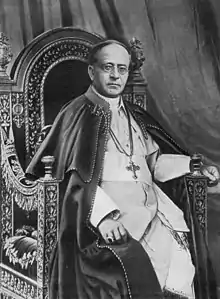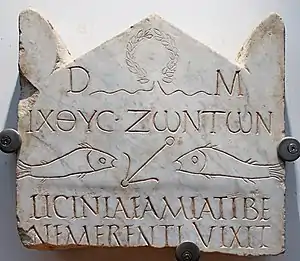
| Part of a series on |
| Christianity |
|---|
 |
| Part of a series on |
| History of religions |
|---|
The history of Christianity concerns the Christian religion, Christian countries, and the Christians with their various denominations, from the first century to the present.
Christianity originated with the ministry of Jesus, a Jewish teacher and healer who proclaimed the imminent Kingdom of God and was crucified c. AD 30–33 in Jerusalem in the Roman province of Judea.[1] The earliest followers of Jesus were apocalyptic Jewish Christians.[1] Christianity remained a Jewish sect for centuries in some locations, diverging gradually from Judaism over doctrinal, social and historical differences.[2]
The religious movement spread as a grassroots movement that became established by the third century.[3][4][5][6] The Roman Emperor Constantine I became the first Christian emperor and in 313, he issued the Edict of Milan expressing tolerance for all religions thereby legalizing Christian worship.[7] Various Christological debates about the human and divine nature of Jesus occupied the Christian Church for three centuries, and seven ecumenical councils were called to resolve them.[8]
Christianity played a prominent role in the development of Western civilization in Europe after the Fall of Rome.[9][10][11][12][13] In the Early Middle Ages, missionary activities spread Christianity towards the west and the north.[14] During the High Middle Ages, Eastern and Western Christianity grew apart, leading to the East–West Schism of 1054. Growing criticism of the Roman Catholic church and its corruption in the Late Middle Ages led to the Protestant Reformation and its related reform movements, which concluded with the European wars of religion, the development of tolerance as policy, and the Age of Enlightenment.[15][16][17]
In the twenty-first century, Christianity has declined in the West, developed new forms and expanded throughout the world.[18] Today, there are more than two billion Christians worldwide and Christianity has become the world's largest,[18] and most widespread religion.[19] Within the last century, the center of growth has shifted from West to East and from North to the global South.[20][21][22][23]
Origins to 312
Jesus
Christianity began in Judea with the itinerant preaching and teaching of a young Jewish man, Jesus of Nazareth. Theologian and minister Frances M. Young has written, it is "The death of Jesus by crucifixion, together with his resurrection from the dead, [that] lies at the heart of Christianity."[24] According to the Gospels, Jesus is the Son of God, who was crucified c. AD 30–33 in Jerusalem.[1] His followers believed that he was raised from the dead and exalted by God, heralding the coming Kingdom of God.[1]
Amy-Jill Levine says "there is a consensus of sorts on the basic outline of Jesus' life. Most scholars agree that Jesus was baptized by John, debated with fellow Jews on how best to live according to God’s will, engaged in healings and exorcisms, taught in parables, gathered male and female followers in Galilee, went to Jerusalem, and was crucified by Roman soldiers during the governorship of Pontius Pilate (26–36 CE)".[25][note 1]
Virtually all scholars of antiquity accept that Jesus was a historical figure.[33][note 2] However, in the twenty-first century, tensions surround the figure of Jesus and the supernatural features of the gospels, creating, for many, a distinction between the ‘Jesus of history’ and the ‘Christ of faith’.[37][note 3] Yet, as Young has observed, "it is precisely Christology, the dogmas concerning the divinity and humanity of Christ, which have made Christianity what it is".[39]
Political, social and religious setting
Christianity began in Jerusalem, in first-century Judea of the Roman Empire, amongst a small group of Jews who looked for a future "anointed" leader (messiah or king) from the ancestral line of King David.[40][1] The religious, social, and political climate of the area was diverse and often characterized by turmoil.[1][41][42]
Roman Empire
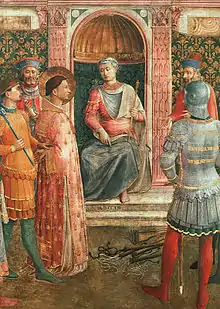
The Christian gospel came into a Roman Empire which had only recently emerged from a long series of civil wars, and which would experience two more major periods of civil war over the next centuries.[43] Romans of this era feared civil disorder, giving their highest regard to peace, harmony and order.[44] Piety equaled loyalty to family, class, city and emperor, and it was demonstrated by loyalty to the practices and rituals of the old religious ways, not by the individual faith of Christianity.[45]
While Christianity was largely tolerated, some also saw it as a threat to "Romanness" which produced localized persecution by mobs and governors.[46][47] In 250, Decius made it a capital offence to refuse to make sacrifices to Roman gods resulting in widespread persecution of Christians.[48][49] Valerian pursued similar policies later that decade. The last and most severe official persecution, the Diocletianic Persecution, took place in 303–311.[50]
Jews and Gentiles
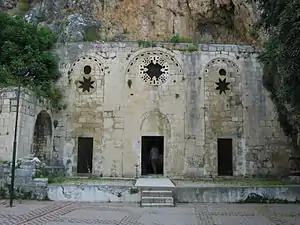
Christianity originated as a sect of apocalyptic Jewish Christians within Second Temple Judaism.[1][52] While there is evidence supporting the presence of Gentile Christians even in the earliest Christian communities of the New Testament (Acts 10), most early Christians, such as the Ebionites, were actively Jewish.[52] The earliest Christian community in Jerusalem was led by James the Just, brother of Jesus.[53][54] According to Acts 9,[55] they described themselves as "disciples of the Lord" and followers "of the Way", and according to Acts 11,[56] a settled community of disciples at Antioch were the first to be called "Christians".[57][58][59]
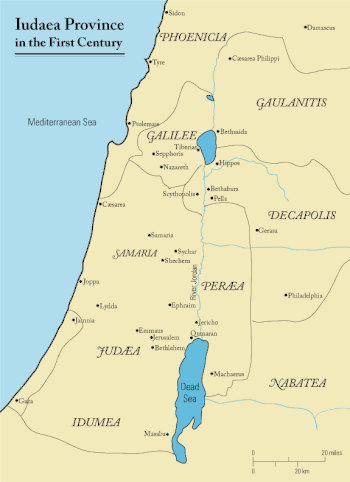
From Jerusalem, Christianity spread into the Jewish diaspora communities outside the Palestinian homeland.[60][note 4] Christianity and Judaism gradually grew apart over doctrinal, social and historical differences.[2]
Mission in primitive Christianity
French evangelical Edmond de Pressensé has written that the Christian church has, from its beginnings, seen itself as having a double mission: first, to fully live out its faith, and second, to pass it on, making Christianity a 'missionary' religion from its inception.[63]
Yet, little is fully known of primitive Christianity.[64] Sources on its first 150 years are fragmentary and scarce.[65] This, along with a variety of complications, have limited scholars to what is probable based largely on the book of Acts whose historicity is debated as much as it is accepted.[66]
Outreach began in the urban landscape of the Roman Empire.[67] Beginning with the Apostles, including Paul, Christianity spread itself geographically, with interaction sometimes producing conflict, and other times producing converts and accommodation.[68][69]
This pattern continued, according to David Abulafia and Nóra Berend, at the borders of civilizations: "a contact zone where an interchange of cultures was constantly taking place".[70] Driven by a universalist logic, missions are a multi-cultural, often complex, historical process.[71]
Geographical spread
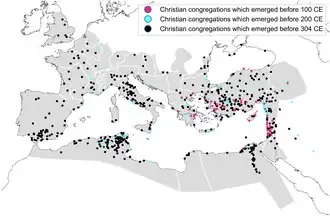
Beginning with less than 1000 people, by the year 100, Christianity had grown to perhaps one hundred small household churches consisting of an average of around seventy (12–200) members each.[72] It achieved critical mass in the hundred years between 150 and 250 when it moved from fewer than 50,000 adherents to over a million.[73] This provided enough adopters for its growth rate to be self-sustaining.[73][74]
Christianity quickly spread beyond the Roman Empire. Armenia, Persia (modern Iraq), Ethiopia, Central Asia, India and China have evidence of early Christian communities.[75] Catholic historian Robert Louis Wilken writes that there is first hand evidence of Christian community in Ceylon (Sri Lanka), and of the Syriac speaking church in Baghdad commissioning a bishop to send to Tibet.[76] Georgia north of Armenia, sent two bishops to the Council of Nicaea in 325.[77]
By the mid-sixth century a merchant-traveler wrote of his discovery of fully formed Christian communities in Malabar on the southwestern coast of India, and on Socotra an island in the Arabian Sea.[78]
Asia Minor and Achaea

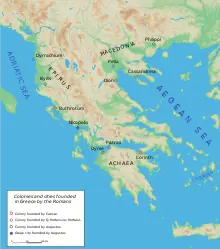
Christine Trevett writes in the Cambridge History of Christianity that "Asia Minor and Achaea were nurseries for Christianity."[79] Christian churches grew in cities with diverse cultures: Athens, Corinth, Ephesus, and Pergamum.[79][note 5] In the second and third centuries, conflicts over Christ's divinity and humanity emerged.[86] Trevett writes that "There was not just Christian diversity but a proud distinctiveness in Asia Minor. Its catholic leaders stood their ground", so that, by the end of the second century, they were forming 'official' statements of ‘orthodox’ Christian belief seeing apostolic teaching as authoritative.[87]
Egypt
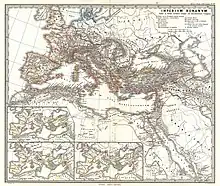
There is no archaeological evidence of Christianity in Egypt before the fourth century, however, Birger Pearson writes that the literary evidence is "massive".[88][note 6] Papyrologist Colin Roberts concludes that the earliest Egyptian ‘Christians’ were not a separate community but were instead part of the Jewish community of Alexandria.[93][note 7]
According to Pearson, Egyptian Christianity began in Alexandria "... probably in the first century".[96] Gnosticism appeared in the second century providing no support for the view that Gnosticism was the earliest form of Christianity in Egypt.[97] Marcionite Christianity came to Alexandria in the mid-second century.[98] Alexandrian Christians like Clement and Origen wrote of the church’s core apostolic faith as the same the world over.[99]
In this early period, Christian religion expanded beyond Alexandria into the interior of Egypt where it was influenced by native Egyptian culture and language. This produced a distinctive Coptic Christianity which is still active in the twenty-first century.[100][note 8]
According to Pearson, "By the end of the third century, the Alexandrian church was at least as influential in the east as the Roman church was in the west".[101]
Syria and Mesopotamia
.svg.png.webp)
Christianity in Antioch is mentioned in Paul's epistles written before 60 AD, and scholars generally see Antioch as a primary center of early Christianity.[102][note 9]
The prophet Mani was born in Persian Mesopotamia in 216, and his religion, Manichaeism, was popular in Syria for some centuries.[105][106]
Christians in this region had little, if any, direct experience with persecution before the fourth century.[107] By the turn of the fourth century, foundation legends had begun to appear. "Most famous was the legendary correspondence between Jesus and king Abgar Ukkama (‘the Black’) of Edessa" writes Harvey.[108]
Gaul
Most of what is known of early Christianity in Gaul comes from the Letter of the churches of Vienne and Lyons concerning the persecution of Christians in the seventeenth year of Marcus Aurelius reign.[109] The letter theologically interprets the detailed suffering and martyrdom of eleven Christians from Vienne and Lyons, although later martyrologies record 49 names.[110]
Irenaeus, who became bishop of Lyons after the martyrdoms, is the most likely author.[111] Behr writes that "Irenaeus describes how, in his early youth, he had known Polycarp, the bishop of the church in Smyrna. This connection with Polycarp was important for Irenaeus: he emphasises that Polycarp had been appointed bishop of Smyrna by the apostles themselves and spoke often about his discussion with John and others who had seen the Lord. Irenaeus thus brought with him to Gaul a living connection with the age of the apostles".[112]
There is nothing more of Christianity in Gaul beyond one inscription until the beginning of the fourth century.[113]
North Africa

.svg.png.webp)
The origins of Christianity in North Africa are unknown, but most scholars connect it to the Jewish communities of Carthage.[114] There were issues of disagreement, but Tertullian and Cyprian both proclaimed the unity of the church.[115]
Christians were persecuted in Africa intermittently from 180 until 305.[116][note 10] Maureen Tilley in the Cambridge History of Christianity writes that in 253, persecution under Valerian (r. 253–9), aimed specifically at high-ranking clergy, began. "Some clergy were sentenced to the imperial mines (Cypr. Ep. 76–9). During the summer of 256, the higher clergy became subject to the death penalty; upper-class men lost their status and property and, if they persisted in the faith, were also executed. Upper-class women were exiled and their property seized (Cypr. Ep. 80)."[118] Persecution under Emperors Decius and Valerian created long-lasting problems for the African church when those who had recanted later tried to rejoin the church.[119]
"In the 290s", according to Tilley, "the military began to execute soldiers, such as Maximilian of Theveste and Marcellus of Tingis, for refusal to serve after conversion".[120]
Rome
According to historian George Edmundson, there is an "enormous" amount of both modern scholarship and controversy on the founding of the church in Rome.[121] It is likely the Christian message arrived in Rome very early.[122] Edmundson writes that an established Christian church already existed in the city of Rome by 57 AD when Paul arrived there.[123] Tradition and evidence support Peter as the founder of the church at Rome.[124]
Markus Vinzent has written that Rome was a melting pot of ideas, and the Christian church there was "fragmented and subject to repeated internal upheavals in the first three centuries [from] controversies imported by immigrants from around the empire".[125] According to Vinzent, this means Walter Bauer’s thesis that heretical forms of Christianity were brought into line by Rome imposing its authority is not supportable, since a powerful, united, Roman church capable of forcing its will on others did not exist before the eighth century.[126][127][128]
Church hierarchy
The New Testament mentions bishops, (Episkopoi), as overseers and presbyters as elders or priests, with deacons as 'servants', demonstrating that the institutional church began its formation very quickly.[129] According to Gerd Theissen, institutionalization began when itinerant preaching transformed into resident leadership (those living in a particular community over which they exercised leadership).[130] A study by Edwin A. Judge, social scientist, shows that a fully organized church system had evolved before Constantine and the Council of Nicea in 325.[4]
New Testament
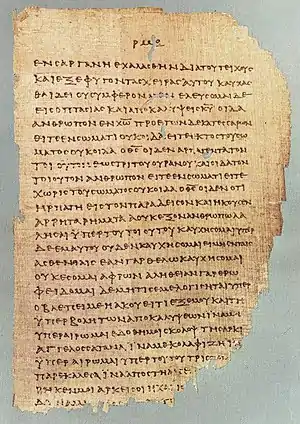
In the first century, new religious texts were written in Greek. These became the "New Testament", and the Hebrew Scriptures became the "Old Testament".[131] Even in the formative period, these texts had considerable authority, and those seen as "scriptural" were generally agreed upon.[132] Linguistics scholar Stanley E. Porter says "the text of [most of] the Greek New Testament was relatively well established and fixed by the time of the second and third centuries".[133]
When discussion of canonization began, there were disputes over whether or not to include some texts.[134][135] The list of accepted books was established by the Council of Rome in 382, followed by those of Hippo in 393 and Carthage in 397.[136]
Spanning two millennia, the Bible has become one of the most influential works ever written, having contributed to the formation of Western law, art, literature, literacy and education.[137][138]
Church fathers
The earliest orthodox writers of the first and second centuries, outside the writers of the New Testament itself, were first called the Apostolic Fathers in the sixth century.[139] The title "Church Father" is used by the church to describe those who were the intellectual and spiritual teachers, leaders and philosophers of early Christianity.[140] Writing from the first century to the close of the eighth, they defended their faith, wrote commentaries and sermons, recorded the Creeds and church history, and lived exemplary lives.[141]
Early Beliefs and practices

Early Christian communities were highly inclusive in terms of social stratification and other social categories.[142] Paul's understanding of the innate paradox of an all powerful Christ dying as a powerless man created a new understanding of power and a new social order unprecedented in classical society.[143] Historian Raymond Van Dam says conversion produced "a fundamental reorganization in the ways people thought about themselves and others".[144] Heterogeneity characterized the groups formed by Paul the Apostle, and the role of women was much greater than in any of the forms of Judaism or paganism in existence at the time.[145][146]
Christianity was experienced as a new start, and was open to both men and women, rich and poor. Baptism was free. There were no fees, and it was intellectually egalitarian, making philosophy and ethics available to ordinary people including those who might have lacked literacy.[147] New Testament scholar N. T. Wright argues that these ideas and practices were revolutionary to the classical world.[148]
Christianity in its first 300 years was also highly exclusive.[149] Believing was the crucial and defining characteristic that set a "high boundary" that strongly excluded the "unbeliever".[149] In Daniel Praet's view, the exclusivity of Christian monotheism formed an important part of its success, enabling it to maintain its independence in a society that syncretized religion.[150]
Prior to Christianity, the wealthy elite of Rome mostly donated to civic programs designed to elevate their status.[151][152][153] Christians, on the other hand, offered last rites to the dying, buried them, distributed bread to the hungry, and showed the poor great generosity.[154][155][note 11]
An important cultural shift took place in the way Christians buried one another: they gathered unrelated Christians into a common burial space, then "commemorated them with homogeneous memorials and expanded the commemorative audience to the entire local community of coreligionists" thereby redefining the concept of family.[156][157]
Classics scholar Kyle Harper says "Christianity not only drove profound cultural change, it created a new relationship between sexual morality and society... [replacing the] ancient system where social and political status, power, and the transmission of social inequality to the next generation scripted the terms of sexual morality. ...There are risks in over-estimating the change in old patterns Christianity was able to begin bringing about; but there are risks, too, in underestimating Christianization as a watershed".[158]
Heresey and orthodoxy
Emerging Christianity embraced some theological, ecclesiological and regional diversity, but ‘insider-outsider’ boundaries were still being determined in this period.[159] ‘Orthodoxy’ was not the exclusive property of one group, and many of the ideas in Gnostic or New Prophecy/Montanist or Marcionite teachings overlapped traditional views.[160] Defining ‘orthodoxy,’ therefore, took time.[161] According to Christine Trevett, this makes it questionable whether orthodoxy and heresy can even be spoken of, before the council of Nicaea, as real categories of thought.[159]
The earliest writers emphasized the unity of Christianity and 'core beliefs' based on apostolic authority.[115][162][163][164]
Late antiquity to Early Medieval Christianity (313 – c. 600)
In the fourth and fifth centuries Rome faced unsolvable problems at all levels of society.[165] Barbarians attacked Rome, invaded Britain, France and Spain, seized land, and disrupted the empire's economy. Roman Senators still collected rent, sometimes doubling the fees, while Matthews and Platt say the church used crisis to stamp out heresy and offer "shelter to the homeless, food for the hungry, and comfort to the grieving".[166] After the political fall of the western Roman Empire in 476 AD, the Christian church replaced Empire as the unifying influence in Europe, and western civilization's center began shifting from the Mediterranean basin to the continent of Europe.[167]
Influence of Constantine
Averil Cameron writes that, "The reign of Constantine ... was momentous for Christianity".[168] The Roman Emperor Constantine I became the first Christian emperor in 313, (though he did not become sole emperor until after defeating Licinius the emperor in the East in 324).[169] In 313, Constantine issued the Edict of Milan, (which had been the policy of Licinius), expressing tolerance for all religions, thereby legalizing Christian worship.[169] Christianity did not become the official religion of the empire under Constantine, but the steps he took to support and protect it were vitally important in the history of Christianity.[170]
He established equal footing for Christian clergy by granting them the same immunities pagan priests had long enjoyed.[170] He gave bishops judicial power. [171] By intervening in church disputes, he initiated a precedent.[172][173][note 12] He wrote laws that favored Christianity,[174][172] and he personally endowed Christians with gifts of money, land and government positions.[175][176] Instead of rejecting state authority, bishops were grateful, and this change in attitude proved to be critical to the further growth of the church.[171]
Constantine's church building was influential in the spread of Christianity.[171] He devoted imperial and public funds, endowed his churches with wealth and lands, and provided revenue for their clergy and upkeep.[177] Cameron explains that, "In a sense he was simply following the example set by his pagan predecessors ... Nevertheless his activities set a pattern for others, and by the end of the fourth century every self-respecting city, however small, had at least one church".[177]
Cameron concludes that Constantine brought the Christian church and the Roman state together "in a completely new way, and in this his reign was fundamental for subsequent history".[178]
Regional developments
Germanic Christianity
The integration of barbarian people into the Roman world of the fourth century transformed both Romans and barbarians. Beginning with the Goths around 369, various Germanic people adopted Christianity, and began to form into the distinct ethnic groups that would become the future nations of Europe.[179][180][181] At least one historian of the time, Orosius, wrote that conversion made the barbarians milder and set limits on their "savagery".[182] In all cases, Christianization meant "the Germanic conquerors lost their native languages" as these languages became Latinized.[183]
Visigothic Spain
In 416, the Germanic Visigoths had crossed into Hispania as Roman allies.[184] An important shift took place in 612 when the Visigothic King Sisebut declared the obligatory conversion of all Jews in Spain, contradicting Pope Gregory who had reiterated the traditional ban against forced conversion of the Jews in 591.[185] Scholars refer to this shift as a "seismic moment" in Christian history.[186]
Byzantium
The fall of the Western Roman Empire in 476 had little direct impact on the Eastern Roman Empire. Called Byzantine because Constantinople was founded on the site of the ancient city of Byzantium, the East became the Byzantine Empire with an "autocratic government, stable farm economy, Greek intellectual heritage and ... Orthodox Christianity". It had great wealth and economic resources which enabled it to survive until 1453.[187]
Justinian I and Eastern influence in the West

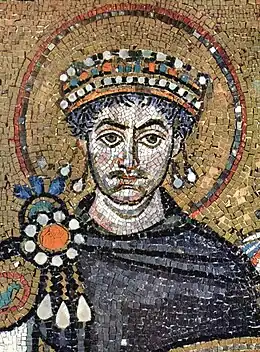
In the sixth century, the Byzantine Emperor Justinian I, attempted to reunite east and west by taking over both territory and the church. From the late seventh to the middle of the eighth century, Popes had to be approved by the Byzantine emperor before they could be installed. This resulted in the Byzantine papacy when eleven of the thirteen men who held the position of Roman Pope were Eastern.[188] Along with losses to Islam and changes within Christianity itself, this helped put an end to Ancient Christianity transforming it into its eclectic medieval forms.[189][190][191][192][193]
Jews, pagans and heretics
Jews and supersessionism
In the fourth century, Augustine argued that the Jewish people should not be forcibly converted or killed, but that they should be left alone. According to Anna Sapir Abulafia, most scholars agree that Jews and Christians in Latin Christendom lived in relative peace with one another until the thirteenth century.[194][195] In these earlier centuries, scattered violence toward Jews occasionally took place during riots led by mobs, local leaders, and lower level clergy without the support of church leaders who generally followed Augustine's teachings.[196][197]
Sometime before the fifth century, the church had taken its universally held traditional interpretation of Revelation 20:4–6 called (Millennialism), (the hope of the thousand-year reign of the Messiah on earth, centered in Jerusalem, ruling with the redeemed Israel), and augmented it with supersessionism (an allegorized version which sees the church as the metaphorical Israel in place of the Jews). Supersessionism has never been an official or a universal doctrine, but has been a part of Christian thought through much of history.[198][199] Many Jewish writers trace anti-semitism (and its consequences in World War II), to this doctrine.[200][201]
Pagans
Constantine ruled for 31 years and never outlawed paganism.[202][203] What he did do, according to Bradbury, was confiscate temple hoards of gold and silver to finance his building projects and establish a stable currency. On a few occasions, he confiscated temple land.[204] He refused to personally support pagan beliefs while also speaking out against them.[205] He forbade pagan sacrifices and closed temples that continued to offer them.[202]
Blood sacrifice was the element of pagan culture most abhorrent to Christians, though Christian emperors often tolerated other pagan practices.[206][207] Constantine authored several laws that threatened and menaced any who continued to practice sacrifice.[208][209] Peter Brown notes that the language of the anti-sacrifice laws "was uniformly vehement", and the "penalties they proposed were frequently horrifying", evidencing the intent of terrorizing the populace into acceptance.[210]
There is no evidence of any of the horrific punishments ever being enacted.[211] There is no record of anyone being executed for violating religious laws before Tiberius II Constantine at the end of the sixth century (574–582).[212] Still, sacrifice, a common practice in nearly all nations of the world prior to this, largely disappeared from the cities of the Roman Empire by the mid fourth century.[206]
Eusebius, in his church history, writes that Constantine campaigned against the temples as well as sacrifice, however, there are discrepancies in the evidence.[213] Temple destruction is attested to in 43 cases in the written sources, but only four have been confirmed by archaeological evidence.[214]
Trombley and MacMullen explain it is common for discrepancies between ancient literary sources and archaeological evidence to exist.[215][216] At the sacred oak and spring at Mamre, a site venerated and occupied by Jews, Christians, and pagans alike, the literature says Constantine ordered the burning of the idols, the destruction of the altar, and erection of a church on the spot of the temple.[217] The archaeology of the site shows that Constantine's church, along with its attendant buildings, occupied a peripheral sector of the precinct leaving the rest unhindered.[218][note 13]
Constantine was vigorous in reclaiming confiscated properties for the church, whenever these issues were brought to his attention, and he used reclamation to justify the destruction of some pagan temples such as Aphrodite's temple in Jerusalem. For the most part, Constantine simply neglected them.[221][222][223][note 14]
According to Peter Brown, Constantine's conversion meant that, as far as paganism was concerned, "everything was done but the sweeping up": except for a few instances, "In most areas, polytheists were not molested", they were simply ignored.[231][232] Fourth century Christians focused on heresy as the higher priority.[233][234]
Christianity as a state religion
The first countries to make Christianity their state religion were Armenia (301), Georgia (fourth century), Ethiopia and Eritrea in 325.[235][236][237]
If, and when, the Roman Empire might have officially made Christianity its state religion continues to be debated. Substantial growth in the third and fourth centuries made Christianity the majority religion by the mid-fourth century, and after Constantine until the Fall of Empire, all emperors were Christian except Julian. Christian Emperors wanted the empire to become a Christian empire.[238]
According to Bart Ehrman biblical scholar, the first Christian emperor "Constantine did not make Christianity the one official and viable religion. He made it a licit religion..."[239] Of those that followed Constantine, historian Michele Renee Salzman has written that "When the Theodosian Code was published in 438, no emperor had as yet legislated enforced conversion... no emperor was willing to legalize the enforced conversion of pagans until [the Eastern emperor] Justinian in A.D. 529" - 50 years after the Western Empire had been lost to "barbarians".[240]
In the centuries following his death, Roman Emperor Theodosius I (347–395) was acclaimed, by the Christian literary tradition, as the emperor who destroyed paganism and established Nicene Christianity as the official religion of the empire.[note 15] According to Ramsay MacMullen, Alan Cameron and most twenty-first century scholars, this is a distortion created by orthodox Christian authors as part of their war with the Arians.[248][249][250][251]
R. Malcolm Errington looked for evidence among the reactions to imperial law by Christian and non-Christian historians and commentators who wrote during and following the publication of the Theodosian Code of 438.[252] Errington writes that they were almost universally unaware of the existence - or any impact - of these laws, "even about rulings such as Cunctos Populos or Episcopis Tradi which in modern times have been stylized into turning points in the history of Christianity".[253]
Errington concludes that none of the imperial laws made a noticeable contribution to establishing Christian Orthodoxy in the west.[253] Nor did Theodosius ever see himself, or advertise himself, "as a destroyer of the old cults" writes Mark Hebblewhite in his 2020 biography of Theodosius.[254][255] Paganism did not end with Theodosius, though it had been gradually declining in popularity since the second century BC.[256][257][258]
First ecumenical councils

During Antiquity, the Eastern church produced multiple doctrinal controversies and the first ecumenical councils were convened to deal with them.[259]
The first was between Arianism, (which said the divine nature of Jesus was not equal to the Father's), and orthodox trinitarianism which says they are equal. Arianism spread throughout most of the Roman Empire from the fourth century onwards.[260] The First Council of Nicaea (325) and the First Council of Constantinople (381) resulted in a condemnation of Arian teachings and produced the Nicene Creed.[260][261]
The Third, Fourth, Fifth and Sixth ecumenical councils are all characterized by attempts to define the human and divine nature of Jesus.[262] One such attempt created the Nestorian controversy, then schism, then a communion of churches, including the Armenian, Assyrian, and Egyptian churches, resulting in what is today known as Oriental Orthodoxy.[263][264][265]
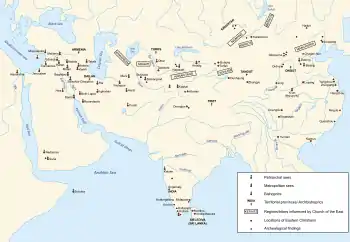
Beliefs and practices
Triumph
While maintaining an apostolic set of core beliefs, and arguing with those who didn't, Christians of the fourth century also promulgated a universal belief that Constantine's conversion was evidence the Christian God had conquered the pagan gods in Heaven.[266][267] This "triumph of Christianity" became the primary narrative of the fourth century, even though Christians were still a minority in the population.[268][269][270]
Monasticism and hospitals for the poor
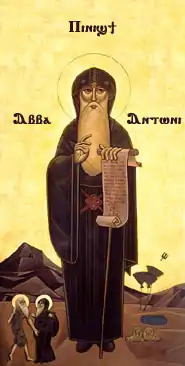
Christian monasticism emerged in the third century, and by the fifth century, was a dominant force in all areas of late antique culture.[271][note 16]
Monastics developed a health care system which allowed the sick to remain within the monastery as a special class afforded special benefits and care.[277] This destigmatized illness and formed the basis for future public health care. The first public hospital (the Basiliad) was founded by Basil the Great in 369.[278]
Central figures in the development of monasticism were Basil in the East and, in the West, Benedict, who created the Rule of Saint Benedict, which would become the most common rule throughout the Middle Ages and the starting point for other monastic rules.[279]
Early to High Middle Ages (c. 600 – c. 1100)
With few exceptions, most organized societies c.600, called themselves Christian if they were headed by Christian leaders, not because populations were fully converted.[280] According to Matthews and Platt, the Middle Ages united classical Graeco-Roman thinking, Germanic energy, and Christian ethos into a new civilization centered in Europe where church and state were inseparably mixed. [281][282]
The Age of the monk
Historian Geoffrey Blainey writes that the Catholic Church in the period between the Fall of Rome (476 C.E.) and the rise of the Carolingian Franks (750 C.E.) was like an early version of a welfare state. "It conducted hospitals for the old and orphanages for the young; hospices for the sick of all ages; places for the lepers; and hostels or inns where pilgrims could buy a cheap bed and meal". It supplied food to the population during famine and distributed food to the poor.[283][284]
Monasteries preserved classical craft and artistic skills while maintaining intellectual culture within their schools, scriptoria and libraries. As well as providing a focus for spiritual life, they functioned as agricultural, economic and production centers, particularly in remote regions.[285]
Medieval monasteries were models of productivity and economic resourcefulness, teaching their local communities animal husbandry, cheese making, wine making, and various other skills.[286] Medical practice was highly important and medieval monasteries are best known for their contributions to medical tradition. They also made advances in sciences such as astronomy, and St. Benedict's Rule (480–543) impacted politics and law.[284][287]
The formation of these organized bodies of believers distinct from political and familial authority, especially for women, gradually carved out a series of social spaces with some amount of independence thereby revolutionizing social history.[288]
Western missionary expansion
After the Fall of Rome in the late fifth century, the church gradually replaced the Roman Empire as the unifying force in Europe, providing what security there was, actively preserving ancient texts and literacy.[289][290]
Pope Celestine I (422–430) sent Palladius to be the first bishop to the Irish in 431. In 432, Gaul supported St Patrick as he began his mission there.[291] Relying largely on recent archaeological developments, Lorcan Harney has reported to the Royal Academy that the missionaries and traders who came to Ireland in the fifth to sixth centuries were not backed by any military force.[291]
Archaeology indicates Christianity had become an established minority faith in some parts of Britain by the fourth century. It was largely mainstream, and in certain areas, was continuous.[292] Irish missionaries led by Saint Columba, went to Iona (from 563), and converted many Picts.[293] The court of Anglo-Saxon Northumbria, and the Gregorian mission who landed in 596 sent by Pope Gregory I and led by Augustine of Canterbury, did the same for the Kingdom of Kent.[294]
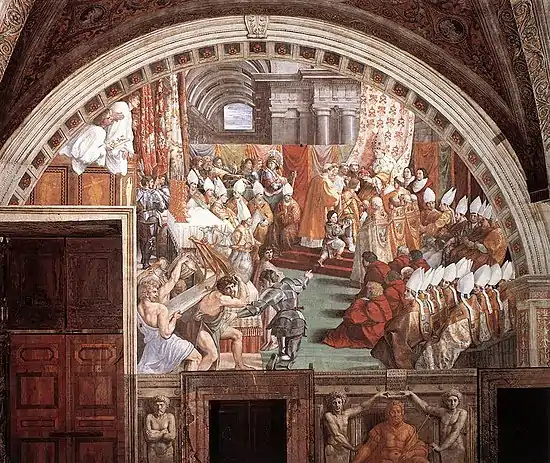
The Franks first appear in the historical record in the 3rd century. The Frankish King Clovis I converted from Paganism to Roman Catholicism c.498-508, becoming the first to unite all of the Frankish tribes under one ruler.[295][296][note 17]
Clovis' descendent Charlemagne began the Carolingian Renaissance, a period of intellectual and cultural revival of literature, arts, and scriptural studies, a renovation of law and the courts, and the promotion of literacy.[305] Charlemagne founded schools and attracted the most learned men from all of Europe to his court. They had many accomplishments including the development of lower case letters called Carolingian minuscule.[306]
Eastern Christianities (604–1071)
Brown has written that the "Church of the East" within the Persian/Sasanian Empire encompassed modern Iraq, Iran, and parts of Central Asia.[307] The shattering of the Sassanian Empire in the early 600's led upper-class refugees to move further east to China, entering Hsian-fu in 635.[308]
Byzantine Orthodoxy
By the time of Justinian I (527–565), "With a population of over half a million, Constantinople had become overwhelmingly the largest city in the Mediterranean and the Middle East ... the preeminent model for earthly power at its most ebullient, formidable, and God-fearing" writes Peter Brown.[309]
Following a series of heavy military reversals against the Muslims, Iconoclasm emerged within the provinces of the Byzantine Empire in the early 8th century. In the 720s, the Byzantine Emperor Leo III the Isaurian banned the pictorial representation of Christ, saints, and biblical scenes. In the Latin West, Pope Gregory III held two synods at Rome and condemned Leo's actions. The iconoclastic movement destroyed much of the Christian Church's early artistic history.[310]

Africa
The kingdom of Axum, in Ethiopia became Christian around 340.[311] Up to 570, the kingdom of Himyar (in modern Yemen) was Jewish, but the kingdom itself had Christian rulers supported by military power from the highlands of Ethiopia. [311]
Slavic Christianities
Throughout central and eastern Europe, the Balkan Peninsula[note 18], and the area north of the Danube[note 19], Christianization and political centralization went hand in hand.[312][313] Local elites wanted to convert because they gained prestige and power through matrimonial alliances and participation in imperial rituals.[314][note 20]

Significant missionary activity in this region only took place after Charlemagne defeated the Avar Khaganate.[315] Two Byzantine brothers, Saints Constantine-Cyril and Methodius, played the key missionary roles in spreading Christianity to Bohemia, Moravia and Slovakia territories beginning in 863.[316] They spent approximately 40 months in Great Moravia continuously translating texts, teaching students, and developing the first Slavic alphabet while translating the Gospel into the Old Church Slavonic language.[317][318] Old Church Slavonic became the first literary language of the Slavs and, eventually, the educational foundation for all Slavic nations.[317]
Rise of universities
Modern western universities have their origins directly in the Medieval Church.[319][320][321] The earliest were the University of Bologna (1088), the University of Oxford (1096), and the University of Paris where the faculty was of international renown (c. 1150).[322][323] Matthews and Platt say "these were the first Western schools of higher education since the sixth century".[324]
They began as cathedral schools then formed into self-governing corporations with charters.[324] Students were considered clerics.[325] This was a benefit that imparted legal immunities and protections. Schools were divided into faculties which specialized in law, medicine, theology or liberal arts (largely devoted to Aristotle), awarded degrees and held the famous quodlibeta theological debates amongst faculty and students.[324][326]
Western Europe (c. 1100 – c. 1500)
Christianity of the Middle Ages was a complex and diverse mix of cultures.[327] The intense and rapid changes of this period from its beginning reform to the power and corruption at its close are considered some of the most significant in the history of Christianity.[328]
Monastic reform
In the early part of this period, the church had immense authority. The key to its power were three monastic reformation movements that swept Europe.[329][330] Prior to this, the church had become riddled with corruption and disregard for the sacraments.[331]
Owing to its stricter adherence to the reformed Benedictine rule, the Abbey of Cluny, established in 910, became the leading centre of Western monasticism from the later tenth century, revitalizing the Norman church into the early twelfth century.[332][328]
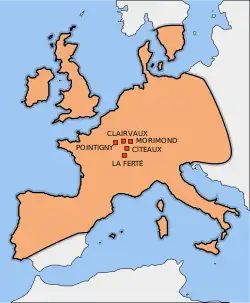
The Cistercian movement was inspired to live a literal observance of the Benedictine rule by Bernard of Clairvaux who founded the order in 1098 at Cîteaux Abbey. As the second wave of reform, they became a primary force of technological advancement and diffusion in medieval Europe.[333]
Beginning in the twelfth century, the pastoral Franciscan Order was instituted by the followers of Francis of Assisi; later, the Dominican Order was begun by St. Dominic. Called Mendicant orders, they represented a change in understanding a monk's calling as contemplative, instead seeing it as a call to actively reform the world through preaching, missionary activity, and education.[334][335]
This new calling to reform the world led the Dominicans to dominate the new universities, travel about preaching against heresy, and to participate in the Medieval Inquisition, the Albigensian Crusade and the Northern crusades.[336] Christian policy denying the existence of witches and witchcraft would later be challenged by the Dominicans allowing them to participate in witch trials.[337][338]
Christian beliefs and practices
| Part of a series on |
| Christian mysticism |
|---|
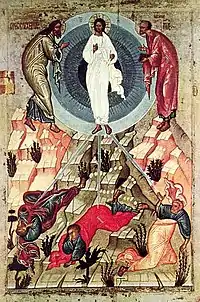 |
Medieval people believed that participating in the sacraments, and upholding church ceremony and morality, granted them access to Heaven.[339] The seven sacraments were the outward manifestation of God's grace: baptism, confirmation, the Eucharist, penance, marriage, last rights and ordination for priests.[340] Confession and penance became widespread from the eleventh century, and by 1300, were an integral part of both ritual and belief.[333]
The Gregorian Reform established new law requiring the consent of both parties before a marriage could be performed, a minimum age for marriage, and codified marriage as a sacrament.[341][342] That made the union a binding contract, making abandonment prosecutable with dissolution of marriage overseen by Church authorities.[343] Although the Church abandoned tradition to allow women the same rights as men to dissolve a marriage, in practice men were granted dissolutions more frequently than women.[344][345]
Throughout the Middle Ages, abbesses and female superiors of monastic houses were powerful figures whose influence could rival that of male bishops and abbots.[346][347]

The veneration of Mary developed within the monasteries in western medieval Europe.[348] Rachel Fulton writes that medieval European Christians praised Mary for making God tangible.[349][note 21]
Christian mysticism abounded in the Middle Ages, particularly among nuns and monks, inspiring believers to transcend the material realm.[351]
Christopher Ocker writes concerning belief about the Bible that,
All people interested in Scripture must have agreed that its function was identical to the spiritual purpose of the church – gradually restoring human beings to an ideal form of life, salvation. Yet so benevolently disguised, the Bible could infiltrate and unsettle any region of late medieval Europe’s cultural worlds".[352]
Scholars of the Renaissance created textual criticism which revealed writing errors by medieval monks and exposed the Donation of Constantine as a forgery. Popes of the Middle Ages had depended upon the document to prove their political authority.[353]

The church became a leading patron of art and architecture and commissioned and supported such artists as Michelangelo, Brunelleschi, Bramante, Raphael, Fra Angelico, Donatello, and Leonardo da Vinci.[354]
Catholic monks developed the first forms of modern Western musical notation leading to the development of classical music and all its derivatives.[355]
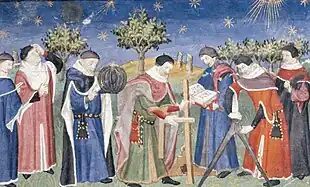
Between 1150 and 1200, Christian scholars traveled to formerly Moslem locations in Sicily and Spain, where Islamists had left behind their libraries. They went to retrieve the writings of Aristotle, which had been lost to the West after the Fall of the Western Roman Empire, but had been preserved in the East.
Insights gained from Aristotle triggered a period of cultural ferment that Matthews and Platt say, one "modern historian has called the twelfth century renaissance".[324] Historians of science David C. Lindberg, Ronald Numbers and Edward Grant have described what followed as a "medieval scientific revival".[356] For example, Bishop Robert Grosseteste devised the first scientific method using hypothesis, mathematics and testing.[357] Science historians, including Noah Efron, therefore give credit to multiple medieval Christian scientists for providing the early "tenets, methods, and institutions of what in time became modern science".[358][359][360][361]
Centralization and the beginnings of monarchial absolutism (c. 1100)
By 1150, western kings were becoming more secular, focusing first on their own nation-states rather than the church.[336] The twelfth century state centralized legal, military, and social power into itself by attacking the older, local, kinship-based systems.[362] They did this by redefining being a member of a minority (such as being Jewish or homosexual) as being a threat to the social order. The state then used stereotyping, propaganda, and legal prosecution by inquisition, to legitimize the state's right to take power to protect itself.[362][note 22]
Moore writes that persecution became a functional tool of power and a core element in the social and political development of Western society.[372][373][374] By the 1300s, segregation and discrimination in law, politics, and the economy, had become the established methods for keeping civil order in all European states.[375][367][376]
The church did not have the leading role in this but did have a part in it through new canon law.[377][378][379] According to the Oxford Companion to Christian Thought, during this period, the religion that had begun by decrying the role of law as less than that of grace and love (Romans 7:6) developed the most complex religious law the world has ever seen, and in it, Christianity's concepts of equity and universality were largely overlooked.[380]
By the 14th century, most bishops and Popes were trained lawyers rather than theologians.[380]
Law
Canon law of the Catholic Church (Latin: jus canonicum)[381] was the first modern Western legal system, and is the oldest continuously functioning legal system in the West,[382] predating European common law and civil law traditions.[383] Justinian I's reforms had a clear effect on the evolution of jurisprudence, and Leo III's Ecloga influenced the formation of legal institutions in the Slavic world.[384]
Growing power and repression
The church wanted the kind of power secular kings were gaining and soon followed their example. The popes of the fourteenth century worked to amass power into the papal position, building what is called the papal monarchy. The pope became a pseudo-monarch who governed church-owned property in the same manner as the secular powers.[386][387]
Fourteenth century popes were greedy and politically corrupt, so that pious Christians of the period became disgusted, leading to the loss of papal prestige.[386][388] Devoted and virtuous nuns and monks became increasingly rare. Monastic reform, which had been a major force in the High Middle Ages, is largely unknown in the Late Middle Ages.[389]
Avignon Papacy and the Western Schism
In 1309, Pope Clement V moved to Avignon in southern France in search of relief from Rome's factional politics.[386] Seven popes resided there in the Avignon Papacy until 1378.[390] In 1377 Pope Gregory XI returned to Rome. After his death, the papal conclave met in 1378 in Rome and elected an Italian Urban VI to succeed Gregory.[386] The French cardinals did not approve. They held a second conclave electing Robert of Geneva instead. This began the Western Schism.[391][386]
In 1409, the Pisan council saw no resolution and called for the resignation of the two Popes, electing a third to replace them both. They refused, leaving the church with three popes. Five years later, the Holy Roman Emperor called the Council of Constance (1414–1418) which resolved the conflict by electing Pope Martin V to replace the others.[386]
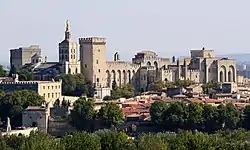
In 1418, the Papacy consolidated and focused on the pursuit of power.[354] During this time, elite Italian families used their wealth to secure episcopal offices which led to individuals like Pope Alexander VI and Pope Sixtus IV who were known for ignoring the moral requirements of their position. Pontiffs such as Julius II spent lavishly to pursue personal grievances, private luxuries and public works.[392]
Medieval Inquisition
The Medieval Inquisition, including the Episcopal Inquisition (1184–1230) and the later Papal Inquisition (1230s–1240s), was a type of criminal court established from around 1184 and run by the Roman Catholic Church, and local secular leaders dealing largely, but not exclusively, with religious issues such as heresy.[393] Local law delivered the accused to the court, sometimes using torture for interrogation, while religious inquisitors stood by as recording witnesses.[394]
Inquisition was not a unified institution.[395][396] Jurisdiction was local, limited, and lack of support and opposition often obstructed it.[395] Inquisition was contested stridently, in and outside the church. Opponents charged heresy inquisitions with proving the Roman church was "unchristian" and "a destroyer of its gospel legacy, or even the real enemy of Christ".[397] Many parts of Europe had erratic inquisitions or none at all.[395]
Criticism of the Catholic Church's abuses and corruption

People living during the fourteenth century experienced plague, famine and war that ravaged most of the continent; there was social unrest, urban riots, peasant revolts and renegade feudal armies, and this was in addition to the religious changes often forced upon them by their new national monarchies. They faced all of this with a church unable to provide much moral leadership as a result of its own internal conflict and corruption.[398]
John Wycliffe (1320–1384) was an English scholastic philosopher, a Christian theologian, and a precursor of the Protestant Reformation.[399] Emphasizing the supremacy of the Bible, he urged the church to give up its property (which produced much of the church's wealth), and to once again embrace poverty and simplicity, to stop being subservient to the state and its politics, and he denied papal authority.[400][399] The Lollards followed his teachings, played a role in the English Reformation, and were persecuted after Wycliff's death.[399]
Jan Hus (1369–1415), a Czech Christian theologian based in Prague, was influenced by Wycliffe and spoke out against the abuses and corruption he saw in the Catholic Church there.[401] Hus was a forerunner of the Protestant Reformation who became a powerful symbol of Czech nationalism and the impetus for the Bohemian/Czech and German Reformations.[402][403][401][399]
Although Wycliffe died of ill health before it could be implemented, both Wycliffe and Hus were accused of heresy and subsequently condemned to the death penalty for their outspoken views.[404][401][399]
Church militant
The Rise of Islam

The rise of Islam (600 to 1517) unleashed a series of military campaigns that conquered Syria, Mesopotamia, Egypt and Persia by 650, adding North Africa and most of Spain by 740. Only the Franks and Constantinople were able to withstand this medieval juggernaut. Historians Matthews and Platt have written that, "At its height, the Arab Empire stretched from the Indus River and the borders of China in the East, to the Atlantic in the West, and from the Taurus mountains in the North to the Sahara in the South... Islam was the colossus of the Middle Ages".[405] [note 23][note 24]
Crusades

After 1071, when the Seljuk Turks closed Christian pilgrimages and defeated the Byzantines at Manzikert, the Emperor Alexius I asked for aid from Pope Urban II. Jaroslav Folda writes in The Oxford Illustrated History of the Crusades that Urban II responded by calling upon the knights of Christendom at the Council of Clermont on 27 November 1095, to "go to the aid of their brethren in the Holy Land and to liberate the Christian Holy sites from the heathen".[422]
The First Crusade captured Antioch in 1099 and then Jerusalem. The Second Crusade occurred in 1145 when Edessa was taken by Islamic forces. Jerusalem was held until 1187 and the Third Crusade, after battles between Richard the Lionheart and Saladin. The Fourth Crusade, begun by Innocent III in 1202 was subverted by the Venetians. They funded it then ran out of money, and instructed the crusaders to go to Constantinople and get their money back. Crusaders sacked the city and other parts of Asia Minor, established the Latin Empire of Constantinople in Greece and Asia Minor, and contributed to the downfall of the Byzantine Empire. Five numbered crusades to the Holy Land culminated in the siege of Acre of 1219, essentially ending the Western presence in the Holy Land.[423]
The crusades led to the development of national identities in the newly forming European nations, increased division with the East, and produced cultural changes from the exchange of medical knowledge, art and architecture, and increased trade.[424][425]
Investiture controversy
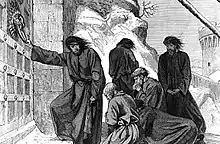
The Investiture controversy was the most significant conflict between secular and religious powers that took place in medieval Europe.[426] It began as a dispute in the 11th century between the Holy Roman Emperor Henry IV and Pope Gregory VII concerning who would appoint bishops (investiture).[427] Ending lay investiture threatened to undercut the power of the Holy Roman Empire and the ambitions of the European nobility. But allowing lay investiture meant the Pope's authority over his own people was limited.[428][note 25] It took "five decades of excommunications, denunciations and mutual depositions...spanning the reign of two emperors and six popes" to settle the controversy in 1122.[431]
A similar controversy occurred in England between King Henry I and St. Anselm, Archbishop of Canterbury, over investiture and episcopal vacancy.[432] The English dispute was resolved by the Concordat of London (1107).[431]
Baltic wars
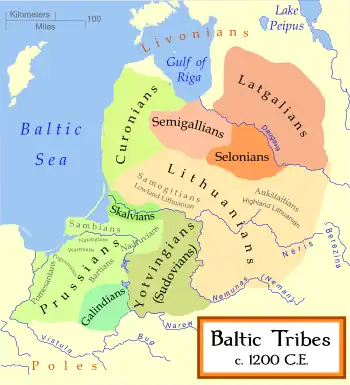
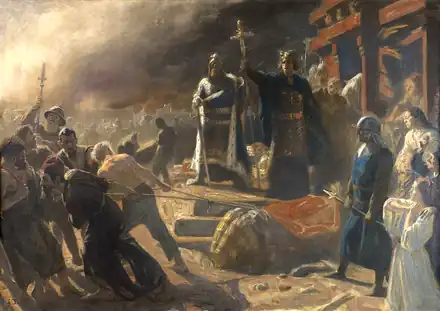
When the Pope (Blessed) Eugenius III (1145–1153) called for a Second Crusade in response to the fall of Edessa in 1144, Saxon nobles in Eastern Europe refused to go.[433] From the days of Charlemagne (747–814), the free barbarian people around the Baltic Sea had raided the countries that surrounded them, stealing crucial resources, killing, and enslaving captives.[434] For the leaders of Eastern European countries that meant subduing the Baltic area was more important to them than going to the Holy land.[433] In 1147, Eugenius' Divini dispensatione, gave the eastern nobles crusade indulgences for the Baltic area.[433][435][436] The Northern, (or Baltic), Crusades followed, taking place, off and on, with and without papal support, from 1147 to 1316.[437][438][439]
These rulers saw holy war as a tool for territorial expansion, alliance building, and the empowerment of their own young church and state.[440] According to Fonnesberg-Schmidt, "While the theologians maintained that conversion should be voluntary, there was a widespread pragmatic acceptance of conversion obtained through political pressure or military coercion".[441] There were often severe consequences for populations that chose to resist.[442][443][444]
Albigensian Crusade

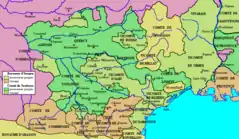
.svg.png.webp)
Cathars, also known as Albigensians, were the largest of the heretic groups that began reappearing in the High Middle Ages. They were concentrated in what was then the independent Languedoc region along the Mediterranean coast that, through this crusade, became southern France.
After decades of having called upon secular rulers for aid in dealing with the Cathars and getting no response,[445] Pope Innocent III and the king of France, Philip Augustus, joined in 1209 in a military campaign that was promulgated as necessary for eliminating the Albigensian heresy.[446][447] Scholars disagree on whether war was determined more by the Pope or by King Philip and his proxies for his own purposes.[448][note 26][note 27]
By the end of the war 16 years later, the campaign no longer had the status of a crusade. Its fighters were not rewarded with dispensations. The army had seized and occupied the lands of nobles who had not sponsored Cathars, but had been in the good graces of the church, which had been unable to protect them. The result of these seizures was that the entire region came under the rule of the French king and became southern France.[456]
Catharism continued for another hundred years (until 1350).[457]
Iberian Reconquista

Between 711 and 718, the Iberian peninsula had been conquered by Muslims in the Umayyad conquest. [note 28] The military struggle to reclaim the peninsula from Muslim rule took place for centuries until the Christian Kingdoms reconquered the Moorish states of Al-Ándalus in 1492.[461]

Isabel and Ferdinand married in 1469, united Spain with themselves as the first king and queen, fought the Muslims in the Reconquista and soon after established the Spanish Inquisition.[462]
During this time, "New Christians" had begun to appear as a socio-religious designation and legal distinction in the Spanish Empire and the Portuguese Empire.[461] Most of the history of the "New Christians" refers to the Jewish converts, who were generally known as Conversos or Marranos,[463] while the Muslim converts were known as Moriscos.[464]
The Spanish inquisition was originally authorized by the Pope in answer to royal fears that Conversos and Muranos were spying and attempting to sabotage the new state. The initial inquisitors proved so severe that the Pope soon opposed it and unsuccessfully attempted to shut it down.[465] Ferdinand is said to have pressured the Pope, and in October 1483, a papal bull conceded control of the inquisition to the Spanish crown.[466] According to Spanish historian José Casanova, the Spanish inquisition became the first truly national, unified and centralized state institution.[467]
Eastern Christianity (1000s to 1400s)
East–West Schism
Many differences between East and West had existed since Antiquity. Disagreements over whether Pope or Patriarch should lead the church, whether that should be done in Latin or Greek, whether priests must remain celibate and other points of doctrine such as the Filioque Clause which was added to the Nicene creed by the west, were intensified by cultural, geographical, geopolitical, and linguistic differences between East and West.[259][468][469] Eventually, this produced the East–West Schism, also known as the "Great Schism" of 1054, which separated the Church into Western Catholicism and Eastern Orthodoxy.[468]
The Byzantine Commonwealth
The heart of Byzantium was Constantinople, a famously prosperous and powerful city with numerous market places, massive walls and magnificent monuments.[470] Its material blessings were attributed to it being the ‘God-protected city’. [470] Jonathan Shepard writes that even the "furthest-flung outsiders could make the connection between Byzantine prosperity, striking-power and religious devotion".[470]
Fall of Constantinople
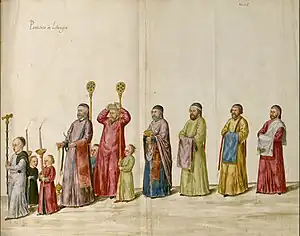
In 1453, Constantinople fell to the Ottoman Empire. The flight of Eastern Christians from Constantinople, and the Greek manuscripts they carried with them, is one of the factors that prompted the literary renaissance in the West.[471]
.jpg.webp)
The Hagia Sophia and the Parthenon, which had been Christian churches for nearly a millennium, were converted into mosques. Violent persecutions of Christians were common and reached their climax in the Armenian, Assyrian, and Greek genocides.[472][473]
The Russian church
In a defining moment in 1380, Grand Prince Dmitrii of Moscow faced the army of the Golden Horde on Kulikovo Field near the Don River, there defeating the Mongols. Michael Angold writes that this began a period of transformation fusing state power and religious mission: thereafter "a disparate collection of warring principalities" formed "into an Orthodox nation, unified under tsar and patriarch and self-consciously promoting both a national faith and an ideology of a faithful nation".[474]
Coptic, Melkite, Nestorian and Jacobite Christianity
The Coptic, Melkite, Nestorian and Jacobite communities existed in lands under Muslim rule.[475] In the 600s, Christianity had been the majority faith in those lands conquered by the Arabs, but by the eleventh century, Christianity had declined demographically, culturally and socially, while Islam set the social norm.[476] Christians were dhimma. On the one hand, this guaranteed Christians rights of protection, but discriminated against them through legal inferiority.[475]
From the eleventh to the fourteenth century, the Christian material position deteriorated.[477] During the rule of sultan Saladin (1171–93) Christians were required to wear a yellow belt, were forbidden to ride horses or mules, and were expected to remove crosses from the outsides of churches.[477] This sometimes led to "gangs of thugs inflamed by hatred" attacking them.[478]
A Monophysite church, (currently known as the Coptic Church), was the dominant force in Egyptian Christianity.[264] The Copts integrated fully into an unmistakably Arab Egypt leading to arabization.[479]
"Melkite" was the term applied to those loyal to the Chalcedonian creed which had been adopted by the emperors of Constantinople.[480] The Melkites held the patriarchate of Jerusalem, and for more than a century Antioch and the surrounding region came under Byzantine rule.[481]
Intense missionary activity between the fifth and eighth centuries led to eastern Iran, Arabia, central Asia, China, the coasts of India and Indonesia adopting Nestorianism. Syrian Nestorians also settled in the Persian Empire.[482] By the end of the eleventh century, Christianity was in full retreat in what had been Mesopotamia (interior Iran - Nisibis, Basra, Irbil, Mosul), but the Christian communities further to the east continued to exist.[482]
The Church of the East played a major role in the history of Christianity in Asia. Between the 9th and 14th centuries, it represented the world's largest Christian denomination in terms of geographical extent. It established dioceses and communities stretching from the Mediterranean Sea and today's Iraq and Iran, to India (the Saint Thomas Syrian Christians of Kerala), the Mongol kingdoms in Central Asia, the Turkic tribes in Central Asia,[483] and China during the Tang dynasty (7th–9th centuries). In the 13th and 14th centuries, the church experienced a final period of expansion under the Mongol Empire, where influential Church of the East clergy sat in the Mongol court.[484]
Armenians and crusade
The onset of the Arab period began an era of consolidation in Armenian Christianity.[485] The structures of the institutional church, its sacraments and the legitimacy of its representational art were defended.[485] Armenians of all types were united in devotion to St. Gregory the Illuminator who had brought Christianity to the Armenian court in the early fourth century.[486] Religious differences were a source of friction, but also substantial interchange.[487][note 29]
Early modern period (c. 1500 – c. 1750)
Expansion and Reform
Colonialism
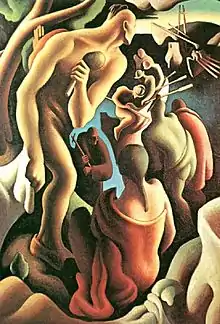
Following the geographic discoveries of the 1400s and 1500s, increasing population and inflation led the emerging nation-states of Portugal, Spain, and France, the Dutch Republic, and England to explore, conquer, colonize and exploit the newly discovered territories.[492] While colonialism was economic and political, it also opened the door for Christian missions.[493][494] According to historical theologian Justo González, colonialism and missions each sometimes aided and sometimes impeded the other.[495]
Different state actors created colonies that varied widely.[496] Some colonies had institutions that allowed native populations to reap some benefits. Others became extractive colonies with predatory rule that produced an autocracy with a dismal record.[497] Persecution, and violence toward local people and their native religions was a frequent aspect of extractive colonies.[498][15][16][17]
Protestant Reformation
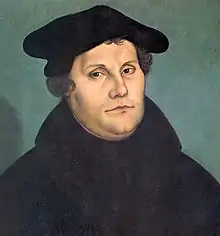
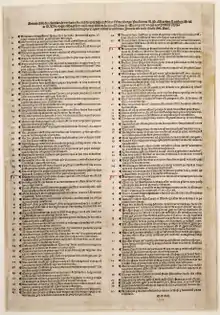
In the early 16th century, attempts were made by the Christian theologians Martin Luther and Huldrych Zwingli, along with many others, to reform the Catholic Church. The Reformation is usually considered to have started with the publication of the Ninety-five Theses by Luther in 1517, although there was no schism until the 1521 Diet of Worms. The edicts of the Diet condemned Luther and officially banned citizens of the Holy Roman Empire from defending or propagating his ideas.[499]
Early protest was against corruptions such as simony (the buying and selling of church offices), the holding of multiple church offices by one person at the same time, episcopal vacancies, and the sale of indulgences. The Protestant position also included the Five solae (sola scriptura, sola fide, sola gratia, solus Christus, soli Deo gloria), the priesthood of all believers, Law and Gospel, and the two kingdoms doctrine.
The three most important traditions to emerge directly from the Reformation were the Lutheran, Reformed, and Anglican traditions, though the latter group identifies as both "Reformed" and "Catholic", and some subgroups reject the classification as "Protestant".[500]
Radical Reformation
Beginning in Germany and Switzerland in the 16th century, the Radical Reformation was a disorderly collection of loosely related reformation groups that included Anabaptists, Spiritualists, and Evangelical Rationalists.[501] They opposed the traditional church-state theories of classical Protestantism (Lutherans, Reformed and Elizabethans), were often indifferent to governmental jurisdiction altogether, and supported a full separation from the state. They rejected Luther's key teachings on salvation by faith alone and predestination, along with Catholic transubstantiation. According to historian George Huntston Williams, members of the Radical Reformation are "equally distant from classical Protestantism and Tridentine Catholicism".[500]
Counter-Reformation
According to Matthews and Platt, the Roman Catholic Church struck back at Protestant Reformation by launching its own three-pronged Counter-Reformation using "a revitalized papacy, new monastic orders, and an effective reforming council [the Council of Trent"].[502]
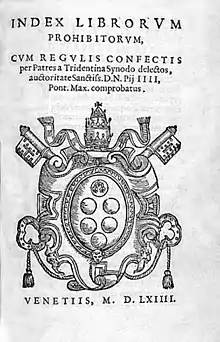
Counter-Reformation began with Pope Paul III (1534 - 1549), the first in a series of 10 reforming popes from 1534-1605.[502] He convened a council of Roman Catholic clergy from all over Europe, enlisting their support.[502] In an effort to aid in the reclamation of morality, a committee was established to create a list of books thought to be detrimental to faith or morals. The Index of Forbidden books included the works of Luther, Calvin and other Protestants along with writings condemned as obscene. The list continued to be augmented into the 1960s.[502]
Monastic reform had not been an influence in the church since the High Middle Ages (1100-1200) until the Counter-Reformation of the late sixteenth century when multiple new monastic orders rose.[503] Among these were the Jesuits. Resembling a military company more than a monastic order in its hierarchy, discipline, and obedience to its founder, their vow of loyalty to the Pope set them apart from other monastic orders, leading them to be called "the shock troops of the papacy". Matthews and Platt write that the Jesuits soon became the church's chief weapon against Protestantism.[503]
Monastic reform also led to the development of new, yet orthodox, forms of spirituality, such as that of the Spanish mystics and the French school of spirituality.[504]
The Council of Trent (1545–1563) initiated by Pope Paul III met in three sessions between 1545 and 1563. The council affirmed tradition as equal to the Bible in authority, upheld monasticism, indulgences, and the worship of relics, with some attempt to prevent the abuses Protestants condemned.[503] Steps were taken toward clerical reform. The Vulgate was the only Bible, salvation was through faith and works, and the seven sacraments of the Roman church. The power of bishops was expanded and papal control was tightened.[505] This provided the foundation of Roman Catholic policies up to the present.[505]
Religious wars (16th, 17th and early 18th centuries)
In the Early modern Era, "religious" wars ranging from international wars to internal conflicts were fought in parts of Europe and England. Many scholars see these wars as at least partly fought to obtain security and freedom for differing religious confessions; however it is also asserted they were fought more for political gain, since national, dynastic, and mercenary interests generally prevailed over religious concerns.[506][507]
_(14781836201).jpg.webp)
War began in the Holy Roman Empire with the minor Knights' Revolt in 1522.[508][509] Warfare intensified in the First Schmalkaldic War (1546-1547) and the Second Schmalkaldic War (1552-1555) after the Catholic Church began the Counter-Reformation.[510] The rise of Calvinism triggered a second wave of wars.[510] Seven years after the Peace of Augsburg had established a truce in Germany on the basis of territorialism, France became the centre of religious wars which lasted for 36 years.[507] The final wave was the Thirty Years War (1618-1648). The involvement of foreign powers made it the largest and most disastrous.[510]
The causes of these wars are debated.[note 30] Political scientist James Bernard Murphy writes that "Virtually all major [political] theorists ... cite the ‘‘wars of religion’’ to ... demonstrate the dangers that religious belief poses to political order".[515] However, scholars have largely interpreted these wars as struggles for independence that coincided with the break up of medieval empires into the modern nation states.[510]
Tolerance
Historian Nicolette Mout writes in The Cambridge History of Christianity that debate on toleration occupied every version of the Christian faith from the Reformation onwards.[516] Did peace require allowing only one faith and the punishment of heretics? Or should ancient opinions defending leniency, (based on the popular parable of the tares and wheat in Matthew 13:24–30, 36–43), be revived? What was the role of individual conscience?[516]
This world changing debate was not confined to religion.[516] Leaders of the modern states of Europe believed, as most people did at the time, that stability necessitated allowing only one faith within their countries. (It seemed apparent to those experiencing religious wars that plurality produced chaos.)[517] The debate on religious toleration made it necessary to rethink, on a political level, all of the State's reasons for persecution.[516] Many began arguing in favor of tolerance.[518]
The Peace of Westphalia (1648) gave the Holy Roman Empire what Mout describes as "a highly durable legal and constitutional foundation for a form of toleration".[519] Over the next two and a half centuries, many other treaties and political declarations of tolerance followed, until concepts of freedom of religion, freedom of speech and freedom of thought became established in most western countries.[520][521]
Society and culture
Modern inquisitions
History of the Inquisition divides into two major parts: its Papal creation in the early thirteenth century, and its transformation into permanent secular governmental bureaucracies between 1478 and 1542.[522]
Historian Helen Rawlings says, "the Spanish Inquisition was different [from earlier inquisitions] in one fundamental respect: it was responsible to the crown rather than the Pope and was used to consolidate state interest.[523]
The Portuguese Inquisition, in close relationship with the church, was also controlled by the crown who established a government board, known as the General Council, to oversee it. The Grand Inquisitor, chosen by the king, was nearly always a member of the royal family.[524]
T. F. Mayer, historian, writes that "the Roman Inquisition operated to serve the papacy's long standing political aims in Naples, Venice and Florence".[525] Its activity was primarily bureaucratic. The Roman Inquisition is probably best known for its condemnation of Galileo.[526]
Science and the Galileo Affair

The Galileo affair has been considered by many to be a paradigm defining moment in the history of the relationship between religion and science.[527][528][529]
In 1610, Galileo published his Sidereus Nuncius (Starry Messenger), describing observations made with his new telescope that planets moved. Since Aristotle's rediscovery in the 1100s, western scientists along with the Catholic Church, had adopted Aristotle's physics and cosmology with the earth fixed in place.[530][358] Jeffrey Foss writes that, by Galileo's time the Aristotelian-Ptolemaic view of the universe had itself been fixed in place for centuries and was "fully integrated with Catholic theology".[531]
As a result, the majority of Galileo's fellow scientists rejected Galileo's assertions that planets moved. Most of them had no telescope, and Galileo had no theory of physics to explain how planets could orbit the sun; according to Aristotelian physics, that was impossible. (That would not be resolved for another hundred years.) Galileo's peers alerted religious authorities to his "errors" and asked them to intervene.[532]
In response, the church forbade Galileo from teaching it, though it did not forbid discussing it, so long as it was clear it was merely a hypothesis. Instead, Galileo published books and asserted scientific superiority.[531] He was summoned before the Roman Inquisition twice. First warned, he was next sentenced to house arrest on a charge of "grave suspicion of heresy".[529]
French historian Louis Châtellier writes in the Cambridge History of Christianity that Galileo's condemnation - since he was a devoted Catholic - caused much consternation and private discussion.[533] Speculation was about whether the judges were condemning Galileo or the "new science" and anyone who attempted to displace Aristotle. Thus, Châtellier concludes, "...in the mid-seventeenth century the relationship between scientific thinkers and ecclesiastical authorities was marked by reciprocal mistrust".[534]
Witch trials (c. 1450 – c. 1750)
Until the 1300s, the official position of the Roman Catholic Church was that witches did not exist.[535][note 31] While historians have been unable to pinpoint a single cause of what became known as the "witch frenzy", scholars have noted that, without changing church doctrine, a new but common stream of thought developed at every level of society that witches were both real and malevolent.[539]
The highest concentration of witch trials occurred in the Holy Roman Empire (southwestern Germany) during the years 1561 to 1670.[540] Ankarloo and Clark indicate the main pressure to prosecute witches came from the common people, and trials were mostly civil trials.[541][542] Records from inquisitions show the belief in magic had remained so widespread among the rural people that it has convinced some historians Christianization had not been as successful as previously supposed.[543] The majority of those brought to trial were not executed, and most of those accused were never brought to trial.[540] There is broad agreement that approximately 100,000 people were prosecuted, (about 80% women, most over 40), while approximately forty to fifty thousand people were executed between 1561 and 1670.[540][539]
Enlightenment critique of Christianity and Christian Enlightenment (1685 – 1815)
There has long been an established consensus that the essence of the Enlightenment was anti-Christian, anti-Church and even anti-religious.[544] However, twenty-first century scholars tend to see the relationship between Christianity and the Enlightenment as complex with many regional and national variations.[545][544]
In many places in Europe, the Enlightenment was not simply a war with Christianity. Helena Rosenblatt writes that much of what took place did so "within the Christian churches themselves".[544] These Christians saw themselves as moderates positioned equally between the fanatical and the irreligious.[546] For example, John Locke wrote The Reasonableness of Christianity in the 1690's with the intent of bolstering a moderate Christianity.[547]
In Margaret Jacob's view, critique of Christianity began among the more extreme Protestant reformers who were enraged by fear, tyranny and persecution caused by absolutism.[548] Protestants and Catholics alike believed the political absolutism of kings was backed by Catholicism, and was not supported by reformists, putting pressure on all Protestants.[545][549]
According to Jacob,
These are the events that form the essential background to understanding the Enlightened critique of Christianity as it emerged with virulence in the period of the 1680s. From that moment onward, the critique only became more pointed, more strident, sometimes less anonymous, but always suspicious of clerical authority and often bitter. It lay at the heart of the crisis provoked by monarchical absolutism.[550]
After 1660, many became vocally anti-clerical, anti-Catholic, and anti-Christian.[551] Spinoza, an Amsterdam Jew, was one of many who published against religion. His first tract, Tractatus Theologico-Politicus (1670), in Latin, was quickly translated in renegade Protestant circles in the Dutch Republic, and his ideas were then spread through numerous anonymous books and manuscripts.[552][note 32] Spinoza, Hobbes and their followers supported a matter based (materialistic) mechanistic universe with no need of God. Newtonian science offered a response, but after 1750, secularization at every level of European society can be observed.[558]
Late modern period (c. 1750 – c. 1945)
Religion and revolution in America
Throughout the revolutionary period in America, English speaking Protestant Christianity was the majority religion and played the most visible role. Martin Marty writes that between 2.5 and 3 million people lived in 'the colonies' in 1787 when the nation was first founded. African American slaves had no rights to speak of, so few had the ability to contribute to independence, yet there were still some who did. About 30,000 citizens were Roman Catholics, and they and the very few Jewish citizens, were also able to play only a small part in revolution. Strong national influence on their part would not appear until after 1815.[559]
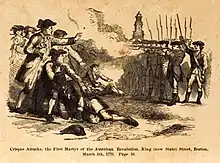
Many have seen the War of Independence and its aftermath as a conservative revolution by American lawyers, landowners, and merchants who assured for themselves the kind of economic liberties their counterparts in England knew. However, the legal assurance of religious freedom and the rise of voluntary churches made up a more radical revolution. The degree that that was so, the one-time British colonials had to their satisfaction effected the beginning of what another Latin phrase on their national motto so triumphantly affirmed: this meant a novus ordo seclorum, a new order of ages.[560]
Reawakenings
| Great Awakenings in America |
|---|
A revitalization of religious piety known as the first Great Awakening swept through the American colonies between the 1730s and the 1770s. Both religious and political in nature, it had roots in German Pietism and British Evangelicalism, and was a response to the extreme rationalism of biblical criticism, the anti-Christian tenets of the Age of Enlightenment, and its threat of assimilation by the modern state.[561][562][563][564]
Beginning among the Presbyterians, it quickly spread to Congregationalists (Puritans) and Baptists, creating American Evangelicalism and Wesleyan Methodism.[565] Battles over the movement and its dramatic style raged at both the congregational and denominational levels. This caused the division of American Protestantism into political 'Parties' for the first time, which eventually led to critical support for the American Revolution.[566] In places like Connecticut and Massachusetts where one denomination received state funding, churches now began to lobby local legislatures to end that inequity by separating church and state.[562] Theological pluralism became the new norm.[567]
The Second Great Awakening (1800–1830s) led to the beginnings of the Mormons, the Restoration Movement and the Holiness movement. Participants united in extolling moral reform as the Christian alternative to armed revolution, and established societies that operated separately from any church to "teach the poor to read, suppress sexual vice and ungodly amusements such as cockfighting and bear-baiting, and to abolish the slave trade".[568] These were pioneers in developing nationally integrated forms of organization which produced the mergers and business consolidations that reshaped the American economy.[569] The beginnings of social reform movements concerning the abolition of slavery, women's rights, and temperance have been directly connected to this religious revival.[570]
The Third Great Awakening began from 1857 and was most notable for taking the movement throughout the world, especially in English speaking countries.[571]
Restorationism
Restorationism have not described themselves as a reform movement but have, instead, described themselves as restoring the church to its original form found in the book of Acts.[572][573]
"Restorationism" is frequently used to describe the Stone-Campbell Restoration Movement. The term is also used to describe movements such as Adventism, which originated in the 1830s in the United States during the Second Great Awakening, and the Jehovah's Witnesses, founded in the late 1870s by Charles Taze Russell. The term can also be used to describe the Latter Day Saint movement, also known as Mormons, including the Church of Jesus Christ of Latter-day Saints (LDS Church), the Community of Christ and numerous other Latter Day Saint denominations. [574][575][576][577]
Campaign against slavery

Historian Christopher Brown has written in the Cambridge History of Christianity that, for four centuries, Christian Europe "had devised and operated a vast transatlantic traffic which had conveyed, as of 1808, more than 8 million African men, women, and children to the Americas and led to the death and enslavement in Africa and the Americas of many millions more. Professed Christians sold, purchased, and worked African slaves everywhere in the new American settlements, from Quebec to Quito... Christianity, then, was as important to the expansion of slavery in the Americas, as it was to its demise."[578]
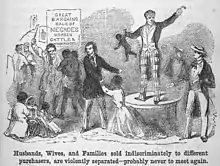
Moral objections surfaced very soon after the establishment of the trade.[note 33] In the earliest instances, denunciations came from Catholic priests.[581][note 34] In the end, Anglo-American abolitionism, emerging first in the Religious Society of Friends, was a direct product of evangelical revival.[583]
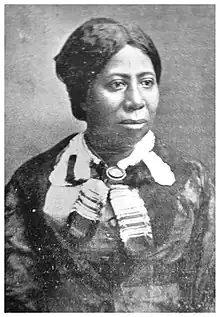
Several opponents of slavery, such as the Methodist leader John Wesley, used pamphlets to make a detailed case against the Atlantic slave trade. The Quakers helped guide these tracts into print, often subsidizing their publication and distribution. Friends organized the first anti-slavery societies in Britain and in the new United States.[584] The moral reform of the Second Great Awakening was aided largely by American revivalists such as Timothy Dwight, Lyman Beecher and Charles Finney, who was influenced by Wesleyan theology.[585][586]
The first black abolitionists were Calvinist theologians who denied that being black was the Mark of Cain, or that African blacks suffered from the Curse of Ham, and found no justification for slavery in the Bible.[587] In the years after the American Revolution, black congregations sprang up around the English speaking world led by black preachers who brought revival, promoted communal and cultural autonomy, and provided the institutional base for promoting abolitionism. According to Brown, "It was in the black churches, ... that the case for immediate emancipation was sustained in the United States between 1790 and 1830".[588]
Unlike the Puritan settlers, blacks could not think of themselves as entering a new Eden. Instead, they were arising like Lazarus, from deprivation and despair to reclaim their rightful heritage. In this interpretive framework, what lay ahead for men and women of African descent was a new Exodus, an escape from bondage, the day of jubilee when all wrongs would be redressed and blacks, as latter day Hebrews, would enjoy divine protection. This was the radical potential invoked by black ministers from the pulpit in the last years of the British and American slave trades".[589]
Brown writes that abolitionism did not flourish in the societies of absolutist states.[590] It was the Protestant revivalists who followed the Quaker example, and the new American republic that led to the "gradual but comprehensive abolition of slavery".[591]
American colonialism
The beginning of American Protestant missions abroad followed the sailing of William Carey from England to India in 1793 after the Great awakening. At the same time, a great effort was also made to evangelize America.[592] Missionaries played a crucial role in the acculturation of the American Indians.[593][594][595]
The history of boarding schools for the indigenous populations in Canada and the US is mixed. While the majority of native children did not attend boarding school at all, of those that did, recent studies indicate a few found happiness and refuge while many others found suffering, forced assimilation, and abuse.[596]
Over time, many missionaries came to respect the virtues of native culture. "After 1828, most missionaries found it difficult to defend the policies of their government" writes McLoughlin.[593]
Church, state and society
Capitalism and banking
Protestantism promoted economic growth and entrepreneurship, especially in the period after the Scientific and the Industrial Revolution.[597][598] Scholars have identified a positive correlation between the rise of Protestantism and human capital formation,[599] work ethic,[600] economic development,[601] and the development of the state system.[602]
Max Weber in his book The Protestant Ethic and the Spirit of Capitalism (1904–1905) asserted that Protestant ethics and values along with the Calvinist doctrine of asceticism and predestination gave birth to capitalism.[603][604] Weber says this contributed to economic growth and the development of banking across Northern Europe.[605][606]
It is one of the most influential and cited books in sociology, yet its thesis has been controversial since its release. In opposition to Weber, historians such as Fernand Braudel and Hugh Trevor-Roper assert that capitalism developed in pre-Reformation Catholic communities. Joseph Schumpeter, an economist of the twentieth century, has referred to the Scholastics as "they who come nearer than does any other group to having been the 'founders' of scientific economics".[607]
Under Nazism
Pope Pius XI declared – Mit brennender Sorge – that Fascist governments had hidden "pagan intentions" and expressed the irreconcilability of the Catholic position with totalitarian fascist state worship which placed the nation above God, fundamental human rights, and dignity.[608]
Catholic priests were executed in concentration camps alongside Jews; 2,600 Catholic priests were imprisoned in Dachau, and 2,000 of them were executed (cf. Priesterblock). A further 2,700 Polish priests were executed (a quarter of all Polish priests), and 5,350 Polish nuns were either displaced, imprisoned, or executed.[609] Many Catholic laymen and clergy played notable roles in sheltering Jews during the Holocaust, including Pope Pius XII. The head rabbi of Rome became a Catholic in 1945 and, in honour of the actions the pope undertook to save Jewish lives, he took the name Eugenio (the pope's first name).[610]
Most leaders and members of the largest Protestant church in Germany, the German Evangelical Church, which had a long tradition of nationalism and support of the state, supported the Nazis when they came to power.[611][612] A smaller contingent, about a third of German Protestants, formed the Confessing Church which opposed Nazism. In a study of sermon content, William Skiles says "Confessing Church pastors opposed the Nazi regime on three fronts... first, they expressed harsh criticism of Nazi persecution of Christians and the German churches; second, they condemned National Socialism as a false ideology that worships false gods; and third, they challenged Nazi anti-Semitic ideology by supporting Jews as the chosen people of God and Judaism as a historic foundation of Christianity".[613]
Nazis interfered in The Confessing Church's affairs, harassed its members, executed mass arrests and targeted well known pastors like Martin Niemöller and Dietrich Bonhoeffer.[614][615][note 35] Bonhoeffer, a pacifist, was arrested, found guilty in the conspiracy to assassinate Hitler and executed.[617]
Russian Orthodoxy
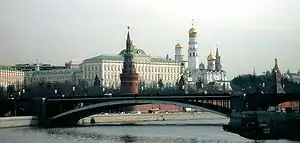
The Russian Orthodox Church held a privileged position in the Russian Empire, expressed in the motto of the late empire from 1833: Orthodoxy, Autocracy, and Populism. Nevertheless, the Church reform of Peter I in the early 18th century had placed the Orthodox authorities under the control of the tsar. An ober-procurator appointed by the tsar ran the committee which governed the Church between 1721 and 1918: the Most Holy Synod. The Church became involved in the various campaigns of russification,[618] and was accused of involvement in Russian antisemitism,[619] despite the lack of an official position on Judaism as such.[620]
The Bolsheviks and other Russian revolutionaries saw the Church, like the tsarist state, as an enemy of the people. Criticism of atheism was strictly forbidden and sometimes led to imprisonment.[621][622][623] Some actions against Orthodox priests and believers included torture, being sent to prison camps, labour camps or mental hospitals, as well as execution.[624][625]
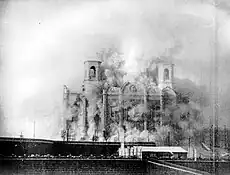
In the first five years after the Bolshevik revolution, one journalist reported 28 bishops and 1,200 priests were executed.[627] This included people like the Grand Duchess Elizabeth Fyodorovna who was at this point a monastic.[note 36] Recently released evidence indicates over 8,000 were killed in 1922 during the conflict over church valuables.[628] More than 100,000 Russian clergymen were executed between 1937 and 1941.[629]
Under the state atheism of the Soviet Union and the Eastern Bloc, Christians of many denominations experienced persecution, with many churches and monasteries being destroyed, as well as clergy being executed.[note 37][note 38][note 39]
Twentieth century
In the early twentieth century, the study of two highly influential religious movements - the social gospel movement (1870s–1920s) and the rise of the global ecumenical movement (beginning in 1910) - provided the context for the development of American sociology as an academic discipline.[633]
Liberal Christianity, sometimes called liberal theology, is an umbrella term for religious movements within late 18th, 19th and 20th-century Christianity. According to theologian Theo Hobson, liberal Christianity has two traditions. Before the Enlightenment of the eighteenth century, a specifically Christian Idealism imagined a liberal State with political and cultural liberty. This was essential to the creation of the modern secular state.[634]
The second tradition was from seventeenth century rationalism's efforts to wean Christianity from its "irrational" cultic roots.[635] Lacking any grounding in Christian "practice, ritual, sacramentalism, church and worship", liberal Christianity lost touch with the fundamental necessity of faith and ritual in maintaining Christianity.[636] This led to the birth of fundamentalism and liberalism's decline.[637]
Fundamentalist Christianity is a movement that arose mainly within British and American Protestantism in the late 19th century and early 20th century in reaction to modernism.[638] Before 1919, fundamentalism was loosely organized and undisciplined. Its most significant early movements were the holiness movement and the millenarian movement with its premillennial expectations of the second coming.[639]
In 1925, fundamentalists participated in the Scopes trial, and by 1930, the movement appeared to be dying.[640] Then in the 1930s, Neo-orthodoxy began uniting moderates of both sides.[641] In the 1940s, "new-evangelicalism" established itself as separate from fundamentalism.[642] Today, fundamentalism is less about doctrine than political activism.[643]
Contemporary Christianity
Decolonization
After World War II, Christian missionaries played a transformative role for many colonial societies moving them toward independence through the development of decolonization.[644][645]
Second Vatican Council
On 11 October 1962, Pope John XXIII opened the Second Vatican Council, the 21st ecumenical council of the Catholic Church. The council was "pastoral" in nature, interpreting dogma in terms of its scriptural roots, revising liturgical practices, and providing guidance for articulating traditional Church teachings in contemporary times. The council is perhaps best known for its instructions that the Mass may be celebrated in the vernacular as well as in Latin.[646]
Ecumenism
.jpg.webp)

On 21 November 1964, the Second Vatican Council published the Decree on Ecumenism, Unitatis Redintegratio.[648] Roman Catholic goals (as given to the World Council of Churches and propagated by the Second Vatican Council), are to establish full communion amongst all the various Christian churches in faith, sacramental life and ministry.[649]
Amongst Evangelicals, there is no agreed upon definition, strategy or goal.[650] Pentecostalism, the largest and fastest growing movement in Christianity, has a different ecclesiology which has produced some hostility toward, the formal, creedal and institutional practices of the WCC.[651][652] In the twenty-first century, sentiment is widespread that ecumenism has stalled.[653]
Decline of Christianity in the West
Sociologists Dick Houtman and Stef Aupers write that Christianity has been declining in the West while alternative "spiritualities" outside traditional Christianity have grown.[654] The theory of secularization in the sociology of religion is no longer the accepted explanation.[654] In western nations, including the U.S., this change is not so much a disappearance of religion as much as it is a relocation of the sacred into a deeper understanding of the self.[655] This type of spirituality is private and individualistic, and differs radically from Christian tradition, dogma and ritual.[656]
World Christianity
Africa (19th to 21st centuries)
Beginning in the mid-nineteenth century, many Protestant missionaries worked with indigenous people to translate the Bible into approximately 90% of those native languages in their locations.[657] At the same time, this process generated a written grammar, a lexicon of native traditions, and a dictionary of their language, which was taught in missionary schools, thereby advancing literacy.[658][659]
Local native cultures responded with "movements of indigenization and cultural liberation" says Sanneh.[660] This led to the development of national literatures, the spread of literacy, mass printing and the development of voluntary organizations which were instrumental in generating a democratic legacy.[657][658] According to Sanneh, that means western missionaries began the "largest, most diverse and most vigorous movement of cultural renewal in [the] history" of Africa.[661][662]
In 1900 under colonial rule there were just under 9 million Christians in Africa. By 1960, and the end of colonialism there were about 60 million. By 2005, African Christians had increased to 393 million, about half of the continent's total population at that time.[658] Population in Africa has continued to grow with the percentage of Christians remaining at about half in 2022.[663] According to Isichei, "The expansion of Christianity in twentieth-century Africa has been so dramatic that it has been called 'the fourth great age of Christian expansion'."[664]
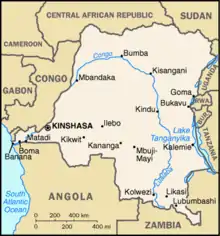
Simon Kimbangu's movement, the Kimbanguist church, had a radical reputation in its early days in the Congo, was suppressed for forty years, and has now become the largest independent church in Africa with upwards of 3 million members. [665]
Anne Marie Stoner-Eby writes, "The Christianization of initiation rites in the Anglican Diocese of Maasai (in what is now southeastern Tanzania) is arguably the most famous instance of 'adaptation' in African mission Christianity."[666]

In 2019, 65% of Melillans in Northern Africa across from Spain identify themselves as Roman Catholic.[667]
In the early twenty-first century, Kenya has the largest yearly meeting of Quakers outside the United States. In Uganda, more Anglicans attend church than do so in England. Ahafo, Ghana is recognized as more vigorously Christian than any place in the United Kingdom.[664]
There is revival in East Africa, and vigorous women's movements called Rukwadzano in Zimbabwe and Manyano in South Africa. The Apostles of John Maranke, which began in Rhodesia, now have branches in seven countries.[668]
Asia
In the first decades of the twenty-first century, Pentecostalism is the largest and fastest growing form of Christianity.[669]
Historian Philip Jenkins observes that Christianity is growing rapidly in China and some other Asian countries.[670][671] Sociologist and specialist in Chinese religion Fenggang Yang from Purdue University writes that Christianity is "spreading among the Chinese of South-East Asia", and "Evangelical and Pentecostal Christianity is growing more quickly in China".[672]
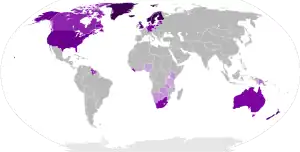

Social Anthropologist Juliette Koning and sociologist Heidi Dahles of Vrije Universiteit Amsterdam, agree there has been a "rapid expansion of charismatic Christianity from the 1980s onwards. Singapore, China, Hong Kong, Taiwan, Indonesia, and Malaysia are said to have the fastest-growing Christian communities and the majority of the new believers are "upwardly mobile, urban, middle-class Chinese". Allan Anderson and Edmond Tang have reported in their book Asian and Pentecostal: The Charismatic Face of Christianity in Asia that "Asia has the second largest number of Pentecostals/charismatics of any continent in the world, and seems to be fast catching up with the largest, Latin America."[674] The World Christian Encyclopedia estimated 135 million in Asia compared to 80 million in North America.[674]
It has been reported in America Magazine that increasing numbers of young people are becoming Christians in several countries, such as China,[675][676] Hong Kong,[677] Indonesia,[678] Iran,[679][680] Japan,[681] Singapore,[682][683][684] and South Korea.[685] The Council on Foreign Relations says the "number of Chinese Protestants has grown by an average of 10 percent annually since 1979".[686]
_(14586684050).jpg.webp)
According to a 2021 study by the Pew Research Center, Christianity has grow in India in recent years.[687][688] While the exact number of Dalit converts to Christianity in India is not available, religion scholar William R. Burrow of Colorado State University has estimated that about 8% of Dalits have converted to Christianity.[689]
Since the 1960s, there has been a substantial increase in the number of conversions from Islam to Christianity.[690] The 2015 study Believers in Christ from a Muslim Background: A Global Census estimated that 10.2 million Muslims converted to Christianity.[691]
Persecution
The end of French imperialism in the Eastern Maghreb (Algeria, Libya, Mauritania, Morocco and Tunisia) led to the reinstatement of Arab monarchs, independence, and the Maghreb being home to 2 million European Catholics.[692][693] In 2013, 17 Middle Eastern Muslim majority states, including Algeria, Libya, Mauritania, Morocco and Tunisia, reported 28 of the 29 types of religious discrimination against 45 of the 47 religious minorities, including Christianity.[694]
See also
- Christian anarchism
- Christianity and Neoplatonism
- Christianity and Paganism
- Christianization
- History of Christian theology
- History of Christian universalism
- History of the Eastern Orthodox Church
- History of Oriental Orthodoxy
- History of Protestantism
- History of the Catholic Church
- Mandaeism
- Rise of Christianity during the Fall of Rome
- Role of the Christian Church in civilization
- Timeline of Christian missions
- Timeline of Christianity
- Timeline of the Roman Catholic Church
Notes
- ↑ An approximate chronology of Jesus can be estimated from non-Christian sources, and confirmed by correlating them with New Testament accounts.[26][27] Jesus was most likely born between 7 and 2 BC and died 30–36 AD.[26][28] The baptism of Jesus by John the Baptist can be dated approximately from Josephus' references (Antiquities 18.5.2) to before AD 28–35.[29][30][31][32]
- ↑ Toward the end of the Twentieth century, multiple scholars traced elements of Christianity to currents in first-century Judaism and discarded nineteenth-century views that Jesus was based on previous pagan deities.[34] Mentions of Jesus in extra-biblical texts exist and are supported as genuine by the majority of historians.[35] Differences between the content of the Jewish Messianic prophecies and the life of Jesus undermine the idea that Jesus was invented as a Jewish Midrash or Peshar.[36]
- ↑ Young lists some of the difficulties:
- Post-Enlightenment questions about the perspectives and beliefs of those who told the story, not least the belief in miracles and supernatural power
- The nature of the sources and the question of their mutual compatibility
- Considerable time-spans between the events and the accounts
- Questions about the validity of oral traditions
- Gaps in the evidence
- Issues about the authenticity of material remains
- Post-Reformation rejection of relics and their veneration.[38]
- ↑ The dispersion of the Jewish people from their homeland had begun in BC 587/6 when Nebuchadnezzar conquered Israel and took slaves from Jerusalem into Babylon.[61] When later allowed to return, not everyone did so. Those remaining outside the homeland became a somewhat separate community later referred to by scholars as the diaspora.[62] The extent of the Jewish diaspora included most of the Roman Empire: Jews lived in Egypt, Syria and most of Asia up to the Black Sea, the European continent and North Africa. Arabia also contained Jews. There were Jewish communities in Spain, Gaul and Germany, and the Peloponnese, including the islands Euboea, Cyprus, Crete.[62]
- ↑ Achaea, especially Asia Minor, was the geographical heartland between west and east in the Roman Empire.[80] Corinth’s two ports were accessible to Italy and Asia alike, and traffic and correspondence between Asia Minor and Achaea was constant.[80] Cenchreae had a Christian presence in the 50s (Rom 16:1).[81] Ephesus was the recipient of one of the Pauline epistles.[82] The church at Ephesus is one of the seven churches in the Book of Revelation, and the Gospel of John may have been written there.[83][84] Ephesus was also the site of several 5th-century Christian Councils (see Council of Ephesus).[85]
- ↑ New Testament manuscripts, datable to the second century, consist of papyrus fragments of Matthew, Mark, John, Titus and Revelation... Other early Christian literature introduced into Egypt and attested in second-century Greek manuscripts include the Egerton Gospel (probably from Syria), The Shepherd of Hermas (from Rome), Papyrus Oxyrhynchus 1 (Gos. Thom. 26–8, from Syria), and Irenaeus’ Adversus haereses (‘Against heresies’, composed in Gaul and probably introduced into Egypt from Rome)."[89] Egyptian Christians, more than any other region, also abundantly produced their own religious literature during the second and third centuries.[90] The Gospel of the Hebrews, the The Gospel of the Egyptians -- The Nag Hammadi Library|Gospel of the Egyptians, the Secret Gospel of Mark, the Gospel of the Saviour, Kerygma Petri [‘Preaching of Peter’], the Apocalypse of Peter, Traditions of Matthias, the Gospel of Eve, Jannes and Jambres, some Christian Sibylline oracles, and the Apocalypse of Elijah are all of Egyptian provenance.[90] Works that were probably written in Egypt include the Epistle of Barnabas, the Epistle to Diognetus, Second Clement, The Sentences of Sextus, Agrippa, Castor, Pseudo-Justin, Clement of Alexandria, Origen, Dionysius of Alexandria, Theognostus, Pierius and Theonas.[90] Gnostic writings include Basilides works such as Basilidians, Carpocrates and the Carpocratians, the writings of Valentinus, Theodotus Heracleon, and Julius Cassianus. All written in Egypt. The list includes the Gospel of Truth (NHC i,3; xii,2), Interpretation of Knowledge (NHC xi, 1), Treatise on the Resurrection (NHC i,4), A Valentinian Exposition (NHC xi, 2), Tripartite Tractate (NHC i,5), Apocryphon of James (NHC i,2), On the Origin of the World (NHC ii,5; xiii,2), Exegesis on the Soul (NHC ii,6), Sophia of Jesus Christ (NHC iii,4; BG,3) Apocalypse of Paul (NHC v,2), The Thunder, Perfect Mind (NHC vi,2), Concept of Our Great Power(NHC vi,4), Second Treatise of the Great Seth (NHC vii,2), Apocalypse of Peter (NHC vii,3)17), Letter of Peter to Philip (NHC viii,2), Testimony of Truth (NHC ix,3), Hypsiphrone (NHC xi,4), the Gospel of Mary (BG,1), the Books of Jeu (Bruce codex), and [the collection of Coptic Gnostic fragments found at Bala’izah.[91] Pearson writes that the literary evidence also includes "works translated into Coptic and preserved in Coptic manuscripts: twelve codices plus loose leaves from a thirteenth found near Nag Hammadi, Egypt: the Gnostic Berlin Codex (Papyrus Berolinensis 8502), the Askew Codex (Pistis sophia), the Bruce Codex, and fragments from another codex found at Deir el Bala’izah.[90] The Apocryphon of John (NHC ii,1; iii,1; iv,1; BG,2), Hypostasis of the Archons (NHC ii,4), Gospel of the Egyptians (NHC iii,2; iv,2)15, Three Steles of Seth (NHC vii,5), Zostrianos (NHC viii,1) Melchizedek (NHC ix,1), Thought of Norea (NHC ix,2) Allogenes (NHC xi,3), and Trimorphic Protennoia (NHC xiii,1).[92]
- ↑ Jewish immigration into Egypt from Palestine had begun as early as the sixth century BC, and by the first century AD, the Jewish population in Alexandria numbered in hundreds of thousands.[94] With the coming of Roman rule in 30 BC, the situation of the Jews declined, leading to a pogrom against the Jews in 38 AD. In 115, diaspora Jews in Alexandria revolted. Under Trajan, this led to the virtual annihilation of the Alexandrian Jewish community in 117 AD.[95] The revolt was also a crucial event for Christians.[93] Much of the literary legacy of the lost Jewish community was saved by Christians who treasured and preserved it, and this legacy heavily impacted their literary production.[93]
- ↑ The Coptic Church credits the apostle Mark with the founding of the Alexandrian church, and there is a legend that Mark’s cousin Barnabas was also involved. There is even a hint in the New Testament in a variant reading of Acts 18:25 of Christianity already existing in Alexandria.[100] These are not considered likely.[95]
- ↑ Susan Harvey writes in The Cambridge History of Christianity that the Semitic dialect of Aramaic known as Syriac, became the primary Christian language of the region during the late first and second centuries, and that virtually every text written before the fourth century is in both Greek and Syriac.[103] The Chronicle of Edessa records a flood in Edessa, in the year 201, that destroyed ‘the temple of the church of the Christians’. This demonstrates there was a community in Edessa that was large enough by the third century to have a building worth noting.[104]
- ↑ The earliest martyr story is Martyrum Scillitanorum acta.[117] The next two early stories are from a generation later when Septimius Severus made conversion to Christianity illegal.[117] They depict charismatic Christianity as having more authority than ordained clergy.[117] This conflict of authority would later become a major stress point for the African church.[117]
- ↑ Robin Lane Fox provides examples. During the siege of Alexandria in 262 CE, two Christian leaders arranged to rescue many Christian and pagan people who were old and weak. During the great famine of 311–312 CE, rich pagan donors gave at first, but then withheld funds fearing they themselves would become poor. Christians fed them.[154]
- ↑
In one of the most momentous precedents of his reign, during Constantine’s twentieth anniversary celebrations in 325, some 250 bishops assembled at Nicaea in the emperor’s presence and at his order to settle difficult issues of contention across the empire about the date of Easter, episcopal succession and Christology. Constantine made a point of deferring to the bishops. He did not preside himself and only took his seat when they did, but it was the emperor who had summoned the council, and the sanctions that followed for the small number of dissenters including Arius were also imposed by him.[173]
- ↑ The ancient chronicler Malalas claimed Constantine destroyed all the temples; then he said Theodisius destroyed them all; then he said Constantine converted them all to churches.[219][220]
- ↑ A number of elements coincided to end the temples, but none of them were strictly religious.[224] Earthquakes caused much of the destruction of this era.[225] Civil conflict and external invasions also destroyed many temples and shrines.[226] This progressive decay was accompanied by an increased trade in salvaged building materials, as the practice of recycling became common in Late Antiquity.[227] Economic struggles meant that necessity drove much of the destruction and conversion of pagan religious monuments.[224][228][229] In many instances, such as in Tripolitania, this happened before Constantine the Great became emperor.[230]
- ↑ ...some previous scholars interpreted the Edict of Thessalonica (380) as establishing Christianity as the state religion.[241] German ancient historian Karl Leo Noethlichs writes that the Edict of Thessalonica did not declare Christianity to be the official religion of the empire, and it gave no advantage to Christians over other faiths.[242] The Edict was addressed to the people of the city of Constantinople.[243] It applied only to Christians since only Christians could be heretics. Within that group, it was addressed to Arians, since it is opposition to the Nicene religion of Pontiff Damasus and Peter, Bishop of Alexandria, which is specifically referenced.[244] It declared those Christians who refused the Nicene faith to be infames, and prohibited them from using Christian churches. Sáry uses this example: "After his arrival in Constantinople, Theodosius offered to confirm the Arian bishop Demophilus in his see, if he would accept the Nicene Creed. After Demophilus refused the offer, the emperor immediately directed him to surrender all his churches to the Catholics."[245] Hungarian legal scholar Pál Sáry says it is clear from mandates issued in the years after 380 that Theodosius had made no requirement in the Edict for pagans or Jews to convert to Christianity: "In 393, the emperor was gravely disturbed that the Jewish assemblies had been forbidden in certain places. For this reason, he stated with emphasis that the sect of the Jews was forbidden by no law."[246] Although Theodosius did write a large number of laws against sacrifice and heresy, Ehrman says these laws lacked empire wide enforcement clauses.[247]
- ↑ Christian monasticism grew from roots in certain strands of Judaism and views in common with Graeco-Roman philosophy and religion, and was modeled upon Scriptural examples and ideals such as John the Baptist who was seen as an archetypal monk.[272][273] The deserts of the Middle East became inhabited by thousands of male and female Christian ascetics, hermits and anchorites, including St. Anthony the Great (otherwise known as St. Anthony of the Desert), St. Mary of Egypt, and St. Simeon Stylites, collectively known as the Desert Fathers and Desert Mothers.[274] In 963 an association of monasteries called Lavra was formed on Mount Athos, in Eastern Orthodox tradition.[275] This became the most important center of orthodox Christian ascetic groups in the centuries that followed.[275] In the modern era, Mount Athos and Meteora have remained a significant center.[276]
- ↑ Saxon resistance to rule by the Carolingian kings was fierce and often targeted Christian churches and monasteries.[297] In 782 Saxons broke yet another treaty with Charlemagne, attacking the Franks when the king was away, dealing the Frankish troops heavy losses.[298][299] In response, the Frankish King returned, defeated them, and "enacted a variety of draconian measures" beginning with the massacre at Verden.[300] He ordered the decapitation of 4500 Saxon prisoners offering them baptism as an alternative to death.[301] These events were followed by the severe legislation of the Capitulatio de partibus Saxoniae in 785 which prescribes death to those that are disloyal to the king, harm Christian churches or its ministers, or practice pagan burial rites.[302] His harsh methods raised objections from his friends Alcuin and Paulinus of Aquileia.[303] Charlemagne abolished the death penalty for paganism in 797.[304]
- ↑ Albania, Bosnia and Herzegovina, Bulgaria, Croatia, Kosovo, Montenegro, North Macedonia, Romania, Serbia, and Slovenia
- ↑ Poland, Hungary, Russia
- ↑ Historian Ivo Štefan asserts that, in general, adoption of Christianity in Bohemia, Poland and Hungary was not forced either by pressure from outside or by violence.[314]
- ↑ She goes on to add that "It was Mary, in her suffering with her Son as she stood by him under his cross, who made God visible as empowering and inspiring love, and in doing so, taught those praying to her how they, too, might participate, through love, in both her Sorrows and her Joys ... The artistic and devotional effects ... are still visible throughout Europe".[350]
- ↑ Jews and homosexuals were the first. From the time of Augustine, the church had advocated freedom for the Jews.[363] [364] In the Middle Ages, papal bulls forbade Christians, on pain of excommunication, from forcing Jews to convert, harming them, taking their property, disturbing the celebration of their festivals and interfering with their cemeteries.[363] Then contents of the Talmud mocking the central figures of Christianity became public.[365] Historians agree this was a turning point in Jewish-Christian relations.[366] In 1215, the Fourth Lateran Council met and accepted church laws that required Jews to distinguish themselves from Christians in their dress, prohibited them from holding public office, and prohibited Jewish converts from continuing to practice Jewish rituals.[367][368] In the words of Hebrew University historian Ben-Zion Dinur, from 1244 on, both state and church would "consider the Jews to be a people with no religion (benei bli dat) who have no place in the Christian world".[369]
In the eleventh century, the legal code of the Kingdom of Jerusalem ordained the death penalty for "sodomites". From the 1250s onwards, the legal codes in the nation-states of Spain, France, Italy and Germany followed this example. Sociologist R. I. Moore writes that "By 1300, places where male sodomy was not a capitol offense had become the exception rather than the rule".[370] In the next few centuries, the penalty was extended to Gypsies, beggars, spendthrifts, prostitutes, and idle former soldiers.[371]
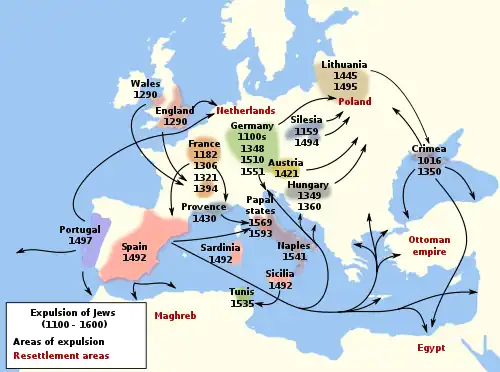 Expulsions of Jews in Europe from 1100 to 1600
Expulsions of Jews in Europe from 1100 to 1600 - ↑ Since they are considered "People of the Book" in the Islamic religion, Christians under Muslim rule were protected as dhimmi.[406][407] However, dhimmi are inferior to Muslims in Muslim culture, and Christian populations living in the lands invaded by the Arab Muslim armies between the 7th and 10th centuries AD suffered religious persecution, religious violence, forced conversion to Islam,[406][408] and martyrdom multiple times at the hands of Arab Muslim officials and rulers.[407][409][408][410] Many were executed under the Islamic death penalty for defending their Christian faith.[409][408][410] During the Umayyad Caliphate, Christians subject to Islamic rule were allowed to practice their religion with some notable limitations stemming from the apocryphal Pact of Umar. This treaty, supposedly enacted in 717 AD, forbade Christians from publicly displaying the cross on church buildings, from summoning congregants to prayer with a bell, from re-building or repairing churches and monasteries after they had been destroyed or damaged, and imposed other restrictions relating to occupations, clothing, and weapons.[411]The Umayyad Caliphate persecuted many Berber Christians in the 7th and 8th centuries AD, who slowly converted to Islam.[412] The Abbasid Caliphate was less tolerant of Christianity than had been the Umayyad caliphs.[407] Those such as Elias of Heliopolis, monks and prisoners of war who refused to convert were frequently killed.[413] Nonetheless, Christian officials continued to be employed in the government, and the Christians of the Church of the East and the Jacobite Church were often tasked with the translation of Ancient Greek philosophy and Greek mathematics.[407][414]
- ↑ Eastern Christian scientists and scholars of the medieval Islamic world (particularly Jacobite and Nestorian Christians) contributed to the Arab Islamic civilization during the reign of the Umayyad and the Abbasid, by translating works of Greek philosophers to Syriac and afterwards, to Arabic.[415][414][416] They also excelled in philosophy, science, theology, and medicine.[417][418] And the personal physicians of the Abbasid Caliphs were often Assyrian Christians such as the long serving Bukhtishu dynasty.[419] Many scholars of the House of Wisdom were of Assyrian Christian background.[420][421][414]
- ↑ Bishoprics being merely lifetime appointments, a king could better control their powers and revenues than those of hereditary noblemen. Even better, he could leave the post vacant and collect the revenues, theoretically in trust for the new bishop, or give a bishopric to pay a helpful noble.[428] The Roman Catholic Church wanted to end lay investiture to end this and other abuses, to reform the episcopate and provide better pastoral care and separation of church and state.[429] Pope Gregory VII issued the Dictatus Papae, which declared that the pope alone could appoint bishops.[429] Henry IV's rejection of the decree led to his excommunication and a ducal revolt. Eventually, Henry IV received absolution after a dramatic public penance, though the Great Saxon Revolt and conflict of investiture continued.[430]
- ↑ According to historian Elaine Graham-Leigh, Pope Innocent believed the tactical, as well as policy and strategic decisions, should be solely "the papal preserve".[449] J. Sumption and Stephen O'Shea put forth Innocent III as "the mastermind of the crusade".[450][451][448] Jean Markale, on the other hand, suggests the true architect of the campaign was the French king Philip Augustus, stating that "it was Phillip who actually petitioned Innocent for permission to conduct the Crusade".[448] Historian Laurence W. Marvin says the Pope exercised "little real control over events in Occitania".[452]
- ↑ In the first battle of the Albigensian Crusade, 22 July 1209, mercenaries rampaged through the streets of Béziers, killing all they came across, in what came to be known as the Massacre of Béziers. Four years later, in a 1213 letter to Arnaud Amaury, the papal legate who was supposed to be in charge, the pope rebuked the legate for his conduct in the war and called for an end to the campaign.[453] The campaign continued anyway. The Pope was then reversed by the Fourth Lateran council which re-instituted crusade status two years later in 1215; afterwards, the Pope removed it yet again.[454] Throughout the rest of the campaign, Innocent vacillated. Unable to make up his mind, he sometimes took the side favoring crusade then sided against it.[455]
- ↑ Spain and Sicily are the only European regions to have experienced Islamic conquest.[458] The blended Muslim, Christian and Jewish cultures that resulted from the eighth century onward left a profound imprint on Spain.[458] The Mozarabs, or more precisely Andalusi Christians,[459] were the Christians of al-Andalus, or the territories of Iberia under Muslim rule from 711 to 1492. Following the Umayyad conquest of the Visigothic Kingdom in Hispania, the Christian population of much of Iberia came under Muslim control. In Umayyad al-Andalus (the Iberian Peninsula), the Mālikī school of Islamic law was the most prevalent.[408] The martyrdoms of forty-eight Christian martyrs that took place in the Emirate of Córdoba between 850 and 859 AD[460] are recorded in the hagiographical treatise written by the Iberian Christian and Latinist scholar Eulogius of Córdoba.[409][408][410] The Martyrs of Córdoba were executed under the rule of Abd al-Rahman II and Muhammad I, and Eulogius' hagiography describes in detail the executions of the martyrs for capital violations of Islamic law, including apostasy and blasphemy.[409][408][410]
- ↑ The situation of Greater Armenia became increasingly unstable with the decline of the Mongol Ilkhâns from the 1330s onward, opening up a power vacuum facilitating the disastrous Timurid invasions of the last two decades of the century. Despite this, a resurgence of the Armenian Apostolic Church is manifest there under the forceful monastic leadership of Małak‘ia Łrimec‘i. [488] However, this decisive de ́marche in turn provoked an equally swift, unequivocal retort from influential members of the Greater Armenian clergy, who decided that the time was ripe to implement their predecessors’ frequently reiterated threats of schism. Thus in 1441 the cathedral of Ējmiacin in the ancient capital of Vałaršapat became the seat of an anti-catholicate, which soon established itself as the primary see of the whole church. The medieval Cilician episode in Armenian history had now come to an end.[489]
- ↑ Theorists such as John Kelsay and James Turner Johnson argue that these religious wars were varieties of the Just war tradition for liberty and freedom.[511] William T. Cavanaugh points out that many historians argue these ‘‘wars of religion’’ were not primarily religious, but were more about state-building, nationalism, and economics.[512] If they had been motivated most deeply by religion, Catholics would fight Protestants, whereas Catholics often formed alliances with Protestants to fight other Catholics and vice versa. Historian Barbara Diefendorf argues that religious motives were always mixed with other motives, but the simple fact of Catholics fighting Catholics and Protestants fighting Protestants is not sufficient to prove the absence of religious motives, since religious conflict is often "familial".[513] According to Marxist theorist Henry Heller, there was "a rising tide of commoner hostility to noble oppression and growing perception of collusion between Protestant and Catholic nobles".[514]
- ↑ In medieval canon law, Christian thought on this subject is represented by a passage called the Canon Episcopi. Alan Charles Kors explains that the Canon is skeptical that witches exist while still allowing the existence of demons and the devil.[536] By the mid-fifteenth century, popular conceptions of witches changed dramatically, and Christian thought denying witches and witchcraft was being challenged by the Dominicans and being debated within the church.[537][538][338]
- ↑ Anonymous publishing as a tool against censorship emerged in the late seventeenth century.[553] Protestant writers lampooned clerics, and courted public opinion, (a term being invented in the 1680s), with mockery and satire.[554] The metaphor of the "Enlightened" is first found in one of these anonymous tracts: eyes that are enlightened by the light [can see] that France . . . is in the grip of a Catholic fury.[555] It became a rallying cry that would eventually baptize the age.[556] The genre of utopian travel literature also originated among anonymous authors of the late 1600's. It wasn't until the 1720s that Montesquieu and Voltaire took it up and elevated it to what Jacob calls "canonical status" critiquing clergy, rigid doctrines, and habits of intolerance.[557]
- ↑ Thereafter, missions to the slaves attempted, Brown says, to "civilize slavery, to make slaveholding conform with the ideal of Christian servitude, and to render the institution more humane and more just."[579] However, for many owners, missionary work among the slaves was a threat that would blur social boundaries and encourage slaves to see themselves as a Christian community equal to those who held them in bondage. Masters often held religion in contempt, and typically harassed converts and forbade access to other Christians.[580]
- ↑
As early as 1555, the Portuguese Dominican Fernando Oliveira described the Atlantic slave trade as piracy and a sin. This was also the view of Tomas Mercado, a Spanish Dominican... Miguel Garcia, a Spanish Jesuit serving in Brazil, lost his teaching post in 1583 for refusing communion to Portuguese slaveholders. These slaveholders all lived in sin, Garcia insisted, since they had partaken in the injustice of the slave trade. The Jesuit Alonso de Sandoval of Cartagena stopped short of condemning the Atlantic slave system as a whole. But after having spent a half-century tending to the involuntary migrants disembarked in the South American port, he made clear his contempt for the slave trade in 1647 by graphically describing in print the horrors of the Atlantic crossing.[581] ... The deputy to the Bishop of Cuba in 1681 excom- municated two Capuchin missionaries who had begun urging slaveholders to liberate their slaves and had denied absolution to those who refused... a formal declaration by the Holy Office in 1686 that endorsed each of the antislavery propositions put forward by the excommunicated Capuchin missionaries... would be the last antislavery statement to emerge from Rome for a century and a half.[582]
- ↑ By October 1944, 45% of all pastors and 98% of non-ordained vicars and candidates had been drafted into military service; 117 German pastors of Jewish descent served at this time, and yet at least 43% fled Nazi Germany because it became impossible for them to continue in their ministries.[616]
- ↑ Executed along with her were: Grand Duke Sergei Mikhailovich Romanov; the Princes Ioann Konstantinvich, Konstantin Konstantinovich, Igor Konstantinovich and Vladimir Pavlovich Paley; Grand Duke Sergei's secretary, Fyodor Remez; and Varvara Yakovleva, a sister from the Grand Duchess Elizabeth's convent.
- ↑ "One of the first assignments of state atheism was the eradication of religion. In their attempt to destroy faith in God, Soviet authorities used all means of persecution, arrests and trials, imprisonment in psychiatric hospitals, house raids and searches, confiscations of Bibles and New Testaments and other Christian literature, disruption of worship services by the militia and KGB, slander campaigns against Christians in magazines and newspapers, on TV and radio. Persecution of Evangelical Baptists was intensified in the early 1960s and continues to the present".[630]
- ↑ "In the Soviet Union the Russian Orthodox Church was suffering unprecedented persecution. The closing and destruction of churches and monasteries, the sate atheism imposed on all aspects of life, the arrest, imprisonment, exile and execution of bishops, clergy, monastics, theologians and tens of thousands of active members had brought the Church to prostration. The voice of the Church in society as silenced, its teaching mocked, its extinction predicted".[631]
- ↑ "One of the main activities of the League of Militant Atheists was the publication of massive quantities of anti-religious literature, comprising regular journals and newspapers as well as books and pamphlets. The number of printed pages rose from 12 million in 1927 to 800 million in 1930. All these legislative and publicistic efforts were, however, only incidental to the events of the 1930s. During this period religion, was quite simply, to be eliminated by means of violence. With the end of NEP came the start of forced collectivisation in 1929, and with it the terror, which encompassed kulaks and class enemies of all kinds, including bishops, priests, and lay believers, who were arrested, shot and sent to labour camps. Churches were closed down, destroyed, converted to other uses. The League of Militant Atheists apparently adopted a five-year plan in 1932 aimed at the total eradication of religion by 1937".[632]
References
- 1 2 3 4 5 6 7 Wilken 2013, pp. 6–16.
- 1 2 Wylen 1995, pp. 190–193.
- ↑ Hopkins 1998, p. 192.
- 1 2 Judge 2010, p. 4.
- ↑ Trombley 1985, pp. 327–331.
- ↑ Humfress 2013, pp. 3, 76, 83–88, 91.
- ↑ Wilken 2013, pp. 75–87.
- ↑ Wilken 2013, pp. 88–98.
- ↑ Roman Catholicism, "[Christianity] has been the decisive spiritual force in the history of Western civilization". Encyclopædia Britannica
- ↑ Hayes, Carlton J.H. (1953). Christianity and Western Civilization, Stanford University Press, p. 2: That certain distinctive features of our Western civilization—the civilization of western Europe and of America—have been shaped chiefly by Judaeo – Graeco – Christianity, Catholic and Protestant.
- ↑ Jose Orlandis, 1993, "A Short History of the Catholic Church," 2nd edn. (Michael Adams, Trans.), Dublin: Four Courts Press, ISBN 1851821252, preface, see , accessed 8 December 2014. p. (preface)
- ↑ Thomas E. Woods and Antonio Canizares, 2012, "How the Catholic Church Built Western Civilization," Reprint ed., Washington, D.C.: Regnery History, ISBN 1596983280, see accessed 8 December 2014. p. 1: "Western civilization owes far more to the Catholic Church than most people—Catholic included—often realize. The Church in fact built Western civilization."
- ↑ Marvin Perry (1 January 2012). Western Civilization: A Brief History, Volume I: To 1789. Cengage Learning. pp. 33–. ISBN 978-1-111-83720-4.
- ↑ Wilken 2013, pp. 238–245, 257–268, 269–278.
- 1 2 Corrigan & Neal 2010, pp. 125–146.
- 1 2 3 Stannard 1992, pp. 57–146.
- 1 2 3 Thornton 1987, pp. 42–158.
- 1 2 Pew Research 2011.
- ↑ Jan Pelikan, Jaroslav (13 August 2022). "Christianity". Encyclopædia Britannica.
It has become the largest of the world's religions and, geographically, the most widely diffused of all faiths.
- ↑ Jenkins 2011, pp. 101–133.
- ↑ Freston 2008, pp. 109–133.
- ↑ Robbins 2004, pp. 117–143.
- ↑ Robert 2000, pp. 50–58.
- ↑ Young 2006, p. 1.
- ↑ Levine 2006, p. 4.
- 1 2 Maier 1989, pp. 113–129.
- ↑ Köstenberger, Kellum & Quarles 2012, p. 40.
- ↑ Köstenberger, Kellum & Quarles 2009, p. 114.
- ↑ Gillman 2003, pp. 25–30.
- ↑ Hoehner 1983, pp. 125–127.
- ↑ Novak 2001, pp. 302–303.
- ↑ Hoehner 1978, pp. 29–37.
- ↑ Law 2011, p. 129.
- ↑ McGrath 2011.
- ↑ Ehrman 1999, p. 285.
- ↑ Eddy & Boyd 2007, pp. 344–351.
- ↑ Young 2006, p. 1; 8-9.
- ↑ Young 2006, p. 8.
- ↑ Young 2006, p. 9.
- ↑ Davies & Finkelstein 2003, pp. 524–533.
- ↑ Davies, Horbury & Sturdy 2001, pp. 94–167.
- ↑ Schwartz 2009, p. 49.
- ↑ Rankin 2016, pp. 1–2.
- ↑ Rankin 2016, p. 2.
- ↑ Rankin 2016, p. 3.
- ↑ Schott 2008, p. 2.
- ↑ Moss 2012, p. 129.
- ↑ Rives 1999, p. 141.
- ↑ Croix 2006, pp. 139–140.
- ↑ Gaddis 2005, pp. 30–31.
- ↑ Acts 11:26 "and when he had found him, he brought him to Antioch. So it was that for an entire year they met with the church and taught a great many people, and it was in Antioch that the disciples were first called 'Christians.'"
- 1 2 Ehrman 2005, pp. 95–112.
- ↑ Esler 1994, p. 50.
- ↑ Wilken 2013, p. 18.
- ↑ Acts 9:1–2
- ↑ Acts 11:26
- ↑ Klutz 2002, pp. 178–190.
- ↑ Thiessen 2014, pp. 373–391.
- ↑ Seifrid 1992, pp. 310–211, 246–247.
- ↑ Bokenkotter 2007, p. 18.
- ↑ Rajak 2006, p. 53.
- 1 2 Rajak 2006, p. 56.
- ↑ de Pressensé 1870, p. 21.
- ↑ Hengel 2003, pp. 1–20.
- ↑ Hengel 2003, p. 5.
- ↑ Hengel 2003, pp. 5, 10–12.
- ↑ Kolp 1982, p. 223.
- ↑ Hengel 2003, pp. 38, 125–128.
- ↑ Neely 2020, p. 4.
- ↑ Abulafia 2017, p. xi.
- ↑ Robert 2009, p. 1.
- ↑ Hopkins 1998, p. 202.
- 1 2 Harnett 2017, pp. 200, 217.
- ↑ Hopkins 1998, p. 193.
- ↑ Wilken 2013, p. 4; 235.
- ↑ Wilken 2013, p. 4.
- ↑ Wilken 2013, p. 235.
- ↑ Wilken 2013, p. 238.
- 1 2 Trevett 2006, p. 314.
- 1 2 Trevett 2006, p. 328.
- ↑ Trevett 2006, pp. 328–329.
- ↑ Mitton 2002, p. 1.
- ↑ Blevins 1990, pp. 615–616.
- ↑ Bruce 1978, pp. 339–341.
- ↑ Laale 2011, p. 313.
- ↑ Trevett 2006, pp. 324, 327.
- ↑ Trevett 2006, pp. 320, 325–327.
- ↑ Pearson 2006, p. 331.
- ↑ Pearson 2006, pp. 331–332.
- 1 2 3 4 Pearson 2006, p. 332.
- ↑ Pearson 2006, p. 334.
- ↑ Pearson 2006, pp. 331–334.
- 1 2 3 Pearson 2006, p. 337.
- ↑ Pearson 2006, p. 335.
- 1 2 Pearson 2006, pp. 335–336.
- ↑ Pearson 2006, pp. 331, 334–335.
- ↑ Pearson 2006, pp. 337, 338.
- ↑ Pearson 2006, p. 338.
- ↑ Pearson 2006, p. 344.
- 1 2 Pearson 2006, p. 336.
- ↑ Pearson 2006, pp. 345, 349.
- ↑ Harvey 2006, pp. 351, 353.
- ↑ Harvey 2006, p. 352.
- ↑ Harvey 2006, p. 356.
- ↑ Harvey 2006, p. 362.
- ↑ Harvey 2006, p. 360.
- ↑ Harvey 2006, p. 363.
- ↑ Harvey 2006, p. 364.
- ↑ Behr 2006, p. 369.
- ↑ Behr 2006, pp. 370–371, 372–374.
- ↑ Behr 2006, pp. 370–371.
- ↑ Behr 2006, p. 370.
- ↑ Behr 2006, p. 378.
- ↑ Tilley 2006, p. 386.
- 1 2 Tilley 2006, pp. 393–395.
- ↑ Tilley 2006, pp. 387-388: 391.
- 1 2 3 4 Tilley 2006, p. 388.
- ↑ Tilley 2006, p. 390.
- ↑ Tilley 2006, p. 389.
- ↑ Tilley 2006, p. 391.
- ↑ Edmundson 2008, p. 1.
- ↑ Edmundson 2008, pp. 8–9.
- ↑ Edmundson 2008, p. 14.
- ↑ Edmundson 2008, p. 44, 47.
- ↑ Vinzent 2006, p. 397.
- ↑ Hartog 2015, p. 242.
- ↑ Robinson & Robinson 1988, p. 36.
- ↑ Sanmark 2004, p. 15.
- ↑ Carrington 1957, pp. 375–376.
- ↑ Horrell 1997, p. 324.
- ↑ Brown 2010, Intro. and ch. 1.
- ↑ Barton 1998a, p. 14.
- ↑ Porter 2011, p. 198.
- ↑ Noll 1997, pp. 36–37.
- ↑ De Jonge 2003, p. 315.
- ↑ Brown 2010, Intro..
- ↑ Koenig 2009, p. 31, "The Bible is the most globally influential and widely read book ever written. ... it has been a major influence on the behavior, laws, customs, education, art, literature, and morality of Western civilization".
- ↑ Burnside 2011, p. XXVI.
- ↑ Grant 2020, p. v.
- ↑ Duncan 2008, p. 669.
- ↑ Haykin 2011, p. 16.
- ↑ Meeks 2003, p. 79.
- ↑ Judge 2010, p. 214.
- ↑ Van Dam 1985, p. 2.
- ↑ Meeks 2003, p. 81.
- ↑ Lieu 1999, pp. 20–21.
- ↑ Praet 1992, p. 45–48.
- ↑ Wright 2016, p. 4.
- 1 2 Trebilco 2017, pp. 85, 218.
- ↑ Praet 1992, p. 68;108.
- ↑ Ulhorn 1883, pp. 2–44, 321.
- ↑ Schmidt 1889, pp. 245–256.
- ↑ Crislip 2005, p. 46.
- 1 2 Vaage 2006, p. 220.
- ↑ Muir 2006, p. 218.
- ↑ Yasin 2005, p. 433.
- ↑ Hellerman 2009, p. 6.
- ↑ Harper 2013, pp. 4, 7, 14–18.
- 1 2 Trevett 2006, p. 319.
- ↑ Trevett 2006, p. 320.
- ↑ Trevett 2006, p. 325.
- ↑ Pearson 2006, pp. 342–344.
- ↑ Hartog 2015, pp. 247–248.
- ↑ Trevett 2006, pp. 325, 326.
- ↑ Matthews & Platt 1991, p. 163.
- ↑ Matthews & Platt 1991, p. 164.
- ↑ Matthews & Platt 1991, pp. 198–199.
- ↑ Cameron 2006b, p. 538.
- 1 2 Cameron 2006b, p. 542.
- 1 2 Cameron 2006b, pp. 538, 544.
- 1 2 3 Cameron 2006b, p. 546.
- 1 2 Gerberding & Moran_Cruz 2004, pp. 55–56.
- 1 2 Cameron 2006b, p. 545.
- ↑ Southern 2015, p. 455–457.
- ↑ Bayliss 2004, p. 243.
- ↑ Leithart 2010, p. 302.
- 1 2 Cameron 2006b, p. 547.
- ↑ Cameron 2006b, p. 551.
- ↑ Clark 2011, pp. 1–4.
- ↑ Ghosh 2016, p. 116.
- ↑ Padberg 1998, p. 48.
- ↑ Clark 2011, pp. 36–38.
- ↑ Roe 1980, p. 101.
- ↑ Barton 2009, p. 13-14.
- ↑ García-Arenal & Glazer-Eytan 2019, pp. 5–6.
- ↑ García-Arenal & Glazer-Eytan 2019, pp. 5–6, 15.
- ↑ Matthews & Platt 1991, p. 181.
- ↑ Ekonomou 2007, pp. 245–247.
- ↑ Miller 1974, p. 79–81.
- ↑ Salzman 2021, pp. 335–336.
- ↑ Ekonomou 2007, pp. 63–64.
- ↑ Gregory 1986, p. 232.
- ↑ Brown 1961b, p. 85.
- ↑ Abulafia 2002, p. xii.
- ↑ Bachrach 1977, p. 3.
- ↑ Cohen 1998, pp. 78–80.
- ↑ Roth 1994, pp. 1–17.
- ↑ Aguzzi 2017, pp. xi, 3, 5, 12, 25, 133.
- ↑ Vlach 2010, p. 27.
- ↑ Nicholls 1993, p. 169.
- ↑ Kim 2006, pp. 8, 9.
- 1 2 Brown 2003, p. 74.
- ↑ Drake 1995, pp. 3, 7.
- ↑ Bradbury 1995.
- ↑ Boyd 2005, p. 16.
- 1 2 Bradbury 1995, p. 331.
- ↑ Cameron 2011, pp. 45, 67.
- ↑ Kahlos 2019, p. 35.
- ↑ Boyd 2005, p. 21.
- ↑ Brown 1998, p. 638.
- ↑ Digeser 2000, pp. 168–169.
- ↑ Thompson 2005, p. 93.
- ↑ Bradbury 1995, p. 123.
- ↑ Lavan & Mulryan 2011, pp. xxvii, xxiv.
- ↑ Trombley 1995a, pp. 166–168.
- ↑ Trombley 1995b, pp. 335–336.
- ↑ Bradbury 1995, p. 131.
- ↑ Bayliss 2004, p. 31.
- ↑ Trombley 2001, pp. 246–282.
- ↑ Bayliss 2004, p. 110.
- ↑ Wiemer 1994, p. 523.
- ↑ Bayliss 2004, p. 30.
- ↑ Bradbury 1995, p. 132.
- 1 2 Leone 2013, p. 82.
- ↑ Leone 2013, p. 28.
- ↑ Lavan 2011, p. xxvi.
- ↑ Leone 2013, p. 2.
- ↑ Bradbury 1995, p. 353.
- ↑ Brown 2003, p. 60.
- ↑ Leone 2013, p. 29.
- ↑ Brown 1993, pp. 89–106.
- ↑ Brown 2003, p. 643.
- ↑ Salzman 1993, pp. 362–378.
- ↑ Brown 1998, p. 634,640,651.
- ↑ Cohan 2005, p. 333.
- ↑ Rapp 2007, p. 138.
- ↑ Brita 2020, p. 252.
- ↑ Salzman 1993, pp. 362–365.
- ↑ Ehrman 2018, p. 14.
- ↑ Salzman 1993, p. 364.
- ↑ Sáry 2019, pp. 67, 70.
- ↑ Sáry 2019, pp. 72–74, fn. 32, 33, 34, 77.
- ↑ Sáry 2019, pp. 71–73, 77.
- ↑ Sáry 2019, pp. 73, 77.
- ↑ Sáry 2019, p. 79.
- ↑ Sáry 2019, p. 73.
- ↑ Ehrman 2018, pp. 251, 258.
- ↑ MacMullen 1986, p. 4.
- ↑ Cameron 1993, p. 74 (note 177).
- ↑ Errington 2006, pp. 248–249.
- ↑ Hebblewhite 2020, chapter 8.
- ↑ Errington 1997, p. 398.
- 1 2 Errington 1997, p. 435.
- ↑ Errington 2006, p. 251.
- ↑ Cameron 2011, p. 71.
- ↑ Constantelos 1964, p. 372.
- ↑ Brown 1998, pp. 641, 645.
- ↑ Cameron 2011, p. 801.
- 1 2 Matthews & Platt 1991, p. 185.
- 1 2 Berndt & Steinacher 2014.
- ↑ Kohler & Krauss n.d.
- ↑ Sabo & 2018, p. vii.
- ↑ Adams 2021, pp. 366–367.
- 1 2 Micheau 2006, p. 375.
- ↑ Bussell 1910, p. 346.
- ↑ Brown 1993, p. 90.
- ↑ Brown 1998, p. 634.
- ↑ Brown 1998, pp. 633–634.
- ↑ Johnson 2015, p. xx.
- ↑ Brown 1998, pp. 632–635.
- ↑ Crislip 2005, p. 3.
- ↑ Crislip 2005, p. 1.
- ↑ Acts 2:42–47
- ↑ Goswami 2005–2006, pp. 1332–1333.
- 1 2 Johnston 2013, pp. 290, 548, 577.
- ↑ Johnston 2013, pp. 548–550.
- ↑ Crislip 2005, p. 8.
- ↑ Crislip 2005, pp. 68–69, 99.
- ↑ Dunn 2003, p. 137.
- ↑ Brown 2008, p. 8.
- ↑ Matthews & Platt 1991, p. 206.
- ↑ Brown 2008, pp. 7–8.
- ↑ Blainey 2011, pp. 214–215.
- 1 2 Butler 1919, intro..
- ↑ LeGoff 2000, p. 120.
- ↑ Dunn 2016, p. 60.
- ↑ Koenig, King & Carson 2012, pp. 22–24.
- ↑ Haight 2004, p. 273.
- ↑ Woods 2012, p. 5.
- ↑ Matthews & Platt 1991, p. 198.
- 1 2 Harney 2017, p. 103.
- ↑ Thomas 1997, p. 506–507.
- ↑ Sharpe 1995, pp. 30–33.
- ↑ Wood 2007, pp. 20–22.
- ↑ Brown 2003, p. 137.
- ↑ Nelson 1996, p. 100.
- ↑ Dean 2015, p. 15.
- ↑ Lund 2022, p. 113.
- ↑ Scholz & Rogers 1970, pp. 50–53.
- ↑ Riché 1993, p. 105.
- ↑ Riché 1993, pp. 105, 161.
- ↑ Barbero 2004, p. 46.
- ↑ Riché 1993, p. 299.
- ↑ Paul 2016, p. 60.
- ↑ Collins 1998, p. 1.
- ↑ Muzdakis 2020.
- ↑ Brown 2008, p. 5.
- ↑ Brown 2008, pp. 3, 5–6.
- ↑ Brown 2008, p. 3.
- ↑ Halsall 2021.
- 1 2 Brown 2008, p. 14.
- ↑ Štefan 2022, p. 112.
- ↑ Veszprémy 2001, p. 87.
- 1 2 Štefan 2022, p. 101.
- ↑ Ivanič 2016, pp. 124–125.
- ↑ Ivanič 2016, pp. 126, 129.
- 1 2 Ivanič 2016, p. 127.
- ↑ Schaff 1953, pp. 161–162.
- ↑ Den Heijer 2011, p. 65, "Many of the medieval universities in Western Europe were born under the aegis of the Catholic Church, usually as cathedral schools or by papal bull as Studia Generali".
- ↑ Gavroglu 2015, p. 302.
- ↑ Dawson 2015, p. 103.
- ↑ Verger 1995, p. 257.
- ↑ Rüegg 1992, pp. xix–xx.
- 1 2 3 4 Matthews & Platt 1991, p. 221.
- ↑ Riché 1978, pp. 126–127, 282–298.
- ↑ Piron 2006, pp. 404–406.
- ↑ Rubin & Simons 2009, p. i.
- 1 2 Constable 1998, pp. 4–5.
- ↑ Matthews & Platt 1991, p. 215.
- ↑ Constable 1998, p. 4.
- ↑ Matthews & Platt 1991, p. 216.
- ↑ Matthews & Platt 1991, p. 216, 218.
- 1 2 Matthews & Platt 1991, p. 218.
- ↑ Fox 1987, p. 298.
- ↑ Jestice 1997, p. 1, 5–6.
- 1 2 Matthews & Platt 1991, p. 219.
- ↑ Duni 2016, pp. 204–205.
- 1 2 Champion 2011, p. 183.
- ↑ Matthews & Platt 1991, p. 217.
- ↑ Matthews & Platt 1991, pp. 217–218.
- ↑ Shahar 2003, p. 33.
- ↑ Witte 1997, pp. 20–23.
- ↑ Witte 1997, pp. 29, 36.
- ↑ Witte 1997, pp. 20, 25.
- ↑ Shahar 2003, p. 18.
- ↑ Oestereich 1907.
- ↑ Hunt 2020.
- ↑ Fulton 2009, pp. 284–285.
- ↑ Fulton 2009, pp. 284, 294.
- ↑ Fulton 2009, pp. 295, 285.
- ↑ Hollywood 2009, pp. 298–299.
- ↑ Ocker 2009, p. 493.
- ↑ Matthews & Platt 1991, p. 279.
- 1 2 Matthews & Platt 1991, p. 299.
- ↑ Hall, Battani & Neitz 2004, p. 100.
- ↑ Grant 1996, Back cover.
- ↑ Matthews & Platt 1991, p. 251.
- 1 2 Numbers 2010, pp. 80–81.
- ↑ Noll 2009, p. 4.
- ↑ Lindberg & Numbers 1986, pp. 5, 12.
- ↑ Gilley 2006, p. 164.
- 1 2 Arnold 2018, pp. 165–168.
- 1 2 Fredriksen 2009, pp. 564–578.
- ↑ Baskin & Seeskin 2010, p. 120.
- ↑ Rosenthal 1956, pp. 68–72.
- ↑ Schacter 2011, p. 2.
- 1 2 Moore 2007, p. 7.
- ↑ Schacter 2011, p. 58.
- ↑ Shatzmiller 1974, p. 339.
- ↑ Moore 2007, p. 87.
- ↑ Moore 2007, pp. vi, 154.
- ↑ Arnold 2018, pp. 166–167, 172.
- ↑ Matthews & Platt 1991, pp. 209–210.
- ↑ Moore 2007, pp. 4, 5, 132.
- ↑ Johnson & Koyama 2019, pp. 7, 8.
- ↑ Schacter 2011, p. 2, 58.
- ↑ Waugh & Diehl 2002, p. 224.
- ↑ Cotts 2012, pp. 8–10.
- ↑ Moore 2007, pp. 146–154.
- 1 2 Hastings, Mason & Pyper 2000, p. 382.
- ↑ Black 2016, p. 771.
- ↑ Peters n.d.
- ↑ Berman 2009, pp. 86, 115.
- ↑ Troianos & Velissaropoulou-Karakosta 1997, p. 340.
- ↑ Chamberlin 1986, p. 131.
- 1 2 3 4 5 6 Matthews & Platt 1991, p. 248.
- ↑ Schrader 1936, pp. 259–282.
- ↑ Ullmann 2005, p. xv.
- ↑ Matthews & Platt 1991, p. 248–250.
- ↑ Kelly 2009, p. 104.
- ↑ Olson 1999, p. 348.
- ↑ Matthews & Platt 1991, pp. 273–278.
- ↑ Ames 2009, p. 1.
- ↑ Pennington & Hartmann 2016, pp. 20–21, 35.
- 1 2 3 Ames 2009, p. 16.
- ↑ Deane 2022, p. xv.
- ↑ Ames 2009, pp. 1–2, 4, 7, 16.
- ↑ Matthews & Platt 1991, p. 243.
- 1 2 3 4 5 Estep 1986, pp. 58–77.
- ↑ Matthews & Platt 1991, p. 249.
- 1 2 3 Frassetto 2007, pp. 175–198.
- ↑ Matthews & Platt 1991, p. 150.
- ↑ Haberkern 2016, pp. 1–3.
- ↑ Frassetto 2007, pp. 151–174.
- ↑ Matthews & Platt 1991, p. 192.
- 1 2 Stillman 1998, pp. 22–28.
- 1 2 3 4 Runciman 1987, pp. 20–37.
- 1 2 3 4 5 6 Fierro 2008, pp. 137–164.
- 1 2 3 4 Sahner 2020, pp. 1–28.
- 1 2 3 4 Trombley 1996, pp. 581–582.
- ↑ Armstrong 2002.
- ↑ Speel 1960, pp. 379–397.
- ↑ Kazhdan & Talbot 1998, pp. 34, 41–42, 70.
- 1 2 3 Brague 2009, p. 164.
- ↑ Hill 1993, p. 4.
- ↑ Ferguson 2011, p. 100 "It was in the Near and Middle East and North Africa that the old traditions of teaching and learning continued, and where Christian scholars were carefully preserving ancient texts and knowledge of the ancient Greek language".
- ↑ Kaser 2011, p. 135.
- ↑ Britannica 2023.
- ↑ Bonner, Ener & Singer 2003, p. 97.
- ↑ Hyman & Walsh 1973, p. 204.
- ↑ Lettinck 2006, p. 304.
- ↑ Folda 1995, p. 141.
- ↑ Marshall 1994, p. 1.
- ↑ Kostick 2010, pp. 2–6.
- ↑ Matthews & Platt 1991, pp. 192–195.
- ↑ Grzymała-Busse 2023, p. 51.
- ↑ Garrett 1987, pp. 5–7.
- 1 2 Grzymała-Busse 2023, pp. 51–52.
- 1 2 Grzymała-Busse 2023, p. 25.
- ↑ Garrett 1987, p. 8.
- 1 2 Grzymała-Busse 2023, p. 52.
- ↑ Vaughn 1980, pp. 61–86.
- 1 2 3 Fonnesberg-Schmidt 2007, p. 65.
- ↑ Fonnesberg-Schmidt 2007, p. 23.
- ↑ Christiansen 1997, p. 71.
- ↑ Fonnesberg-Schmidt 2009, p. 119.
- ↑ Christiansen 1997, p. 287.
- ↑ Hunyadi & Laszlovszky 2001, p. 606.
- ↑ Fonnesberg-Schmidt 2007, pp. 65, 75–77.
- ↑ Firlej 2021–2022, p. 121.
- ↑ Fonnesberg-Schmidt 2007, p. 24.
- ↑ Dollinger 1999, p. 34.
- ↑ Forstreuter 1938, p. 9.
- ↑ Christiansen 1997, pp. 14–15.
- ↑ Graham-Leigh 2005, p. 48.
- ↑ Marvin 2008, pp. 3, 4.
- ↑ Kienzle 2001, pp. 46, 47.
- 1 2 3 Rummel 2006, p. 50.
- ↑ Graham-Leigh 2005, p. 56.
- ↑ Sumption 2011, p. 50.
- ↑ O'Shea 2001, p. 54.
- ↑ Marvin 2008, p. 258.
- ↑ Graham-Leigh 2005, p. 58.
- ↑ Marvin 2008, p. 235.
- ↑ Marvin 2008, pp. 229, 235–236.
- ↑ Marvin 2008, p. 216.
- ↑ Dunbabin 2003, pp. 178–179.
- 1 2 Barton 2009, p. xvii.
- ↑ Bennison 2016, p. 166.
- ↑ Graves 1964, p. 644.
- 1 2 Tarver & Slape 2016, pp. 210–212.
- ↑ Rawlings 2006, pp. 1–2.
- ↑ Bernardini & Fiering 2001, p. 371.
- ↑ Catlos 2014, p. 281.
- ↑ Mathew 2018, pp. 52–53.
- ↑ Kamen 2014, p. 182.
- ↑ Casanova 1994, p. 75.
- 1 2 Meyendorff 1979, p. intro..
- ↑ Lorenzetti 2023.
- 1 2 3 Shepard 2006, p. 3.
- ↑ Hudson 2023.
- ↑ Barton 1998b, p. vii.
- ↑ Morris & Ze'evi 2019, pp. 3–5.
- ↑ Angold 2006, p. 253.
- 1 2 Micheau 2006, p. 373.
- ↑ Micheau 2006, pp. 373, 381.
- 1 2 Micheau 2006, p. 381.
- ↑ Micheau 2006, pp. 381–382.
- ↑ Micheau 2006, p. 376.
- ↑ Micheau 2006, pp. 376–377.
- ↑ Micheau 2006, p. 377.
- 1 2 Micheau 2006, p. 378.
- ↑ Golden 2011, p. 47.
- ↑ Baum & Winkler 2003, pp. 112–123.
- 1 2 Cowe 2006, p. 404.
- ↑ Cowe 2006, pp. 404–405.
- ↑ Cowe 2006, p. 405.
- ↑ Cowe 2006, p. 428.
- ↑ Cowe 2006, p. 429.
- ↑ Ostler 2015.
- ↑ Whitt & Clarke 2019, pp. 44–70, 71–100.
- ↑ Matthews & Platt 1991, p. 304.
- ↑ Nowell, Magdoff & Webster 2022.
- ↑ Robinson 1952, p. 152.
- ↑ Gonzalez 2010b, p. 418.
- ↑ de Juan & Pierskalla 2017, p. Conditions at Times of Colonial Intervention.
- ↑ de Juan & Pierskalla 2017, p. Colonial Legacies and Economic Development.
- ↑ Pointer 2011, pp. 168–194.
- ↑ Fahlbusch & Bromiley 2003, p. 362.
- 1 2 Williams 1995, pp. xxx, xxi, xxviii.
- ↑ Williams 1995, p. xxix.
- 1 2 3 4 Matthews & Platt 1991, p. 335.
- 1 2 3 Matthews & Platt 1991, p. 336.
- ↑ MacCulloch 2004, p. 404.
- 1 2 Matthews & Platt 1991, p. 337.
- ↑ Onnekink 2016, p. 6.
- 1 2 Parker 2023.
- ↑ Onnekink 2016, p. 2.
- ↑ Engels 1978, p. 442.
- 1 2 3 4 Onnekink 2016, p. 3.
- ↑ Onnekink 2016, p. 10.
- ↑ Murphy 2014b, p. 481.
- ↑ Murphy 2014b, pp. 484–485.
- ↑ Heller 1996, p. 853–861.
- ↑ Murphy 2014b, p. 479.
- 1 2 3 4 Mout 2007, p. 229.
- ↑ Mout 2007, pp. 232, 242.
- ↑ Mout 2007, pp. 227–233, 242.
- ↑ Mout 2007, p. 238.
- ↑ Mout 2007, pp. 225–243.
- ↑ Kaplan 2009, p. 119.
- ↑ Monter 2005.
- ↑ Rawlings 2006, p. 1,2.
- ↑ Marcocci 2013, pp. 1–7.
- ↑ Mayer 2014, p. 3.
- ↑ Mayer 2014, pp. 2, 5.
- ↑ Aechtner 2015, Abstract.
- ↑ Daub 1978, pp. 553–556.
- 1 2 Foss 2014, p. 286.
- ↑ Hilliam 2004, p. 9.
- 1 2 Foss 2014, p. 285.
- ↑ Foss 2014, pp. 285–286.
- ↑ Châtellier 2006, p. 251.
- ↑ Châtellier 2006, pp. 251–252.
- ↑ Kwiatkowska 2010, p. 30.
- ↑ Kors & Peters 2001, pp. 60–63.
- ↑ Ben-Yehuda 1980, p. 5.
- ↑ Duni 2016, abstract.
- 1 2 Levack 2013, p. 6.
- 1 2 3 Monter 2023.
- ↑ Levack 2013, p. 7.
- ↑ Ankarloo, Clark & Monter 2002, p. xiii.
- ↑ Herlihy 2023.
- 1 2 3 Rosenblatt 2006, p. 283.
- 1 2 Jacob 2006, p. 265.
- ↑ Rosenblatt 2006, pp. 283–284.
- ↑ Jacob2006, pp. 268–269.
- ↑ Jacob 2006, pp. 265, 268, 270.
- ↑ Aston 2006, pp. 13–15.
- ↑ Jacob 2006, pp. 265–266.
- ↑ Jacob 2006, pp. 265–267.
- ↑ Jacob 2006, p. 272.
- ↑ Jacob 2006, p. 268.
- ↑ Jacob 2006, p. 270.
- ↑ Jacob 2006, p. 267.
- ↑ Jacob 2006, pp. 267–268.
- ↑ Jacob 2006, p. 271.
- ↑ Jacob 2006, pp. 272–273, 279.
- ↑ Marty 2006, p. 497.
- ↑ Marty 2006, p. 524.
- ↑ Ward 2006, pp. 329, 347.
- 1 2 Heyrman n.d.
- ↑ Smith 2014, p. 19.
- ↑ Valkenburgh 1994, p. 172.
- ↑ Jones & White 2012, p. xi; xv.
- ↑ Heimert 2006, p. 2.
- ↑ Ward 2006, p. 347.
- ↑ Mintz 1995, pp. 51–53.
- ↑ Mintz 1995, p. 53.
- ↑ Masters & Young 2022, abstract.
- ↑ Cairns 2015, p. 26.
- ↑ Hughes 2004, p. 635.
- ↑ Mannion & Mudge 2008, p. 217.
- ↑ Roberts 1904, p. .
- ↑ Doctrine and Covenants 1830, 21.11.
- ↑ Doctrine and Covenants 1831, 42.78.
- ↑ Doctrine and Covenants 1835, 107.59.
- ↑ Brown 2006, pp. 517–518.
- ↑ Brown 2006, p. 521.
- ↑ Brown 2006, pp. 521–523, 524.
- 1 2 Brown 2006, p. 519.
- ↑ Brown 2006, p. 520.
- ↑ Brown 2006, p. 519; 520.
- ↑ Brown 2006, p. 528.
- ↑ Brown 2006, pp. 525–528.
- ↑ Morgan, Phillip. "A Difference in Kind: The First and Second Great Awakenings". Helwys Society Forum. the HSF.com. Retrieved 4 December 2023.
- ↑ Brown 2006, pp. 529–530.
- ↑ Brown 2006, p. 530.
- ↑ Brown 2006, p. 531.
- ↑ Brown 2006, p. 533.
- ↑ Brown 2006, pp. 525–526.
- ↑ Noll 1992, p. 185.
- 1 2 McLoughlin 1984, p. abstract.
- ↑ Eder & Reyhner 2017, p. 3.
- ↑ Sanneh 2007, pp. 134–137.
- ↑ Eder & Reyhner 2017, p. 6.
- ↑ Cantoni 2015, pp. 561–598.
- ↑ Bendix 1978, p. 60.
- ↑ Boppart, Falkinger & Grossmann 2014, pp. 874–895.
- ↑ Schaltegger & Torgler 2010, pp. 99–101.
- ↑ Spater & Tranvik 2019, pp. 1963–1994.
- ↑ Becker, Pfaff & Rubin 2016.
- ↑ Weber 2003, p. .
- ↑ tutor2u 2018.
- ↑ Lloyd 2013, p. 106.
- ↑ McKinnon 2010, pp. 108–126.
- ↑ Schumpeter 1954, p. .
- ↑ Holmes 1981, p. 116.
- ↑ Vidmar 2005, pp. 332 & N. 37.
- ↑ Vidmar 2005, p. 332.
- ↑ Catholic Arrogance n.d.
- ↑ United States Holocaust Memorial Museu n.d.
- ↑ Skiles 2017, p. 4.
- ↑ Skiles 2017, pp. 4, 22–23.
- ↑ Barnett 1992, pp. 40, 59, 79–81.
- ↑ Skiles 2017, pp. 22–23.
- ↑ Green 2015, p. 203.
- ↑ Shlikhta 2004, pp. 361–273.
- ↑ Klier & Lambroza 2004, p. .
- ↑ Tabak 2000.
- ↑ Calciu-Dumitreasa 1983, pp. 5–8.
- ↑ Eidintas 2001, p. 23, "As early as August 1920 Lenin wrote to E. M. Skliansky, President of the Revolutionary War Soviet: 'We are surrounded by the greens (we pack it to them), we will move only about 10–20 versty and we will choke by hand the bourgeoisie, the clergy and the landowners. There will be an award of 100,000 rubles for each one hanged'. He was speaking about the future actions in the countries neighboring Russia".
- ↑ Calciu 1997, p. .
- ↑ Bouteneff 1998, pp. vi–1.
- ↑ Sullivan 2006.
- ↑ Rappaport 1999, p. 201, 223.
- ↑ Ostling 2001.
- ↑ Pipes 1995, p. 356.
- ↑ Yakovlev 2002, p. 165.
- ↑ United States Congress 1985, p. 129.
- ↑ Cunningham & Theokritoff 2008, p. 261.
- ↑ Ramet 2005, pp. 14–15.
- ↑ Zurlo 2015, p. 177.
- ↑ Hobson 2013, pp. 1, 3, 4.
- ↑ Hobson 2013, p. 3.
- ↑ Hobson 2013, p. 4.
- ↑ Hobson 2013, pp. 1, 4.
- ↑ Gasper 2020, p. 13.
- ↑ Harris 1998, p. 22.
- ↑ Gasper 2020, pp. 14, 18.
- ↑ Gasper 2020, p. 19.
- ↑ Harris 1998, pp. 42, 57.
- ↑ Harris 1998, p. 325.
- ↑ Fontaine 2016, pp. 6–8.
- ↑ Sanneh 2007, p. 285.
- ↑ O'Collins 2014, pp. 16–23.
- ↑ Holy See 2016.
- ↑ Chinnici 2012, p. 22.
- ↑ Cassidy 2005, p. 106.
- ↑ Pintarić 2014, p. abstract.
- ↑ Clifton 2012, p. 544.
- ↑ O'Connell 2006.
- ↑ Asprey 2008, p. 3.
- 1 2 Houtman & Aupers 2007, p. 305.
- ↑ Houtman & Aupers 2007, p. 315.
- ↑ Houtman & Aupers 2007, p. 317.
- 1 2 Táíwò 2010, pp. 68–70.
- 1 2 3 Sanneh 2007, p. xx.
- ↑ Isichei 1995, p. 9.
- ↑ Sanneh & McClymond 2016, p. 265.
- ↑ Sanneh 2007, pp. xx–xxii.
- ↑ Sanneh & McClymond 2016, p. 279; 285.
- ↑ "Religion in Africa 2022". Find Easy population & more. PEW Research Center. 26 October 2022. Retrieved 4 February 2023.
- 1 2 Isichei 1995, p. 1.
- ↑ Fernandez 1979, pp. 284, 285.
- ↑ Stoner-Eby 2008, p. 171.
- ↑ Ponce Herrero & Martí Ciriquián 2019, pp. 101–124.
- ↑ Isichei 1995, p. 2.
- ↑ Daughrity 2010, pp. 14–15.
- ↑ Jenkins 2011, pp. 89–90.
- ↑ Zurlo 2020, pp. 3–9.
- ↑ Yang 2017, p. 237.
- ↑ "Global Christianity – A Report on the Size and Distribution of the World's Christian Population" (PDF). Pew Research Center.
- 1 2 Anderson & Tang 2005, p. 2.
- ↑ "Why the Chinese government is targeting young Christians in its latest crackdown". America magazine. 14 May 2018.
A study of the religious lives of university students in Beijing published in a mainland Chinese academic journal Science and Atheism in 2013 showed Christianity to be the religion that interested students most and the most active on campuses. It concluded there was a "religious fever" in society and "religious forces were infiltrating colleges." With the support of "overseas religious forces," it said, there was a rapid growth in Christianity among university students. It said Christian fellowships on campus mostly refused to succumb to the leadership of the state-backed churches and thus posed "a problem" in the government's administration of religious affairs.
- ↑ "Conversions to Christianity Among Highly Educated Chinese". Training leaders. 14 May 2018.
- ↑ Tan, Chee-beng (2014). After Migration And Religious Affiliation: Religions, Chinese Identities And Transnational Networks. World Scientific. p. XXV. ISBN 9789814590013.
They also point out that more educated migrants and those from Hong Kong are more likely to become Christians than those from mainland China.
- ↑ "Religion and Education in Indonesia" (PDF). eCommons Cornell University. 30 January 2017.
Finally, during this century there has been a rapid growth in the number of Chinese Christians. Very few Chinese were Christians at the turn of the century. Today Christians constitute approximately 10 or 15 percent of the Chinese population in Indonesia, and probably a higher percentage among the young. Conversion of Chinese to Christianity accelerated in the 1960s, especially in East Java, and for Indonesia as a whole the proportion of Chinese who were Catholics rose from 2 percent in 1957 to 6 percent in 19.
- ↑ Taher, Amir (2020). The Persian Night: Iran Under the Khomeinist Revolution. Encounter Books. p. 343. ISBN 9781594034794.
The reason is that a growing number of Iranians, especially the young, are converting to Zoroastrianism or Christianity.
- ↑ "Report: Iran: Christian converts and house churches (1) –prevalence and conditions for religious practice Translation provided by the Office of the Commissioner-General for Refugees and Stateless Persons, Belgium" (PDF). Office of the Commissioner-General for Refugees and Stateless Persons, Belgium. 22 February 2009.
P.15: Chiaramonte (2016), that it is young people in particular who convert to Christianity in today's Iran
- ↑ W. Robinson, David (2012). International Handbook of Protestant Education. Springer Science & Business Media. p. 521. ISBN 9789400723870.
A 2006 Gallup survey, however, is the largest to date and puts the number at 6%, which is much higher than its previous surveys. It notes a major increase among Japanese youth professing Christ.
- ↑ S. Chin, Clive (2017). The Perception of Christianity as a Rational Religion in Singapore: A Missiological Analysis of Christian Conversione. Routledge. p. 166. ISBN 9781498298094.
This socio-demographic characterizes Christian converts as mostly .. (2) well-educated, (3) belonging in higher-income brackets, (4) switching their religion between ten and twenty-nine years of age
- ↑ "Religious Revival Among Chinese in Singapore" (PDF). SSA1201 Assignment. 14 May 2018.
Converts to Christianity tend to come from the young, educated, English-speaking Chinese generation
- ↑ Goh, Daniel P. S. (21 April 2010). "State and Social Christianity in Post-colonial Singapore". Sojourn: Journal of Social Issues in Southeast Asia. Journal of Social Issues in Southeast Asia. 25 (1): 54–89. doi:10.1355/SJ25-1C. JSTOR 41308136. S2CID 144235936.
Christianity has flourished in post-colonial Singapore, especially attracting conversions from among young, urbanized and English- educated.
- ↑ Sukman, Jang (2004). "Historical Currents and Characteristics of Korean Protestantism after Liberation". Korea Journal. 44 (4): 133–156.
- ↑ Albert 2018, p. n/a.
- ↑ SAHGAL et al. 2021, p. n/a.
- ↑ Frykenberg & Low 2003, p. 228.
- ↑ Burrow 2009, p. 201.
- ↑ Miller & Johnstone 2015, abstract.
- ↑ Miller & Johnstone 2015, p. 8.
- ↑ Greenberg & A. Foster 2023, pp. 105–110.
- ↑ Maghreb.
- ↑ Fox 2013, p. abstract.
Sources
Books & periodicals
- Abulafia, David (2017) [2002]. "Introduction". In Abulafia, David; Berend, Nóra Berend (eds.). Medieval Frontiers: Concepts and Practices. Routledge Taylor and Francis Group. ISBN 978-1-351-91858-9.
- Abulafia, Anna Sapir, ed. (2002). Religious Violence Between Christians and Jews: Medieval Roots, Modern Perspectives. UK: Palgrave. ISBN 978-1-34942-499-3.
- Adams, Robert Merrihew (2021). "Nestorius and Nestorianism". The Monist. 104 (3): 366–375. doi:10.1093/monist/onab005.
- Aechtner, Thomas (March 2015). "Galileo Still Goes to Jail: Conflict Model Persistence within Introductory Anthropology Materials". Zygon. 50 (1): 209–226. doi:10.1111/zygo.12149.
- Aguzzi, Steven D. (2017). Israel, the Church, and Millenarianism: A Way beyond Replacement Theology. Routledge. ISBN 978-1-317-11190-0.
- Albert, Eleanor (2018). "Christianity in China". Council on Foreign Relations.
- Ames, Christine Caldwell (2009). Righteous Persecution: Inquisition, Dominicans, and Christianity in the Middle Ages. University of Pennsylvania Press. ISBN 978-0-8122-4133-4.
- Anderson, Allan (2013). An Introduction to Pentecostalism: Global Charismatic Christianity. Cambridge University Press. ISBN 978-1-107-03399-3.
- Anderson, Allan; Tang, Edmund (2005). Asian and Pentecostal: The Charismatic Face of Christianity in Asia. Oxford Centre for Mission Studies. ISBN 9781870345439.
- Angold, Michael (2006). "THE RUSSIAN CHURCH". In Angold, Michael (ed.). The Cambridge History of Christianity Eastern Christianity. Vol. 5. Cambridge University Press. doi:10.1017/CHOL9780521811132.018.
- Ankarloo, Bengt; Clark, Stuart; Monter, E. William, eds. (2002). Witchcraft and Magic in Europe. Vol. 4: The Period of the Witch Trials. Philadelphia: University of Pennsylvania Press. ISBN 0-8122-3617-3.
- Arnold, John H. (2018). "Persecution and Power in Medieval Europe: The Formation of a Persecuting Society, by R. I. Moore". The American Historical Review. Academic OUP. 123 (1). doi:10.1093/ahr/123.1.165 (inactive 17 August 2023).
{{cite journal}}: CS1 maint: DOI inactive as of August 2023 (link) - Asprey, Christopher (2008). Murphy, Francesca Aran (ed.). Ecumenism Today: The Universal Church in the 21st Century (first ed.). Routledge. ISBN 978-0-7546-5961-7.
- Aston, Nigel (2006). "Continental Catholic Europe". In Brown, S.; Tackett, T. (eds.). The Cambridge History of Christianity. Cambridge University Press. pp. 13–32. doi:10.1017/CHOL9780521816052.003.
- Bachrach, Bernard S. (1977). Early medieval Jewish policy in Western Europe. Minneapolis: University of Minnesota Press. ISBN 0-8166-0814-8.
- Barbero, Alessandro (2004). Charlemagne: Father of a Continent. University of California Press. ISBN 978-0-520-23943-2.
- Barnett, Victoria (1992). For the Soul of the People: Protestant Protest Against Hitler. Oxford University Press. ISBN 978-0-19-512118-6.
- Barton, John (1998a). Holy Writings, Sacred Text: The Canon in Early Christianity (reprint ed.). Westminster John Knox Press. ISBN 978-0-664-25778-1.
- Barton, James Levi (1998b). Turkish Atrocities: Statements of American Missionaries on the Destruction of Christian Communities in Ottoman Turkey, 1915-1917. Armenian Genocide Documentation Series. Vol. 2. Gomidas Institute. ISBN 978-1-884630-04-0.
- Barton, Simon (2009). A History of Spain (2nd, revised ed.). Bloomsbury Publishing. ISBN 978-1-137-01347-7.
- Baskin, Judith R.; Seeskin, Kenneth (2010). The Cambridge Guide to Jewish History, Religion, and Culture. Cambridge University Press. ISBN 978-0-521-86960-7.
- Bayliss, Richard (2004). Provincial Cilicia and the Archaeology of Temple Conversion. Oxford: Archaeopress. ISBN 978-1-84171-634-3.
- Baum, Wilhelm; Winkler, Dietmar W. (2003). The Church of the East: A Concise History. London-New York: Routledge-Curzon. ISBN 978-1-134-43019-2.
- Becker, Sascha O.; Pfaff, Steven; Rubin, Jared (2016). "Causes and Consequences of the Protestant Reformation". ESI Working Paper 16–13. ISSN 2572-1496.
- Behr, John (2006). "Gaul". In Mitchell, M.; Young, F. (eds.). The Cambridge History of Christianity. Vol. 1. Cambridge University Press. pp. 366–379. doi:10.1017/CHOL9780521812399.021.
- Ben-Yehuda, Nachman (1980). "The European Witch Craze of the 14th to 17th Centuries: A Sociologist's Perspective". American Journal of Sociology. 86 (1): 1–31. doi:10.1086/227200. ISSN 0002-9602. JSTOR 2778849. S2CID 143650714.
- Bendix, Reinhard (1978). Max Weber: An Intellectual Portrait. University of California Press. ISBN 978-0-520-03194-4.
- Bennison, Amira K. (1 August 2016). The Almoravid and Almohad Empires. doi:10.1515/9780748646821. ISBN 978-0-7486-4682-1. S2CID 189477556.
- Berman, Harold J. (2009). Law and Revolution, the Formation of the Western Legal Tradition. Harvard University Press. ISBN 978-0-674-02085-6.
- Bernardini, Paolo; Fiering, Norman (2001). The Jews and the Expansion of Europe to the West, 1450 to 1800. Berghahn Books. ISBN 978-1-57181-430-2.
- Berndt, Guido M.; Steinacher, Roland (2014). Arianism: Roman Heresy and Barbarian Creed (1st ed.). London and New York: Routledge. ISBN 978-1-4094-4659-0.
- Blainey, Geoffrey (26 October 2011). A Short History of Christianity. Penguin Group Australia. ISBN 978-0-670-07524-9.
- Blevins, James L. (1990). "Revelation 1–3". Review & Expositor. 87 (4): 615–621. doi:10.1177/003463739008700411. S2CID 144517864.
- Bokenkotter, Thomas (2007). A Concise History of the Catholic Church (Revised ed.). New York: Crown Publishing Group. ISBN 978-0-307-42348-1.
- Bonner, Michael David; Ener, Mine; Singer, Amy (2003). Poverty and charity in Middle Eastern contexts. SUNY Press. ISBN 978-0-7914-5737-5.
- Boppart, Timo; Falkinger, Josef; Grossmann, Volker (1 April 2014). "Protestantism and Education: Reading (the Bible) and Other Skills" (PDF). Economic Inquiry. 52 (2): 874–895. doi:10.1111/ecin.12058. ISSN 1465-7295. S2CID 10220106. Archived (PDF) from the original on 7 March 2020.
- Father Arseny, 1893-1973: Priest, Prisoner, Spiritual Father: Being the Narratives Compiled by the Servant of God Alexander Concerning His Spiritual Father. Translated by Vera Bouteneff. St. Vladmir's Seminary Press. 1998. pp. vi–1. ISBN 978-0-88141-180-5.
- Boyd, William Kenneth (2005). The Ecclesiastical Edicts of the Theodosian Code (reprint ed.). The Lawbook Exchange, Ltd. ISBN 978-1-58477-531-7.
- Bradbury, Scott (1995). "Julian's Pagan Revival and the Decline of Blood Sacrifice". Phoenix. 49 (4): 331–56. doi:10.2307/1088885. JSTOR 1088885.
- Brague, Rémi (2009). The Legend of the Middle Ages: Philosophical Explorations of Medieval Christianity, Judaism, and Islam. University of Chicago Press. ISBN 978-0-226-07080-3.
- Bresnan, John (2005). Indonesia: The Great Transition. Rowman & Littlefield. ISBN 978-0-7425-4011-8.
Between 1966 and 1976, almost 2 million ethnic Javanese, most from nominally Islamic backgrounds, converted to Christianity. Another 250,000 to 400,000 became Hindu.
- Brita, Antonella (2020). "Genres of Ethiopian-Eritrean Christian Literature with a Focus on Hagiography". In Kelly, Samantha (ed.). A Companion to Medieval Ethiopia and Eritrea. Brill. pp. 252–281. ISBN 978-90-04-41943-8.
- Brown, Christopher (2006). "Christianity and the campaign against slavery and the slave trade". In Brown, Stewart; Tackett, Timothy (eds.). The Cambridge History of Christianity. Cambridge University Press. pp. 517–535. doi:10.1017/CHOL9780521816052.028.
- Brown, P. (1961). "Aspects of the Christianization of the Roman Aristocracy". Journal of Roman Studies. 51 (1–2): 1–11. doi:10.2307/298830. JSTOR 298830. S2CID 155251310.
- Brown, Peter (1993). "The Problem of Christianization" (PDF). Proceedings of the British Academy. Oxford University Press. 84: 89–103. Archived from the original (PDF) on 3 March 2022.
- Brown, Peter (1998). "Christianization and religious conflict". In Cameron, Averil; Garnsey, Peter (eds.). The Cambridge Ancient History XIII: The Late Empire, A.D. 337–425. Cambridge University Press. ISBN 978-0-521-30200-5.
- Brown, Peter (2003). The rise of Western Christendom: triumph and diversity, A.D. 200-1000 (2nd ed.). Malden, MA: Blackwell Publishers. ISBN 978-0-631-22137-1.
- Brown, Peter (2008). "Introduction: Christendom, c. 600". In Noble, T.; Smith, J. (eds.). The Cambridge History of Christianity. Vol. 3. Cambridge University Press. pp. 1–18. doi:10.1017/CHOL9780521817752.002. ISBN 9780521817752.
- Brown, Raymond E. (2010) [1997]. An Introduction to the New Testament. The Anchor Yale Bible Reference Library. Yale University Press. ISBN 978-0-300-14016-3. OCLC 762279536.
- Bruce, Frederick Fyvie (1978). "St John at Ephesus". Bulletin of the John Rylands Library. 60 (2): 339–361. doi:10.7227/BJRL.60.2.4.
- Bürki, Bruno (1977). "Traditional Initiation in Africa". Studia Liturgica. 12 (4): 201–206. doi:10.1177/003932077701200404. S2CID 188624108.
- Burnside, Jonathan (2011). God, Justice, and Society: Aspects of Law and Legality in the Bible. Oxford University Press. ISBN 978-0-19-975921-7.
- Bussell, Frederick William (1910). The Roman Empire: Essays on the Constitutional History from the Accession of Domitian (81 A. D.) to the Retirement of Nicephorus III (1081 A.D.). Longmans, Green.
- Burrow, William R. (2009). Redemption And Dialogue. Wipf and Stock Publishers. p. 201. ISBN 978-1-60899-116-7.
- Butler, Cuthbert (1919). Benedictine Monachism: Studies in Benedictine Life and Rule. New York: Longmans, Green and Company. pp. 3–8.
- Cairns, Earle E. (2015). An Endless Line of Splendor: Revivals and Their Leaders from the Great Awakening to the Present. Wipf and Stock Publishers. ISBN 978-1-4982-2340-9.
- Calciu, George (1997). Christ Is Calling You: A Course in Catacomb Pastorship. Saint Herman Press. ISBN 978-1-887904-52-0.
- Calciu-Dumitreasa, George (May 1983). "Sermons to young people by Father George Calciu-Dumitreasa. Given at the Chapel of the Romanian Orthodox Church Seminary". Word Magazine. Antiochian Orthodox Christian Archdiocese of North America. pp. 5–8 – via Orthodox Research Institute.
- Cameron, Alan (2011). The Last Pagans of Rome. Oxford: Oxford University Press. ISBN 978-0-19-974727-6.
- Cameron, Averil (1993). The Later Roman Empire, AD 284-430 (illustrated ed.). Harvard University Press. ISBN 978-0-674-51194-1.
- Cameron, Averil (2006b). "Constantine and the 'peace of the church'". In Mitchell, M.; Young, F. (eds.). The Cambridge History of Christianity. Vol. 1. Cambridge University Press. pp. 538–551. doi:10.1017/CHOL9780521812399.032. ISBN 9781139054836.
- Cantoni, Davide (2015). "The Economic Effects of the Protestant Reformation: Testing the Weber Hypothesis in the German Lands". Journal of the European Economic Association. 13 (4): 561–598. doi:10.1111/jeea.12117. hdl:10230/11729. ISSN 1542-4766. JSTOR 24539263. S2CID 7528944.
- Carrington, Philip (1957). The Early Christian Church: Volume 1, The First Christian Church (illustrated, reprint ed.). Cambridge University Press. ISBN 9780521166416.
- Casanova, José (1994). Public Religions in the Modern World. Chicago: The University of Chicago Press. ISBN 0-226-09535-5.
- Cassidy, Edward Idris (2005). Ecumenism and Interreligious Dialogue: Unitatis Redintegratio, Nostra Aetate. Paulist Press. ISBN 978-0-8091-4338-2.
- Catlos, Brian A. (2014). Muslims of Medieval Latin Christendom, c. 1050–1614. Cambridge University Press. ISBN 978-0-521-88939-1.
- Chamberlin, Eric Russell (1986). The Bad Popes. Dorset Press. ISBN 978-0-88029-116-3.
- Champion, Matthew (2011). "Crushing the Canon: Nicolas Jacquier's Response to the Canon Episcopi in the Flagellum haereticorum fascinariorum" (PDF). Magic, Ritual, and Witchcraft. 6 (2): 183–211. doi:10.1353/mrw.2011.0022. S2CID 73545212.
- Châtellier, Louis (2006). "Christianity and the rise of science, 1660–1815". In Brown, S.; Tackett, T. (eds.). The Cambridge History of Christianity. Vol. 7. Cambridge University Press. pp. 249–264. doi:10.1017/CHOL9780521816052.015. ISBN 9781139054126.
- Chinnici, Joseph P. (2012). "Ecumenism, Civil Rights, and the Second Vatican Council: The American Experience". U.S. Catholic Historian. 30 (3): 21–49. ISSN 0735-8318. JSTOR 23362900.
- Christiansen, Eric (1997). The Northern Crusades. London: Penguin books. ISBN 978-0-14-026653-5.
- Clark, Gillian (2011). "Augustine and the merciful Barbarians". In Mathisen, Ralph W.; Shanzer, Danuta (eds.). Romans, Barbarians, and the Transformation of the Roman World: Cultural Interaction and the Creation of Identity in Late Antiquity (illustrated ed.). Ashgate Publishing, Ltd. pp. 1–4. ISBN 978-0-7546-6814-5.
- Clifton, Shane (2012). "Ecumenism from the bottom up: A Pentecostal perspective". Journal of Ecumenical Studies. 47 (4): 576–592.
- Cohen, Jeremy (1 January 1998). ""Slay Them Not": Augustine and the Jews in Modern Scholarship". Medieval Encounters. 4 (1): 78–92. doi:10.1163/157006798X00043.
- Cohan, Sara (2005). "A brief history of the Armenian Genocide" (PDF). Social Education. 69 (6): 333–337.
- Collins, Roger (1998). Charlemagne. Toronto, Canada: University of Toronto Press. ISBN 0-8020-8218-1.
- Constable, Giles (1998). The Reformation of the Twelfth Century (illustrated, revised, reprint ed.). Cambridge University Press. ISBN 978-0-521-63871-5.
- Constantelos, Demetrios J. (1964). "Paganism and the State in the Age of Justinian". The Catholic Historical Review. 50 (3): 372–80. JSTOR 25017472.
- Corrigan, John; Neal, Lynn S., eds. (2010). "Religious Intolerance toward Native American Religions". Religious Intolerance in America: A Documentary History. Chapel Hill, North Carolina: University of North Carolina Press. pp. 125–146. doi:10.5149/9780807895955_corrigan.9. ISBN 978-0-8078-3389-6. LCCN 2009044820. S2CID 183694926.
- Cotts, John (2012). Europe's Long Twelfth Century: Order, Anxiety and Adaptation, 1095–1229. Bloomsbury Publishing. ISBN 978-1-137-29608-5.
- Cowe, S. (2006). "The Armenians in the era of the crusades 1050–1350". In Angold, Michael (ed.). The Cambridge History of Christianity Eastern Christianity. Vol. 5. Cambridge University Press. pp. 404–429. doi:10.1017/CHOL9780521811132.018. ISBN 9781139054089.
- Crislip, Andrew Todd (2005). From Monastery to Hospital: Christian Monasticism & the Transformation of Health Care in Late Antiquity. University of Michigan Press. ISBN 978-0-472-11474-0.
- Croix, G. E. M. de Sainte (2006). Whitby, Michael (ed.). Christian Persecution, Martyrdom, And Orthodoxy. Oxford: Oxford University Press. ISBN 0-19-927812-1.
- Cunningham, Mary B.; Theokritoff, Elizabeth (2008). The Cambridge Companion to Orthodox Christian Theology. Cambridge University Press. ISBN 978-0-521-86484-8.
- Daniels, Timothy P. (2017). Sharia Dynamics: Islamic Law and Sociopolitical Processes. Springer. ISBN 978-3-319-45692-8.
almost two million nominal Muslims to convert to Christianity
- Daub, Edward E. (1 December 1978). "Demythologizing White's Warfare of Science with Theology". The American Biology Teacher. 40 (9): 553–556. doi:10.2307/4446412. JSTOR 4446412.
- Daughrity, Dyron B. (2010). The Changing World of Christianity: The Global History of a Borderless Religion (illustrated ed.). Peter Lang. ISBN 978-1-4331-0452-7.
- Davies, W. D.; Finkelstein, Louis, eds. (2003) [1989]. "The Matrix of Apocalyptic". The Cambridge History of Judaism. Vol. 2: The Hellenistic Age. Cambridge aNew York: Cambridge University Press. pp. 524–533. ISBN 978-0-521-21929-7. OCLC 872998103.
- Davies, W. D.; Horbury, William; Sturdy, John, eds. (2001) [1999]. "The social, economic, and political history of Palestine 63 BCE–70 CE". The Cambridge History of Judaism. Vol. 3: The Early Roman Period. Cambridge and New York: Cambridge University Press. pp. 94–167. ISBN 978-0-521-24377-3.
- Dawson, Patricia (2015). First Peoples of the Americas and the European Age of Exploration. Cavendish Square Publishing. ISBN 978-1-5026-0685-3.
- De Jonge, H. J. (2003). "The New Testament Canon". In Auwers, Jean-Marie; De Jonge, H. J. bibliques de (eds.). The Biblical Canons. Leuven University Press. pp. 309–319. ISBN 978-2-87723-651-5.
- de Juan, Alexander; Pierskalla, Jan Henryk (2017). "The Comparative Politics of Colonialism and Its Legacies: An Introduction". Politics & Society. 45 (2 Special Issue).
- de Pressensé, Edmund (1870). The Early Years of Christianity: The Apostolic Era. Christian Classics Ethereal.
- Dean, Sidney E. (2015). "Felling the Irminsul: Charlemagne's Saxon wars". Medieval Warfare. 5 (2): 15–20. ISSN 2211-5129. JSTOR 48578430.
- Deane, Jennifer Kolpacoff (2022). A History of Medieval Heresy and Inquisition. Rowman & Littlefield. ISBN 978-1-5381-5295-9.
- Den Heijer, Alexandra (2011). Managing the University Campus: Information to Support Real Estate Decisions. Academische Uitgeverij Eburon. ISBN 978-90-5972-487-7.
- Digeser, Elizabeth DePalma (2000). The Making of a Christian Empire: Lactantius & Rome. Cornell University Press. ISBN 978-0-8014-3594-2.
- Dollinger, Philippe (1999). The German Hansa. Routledge. ISBN 978-0-415-19073-2.
- Drake, H. A. (1995). "Constantine and Consensus". Church History. 64 (1): 1–15. doi:10.2307/3168653. JSTOR 3168653. S2CID 163129848.
- Dunbabin, Jean (2003). "The Council of Bourges, 1225: a Documentary History". The English Historical Review. 118 (475): 178–179. doi:10.1093/ehr/118.475.178.
- Duncan, G. A. (March 2008). "Book Reviews - Drobner, H R 2007 – The fathers of the church: A comprehensive introduction". HTS Theological Studies. 64 (1): 669.
- Duni, Matteo (June 2016). "Doubting Witchcraft: Theologians, Jurists, Inquisitors during the Fifteenth and Sixteenth Centuries". Studies in Church History. 52: 203–231. doi:10.1017/stc.2015.12. S2CID 164173947.
- Dunn, Marilyn (2003). The Emergence of Monasticism: From the Desert Fathers to the Early Middle Ages. John Wiley & Sons. ISBN 978-1-4051-0641-2.
- Dunn, Dennis J. (2016). A History of Orthodox, Islamic, and Western Christian Political Values. Switzerland: Palgrave Macmillan. ISBN 978-3-319-32566-8.
- Eddy, Paul Rhodes; Boyd, Gregory A. (2007). The Jesus Legend: A Case for the Historical Reliability of the Synoptic Jesus Tradition. Grand Rapids, Michigan: Baker Academic. ISBN 978-0-8010-3114-4.
- Eder, Jeanne; Reyhner, Jon (2017). American Indian Education: A History (2nd ed.). University of Oklahoma Press. ISBN 978-0-8061-5991-1.
- Edmundson, George (2008). The Church in Rome in the First Century: An Examination of Various Controverted Questions Relating to its History, Chronology, Literature and Traditions (reprint ed.). Wipf and Stock. ISBN 9781556358463.
- Ehrman, Bart D. (1999). Jesus: Apocalyptic Prophet of the New Millennium. New York: Oxford University Press. ISBN 978-0-19-512473-6.
- Ehrman, Bart D. (2005) [2003]. "At Polar Ends of the Spectrum: Early Christian Ebionites and Marcionites". Lost Christianities: The Battles for Scripture and the Faiths We Never Knew. Oxford: Oxford University Press. pp. 95–112. doi:10.1017/s0009640700110273. ISBN 978-0-19-518249-1. LCCN 2003053097. S2CID 152458823.
- Ehrman, Bart D. (2018). The triumph of Christianity: How a forbidden religion swept the world. Simon and Schuster. ISBN 9781501136726.
- Eidintas, Alfonsas (2001). President of Lithuania: Prisoner of the Gulag: a Biography of Aleksandras Stulginskis. Genocide and Resistance Research Center of Lithuania. ISBN 978-9986-757-41-2.
- Ekonomou, Andrew J. (2007). Byzantine Rome and the Greek Popes: Eastern Influences on Rome and the Papacy from Gregory the Great to Zacharias, A.D. 590–752. Washington: Lexington Books. ISBN 978-0-7391-3386-6.
- Engels, Frederick (1978). "The Peasant War in Germany". Collected Works of Karl Marx and Frederick Engels. Vol. 10. Lawrence & Wishart. ISBN 978-0-85315-355-9.
- Errington, R. Malcolm (2006). Roman Imperial Policy from Julian to Theodosius. Chapel Hill: University of North Carolina Press. ISBN 978-0-8078-3038-3.
- Errington, R. Malcolm (1997). "Christian Accounts of the Religious Legislation of Theodosius I". Klio. 79 (2): 398–443. doi:10.1524/klio.1997.79.2.398. S2CID 159619838.
- Esler, Philip Francis (1994). The First Christians in Their Social Worlds Social-scientific Approaches to New Testament Interpretation. Routledge. ISBN 978-0-415-11122-5.
- Estep, William R. (1986). "Attempts at Reform: Wycliffe and Huss". Renaissance and Reformation. Grand Rapids, Michigan and Cambridge, U.K.: Wm. B. Eerdmans. pp. 58–77. ISBN 978-0-8028-0050-3.
- Fahlbusch, Erwin; Bromiley, Geoffrey William (2003). The Encyclopedia of Christianity. Wm. B. Eerdmans Publishing. ISBN 978-90-04-12654-1.
- Ferguson, Kitty (2011). Pythagoras: His Lives and the Legacy of a Rational Universe. Icon Books Limited. ISBN 978-1-84831-250-0.
- Fernandez, James W. (1979). "Africanization, Europeanization, Christianization". University of Chicago Press Journals. 18 (3): 284–292. doi:10.1086/462823. S2CID 162935593.
- Fierro, Maribel (January 2008). "Decapitation of Christians and Muslims in the Medieval Iberian Peninsula: Narratives, Images, Contemporary Perceptions". Comparative Literature Studies. Philadelphia, Pennsylvania: Penn State University Press. 45 (2: Al-Andalus and Its Legacies): 137–164. doi:10.2307/complitstudies.45.2.0137. ISSN 1528-4212. JSTOR 25659647. S2CID 161217907.
- Firlej, Dominik (2021–2022). "Why did Polish Kings not go on Crusade in the Levant?" (PDF). The Cupola. 16: 120–135.
- Folda, Jaroslav (1995). "7". In Riley-Smith, Jonathon (ed.). The Oxford Illustrated History of the Crusades. OUP. ISBN 9780198204350.
- Fonnesberg-Schmidt, Iben (2007). The popes and the Baltic crusades, 1147–1254. Brill. ISBN 978-90-04-15502-2.
- Fonnesberg-Schmidt, Iben (2009). "Pope Honorius III and Mission and Crusades in the Baltic Region". In Murray, Alan V. (ed.). The Clash of Cultures on the Medieval Baltic Frontier. Ashgate Publishing, Ltd. pp. 103–122. ISBN 978-0-7546-6483-3.
- Fontaine, Darcie (2016). Decolonizing Christianity: Religion and the End of Empire in France and Algeria. Cambridge University Press. ISBN 978-1-107-11817-1.
- Forstreuter, Kurt (1938). Deutschland und Litauen. Studien zum Detuschtum im Osten. Vol. 1. Königsberg: Ost-europa.
- Foss, Jeffrey (2014). Science and the World: Philosophical Approaches (illustrated ed.). Broadview Press. pp. 285–286. ISBN 978-1-55111-624-2.
- Fox, Jonathan (2013). "Religious discrimination against religious minorities in Middle Eastern Muslim states". Civil Wars. 15 (4): 454–470.
- Fox, Robin Lane (1987). Pagans and Christians. New York: Alfred A. Knopf. ISBN 978-0-394-55495-2.
- Frassetto, Michael (2007). Heretic Lives: Medieval Heresy from Bogomil and the Cathars to Wyclif and Hus. London: Profile Books. pp. 7–198. ISBN 978-1-86197-744-1. OCLC 666953429.
- Fredriksen, Paula (October 2009). "Review: Revisiting Augustine's Doctrine of Jewish Witness". The Journal of Religion. 89 (4): 564–578. doi:10.1086/600873. JSTOR 10.1086/600873. S2CID 170403439.
- Freston, Paul (2008). "The Changing Face of Christian Proselytization: New Actors from the Global South". In Hackett, Rosalind I. J. (ed.). Proselytization Revisited: Rights Talk, Free Markets, and Culture Wars (1st ed.). New York and London: Routledge. pp. 109–138. ISBN 978-1-84553-228-4. LCCN 2007046731.
- Frykenberg, Robert Eric; Low, Alaine M. (2003). Christians and Missionaries in India: Cross-cultural Communication Since 1500, with Special Reference to Caste, Conversion, and Colonialism. Eerdmans. ISBN 978-0-8028-3956-5.
- Fulton, Rachel (2009). "Mary". In Rubin, M.; Simons, W. (eds.). The Cambridge History of Christianity. Vol. 4. Cambridge University Press. pp. 283–296. doi:10.1017/CHOL9780521811064.020. ISBN 9781139056021.
- Gaddis, Michael (2005). There Is No Crime for Those Who Have Christ: Religious Violence in the Christian Roman Empire. Berkeley, Los Angeles, and London: University of California Press. ISBN 978-0-520-24104-6.
- García-Arenal, Mercedes; Glazer-Eytan, Yonatan (2019). Forced conversion in Christianity, Judaism and Islam: coercion and faith in premodern Iberia and beyond. Brill. ISBN 978-90-04-41682-6.
- Garrett, William R. (1987). "Religion, Law, and the Human Condition" (PDF). Sociological Analysis. OUP. 47: 1–34. doi:10.2307/3711649. JSTOR 3711649.
- Gasper, Louis (2020). The Fundamentalist Movement (reprint ed.). Walter de Gruyter GmbH & Co KG. ISBN 978-3-11-231758-7.
- Gavroglu, Kostas (2015). Sciences in the Universities of Europe, Nineteenth and Twentieth Centuries: Academic Landscapes. Springer. ISBN 978-94-017-9636-1.
- Gerberding, R.; Moran Cruz, J. H. (2004). Medieval Worlds. New York: Houghton Mifflin Company. ISBN 978-0-395-56087-7.
- Ghosh, Shami (2016). "Paul the Deacon and the Ancient History of the Lombards". Writing the Barbarian Past: Studies in Early Medieval Historical Narrative. Brill. pp. 115–152. ISBN 978-90-04-30522-9.
- Gilley, Sheridan (2006). The Cambridge History of Christianity. Vol. 8, World Christianities c. 1815 – c. 1914. Brian Stanley. Cambridge University Press. ISBN 0-521-81456-1.
- Gillman, Florence Morgan (2003). Herodias: At Home in that Fox's Den. Liturgical Press. ISBN 978-0-8146-5108-7.
- Golden, Peter B. (14 January 2011). Central Asia in World History. Oxford University Press. ISBN 978-0-19-972203-7.
- Goswami, Anita (2005–2006). "Hermit to Cenobitic: A Study in Early Christian Monasticism". Proceedings of the Indian History Congress. 66: 1329–1335. JSTOR 44145947.
- Gonzalez, Justo L. (2010b). The Story of Christianity. Vol. 2: The Reformation to the Present Day. HarperCollins. ISBN 978-0-06-185589-4.
- Graham-Leigh, Elaine (2005). The Southern French Nobility and the Albigensian Crusade. Rochester, NY: The Boydell Press. ISBN 1-84383-129-5.
- Grant, Edward (28 October 1996). The Foundations of Modern Science in the Middle Ages: Their Religious, Institutional and Intellectual Contexts. Cambridge University Press. ISBN 978-0-521-56762-6.
- Grant, Robert M. (2020). The Apostolic Fathers, A New Translation and Commentary. Vol. I: An Introduction. Wipf and Stock Publishers. ISBN 978-1-7252-7423-5.
- Graves, Coburn V. (November 1964). "The Martyrs of Cordoba, 850–859. A Study of the Sources (review)". The Hispanic American Historical Review. Durham, North Carolina: Duke University Press on behalf of the Conference on Latin American History. 44 (4). doi:10.1215/00182168-44.4.644. ISSN 1527-1900. S2CID 227325750.
- Green, Clifford (January 2015). "Peace Ethic or "Pacifism"?: An Assessment of Bonhoeffer the Assassin?". Modern Theology. 31 (1): 201–208. doi:10.1111/moth.12144.
- Greenberg, Udi; A. Foster, Elizabeth (2023). Decolonization and the Remaking of Christianity. Pennsylvania: University of Pennsylvania Press. pp. 105–110. ISBN 9781512824971.
- Gregory, Timothy E. (1986). "The Survival of Paganism in Christian Greece: A Critical Essay". The American Journal of Philology. 107 (2): 229–242. doi:10.2307/294605. ISSN 0002-9475. JSTOR 294605.
- Grzymała-Busse, Anna M. (2023). Sacred Foundations: The Religious and Medieval Roots of the European State (illustrated ed.). Princeton University Press. ISBN 978-0-691-24513-3.
- Haberkern, Phillip N. (2016). Patron Saint and Prophet: Jan Hus in the Bohemian and German Reformations. Oxford University Press. ISBN 9780190280741.
- Haight, Roger D. (2004). Christian Community in History. Vol. 1: Historical Ecclesiology. New York: The Continuum International Publishing Group. ISBN 0-8264-1630-6.
- Hall, John R.; Battani, Marshall; Neitz, Mary Jo (2004). Sociology On Culture. Taylor & Francis. ISBN 978-1-134-45237-8.
- Harnett, Benjamin (2017). "The Diffusion of the Codex". Classical Antiquity. University of California Press. 36 (2): 183–235. doi:10.1525/ca.2017.36.2.183. JSTOR 26362608.
- Harney, Lorcan (2017). "Christianising Pagan Worlds in Conversion-Era Ireland: Archaeological Evidence for the Origins of Irish Ecclesiastical Sites". Proceedings of the Royal Irish Academy: Archaeology, Culture, History, Literature. 117C: 103–30. doi:10.3318/priac.2017.117.07. S2CID 165970409.
- Harper, Kyle (2013). From Shame to Sin: The Christian Transformation of Sexual Morality in Late Antiquity. Cambridge, Massachusetts: Harvard University Press. ISBN 978-0-674-07277-0.
- Harris, Harriet A. (1998). Fundamentalism and Evangelicals (illustrated, reprint ed.). Clarendon Press. ISBN 978-0-19-826960-1.
- Hartog, Paul A. (2015). Orthodoxy and Heresy in Early Christian Contexts: Reconsidering the Bauer Thesis. James Clarke & Company Limited. ISBN 978-0-227-90494-7.
- Harvey, Susan Ashbrook (2006). "Syria and Mesopotamia". In Mitchell, M.; Young, F. (eds.). The Cambridge History of Christianity. Vol. 1. Cambridge University Press. pp. 351–365. doi:10.1017/CHOL9780521812399.021. ISBN 9781139054836.
- Hastings, Adrian; Mason, Alistair; Pyper, Hugh S., eds. (2000). The Oxford Companion to Christian Thought. Oxford University Press, USA. ISBN 978-0-19-860024-4.
- Haykin, Michael A. G. (2011). Rediscovering the Church Fathers: Who They Were and How They Shaped the Church. Crossway. ISBN 978-1-4335-2357-1.
- Hebblewhite, Mark (2020). Theodosius and the Limits of Empire. London: Routledge. doi:10.4324/9781315103334. ISBN 978-1-138-10298-9. S2CID 213344890.
- Heimert, Alan (2006). Religion and the American Mind: From the Great Awakening to the Revolution (reprint ed.). Wipf and Stock. ISBN 978-1-59752-614-2.
- Heller, Henry (1996). "Putting History Back into the Religious Wars: A Reply to Mack P. Holt". French Historical Studies. 19 (3): 853–861. doi:10.2307/286649. JSTOR 286649.
- Hellerman, Joseph H. (2009). When the Church Was a Family: Recapturing Jesus' Vision for Authentic Christian Community. Nashville: B&H Publishing Group. ISBN 978-1-4336-6843-2.
- Hengel, Martin (2003). Acts and the History of Earliest Christianity (reprint ed.). Wipf and Stock. ISBN 9781592441907.
- Ponce Herrero, Gabino; Martí Ciriquián, Pablo (2019). "El complejo urbano transfronterizo Melilla-Nador" (PDF). Investigaciones Geográficas. Alicante: San Vicente del Raspeig (72): 101–124. doi:10.14198/INGEO2019.72.05. hdl:10045/99969. ISSN 1989-9890. S2CID 213966829. Archived (PDF) from the original on 19 December 2022. Retrieved 26 June 2023.
- Hill, Donald Routledge (1993). Islamic Science and Engineering. Edinburgh University Press. ISBN 978-0-7486-0455-5.
- Hilliam, Rachel (15 December 2004). Galileo Galilei: Father of Modern Science. The Rosen Publishing Group, Inc. ISBN 978-1-4042-0314-3.
- Hobson, Theo (2013). Reinventing Liberal Christianity. Eerdmans. ISBN 978-0-8028-6840-4.
- Hoehner, Harold W (1978). Chronological Aspects of the Life of Christ. Zondervan. ISBN 978-0-310-26211-4.
- Hoehner, Harold W. (1983). Herod Antipas. Contemporary evangelical perspectives. Vol. 17. Zondervan. ISBN 978-0-310-42251-8.
- Hollywood, A. (2009). "Mysticism and transcendence". In Rubin, M.; Simons, W. (eds.). The Cambridge History of Christianity. Vol. 4. Cambridge University Press. pp. 283–296. doi:10.1017/CHOL9780521811064.021. ISBN 9781139056021.
- Holmes, J. Derek (1981). The Papacy in the Modern World, 1914-1978. Crossroad. ISBN 978-0-8245-0047-4.
- Hopkins, Keith (1998). "Christian Number and Its Implications". Journal of Early Christian Studies. 6 (2): 185–226. doi:10.1353/earl.1998.0035. S2CID 170769034.
- Horrell, David (1997). "Leadership Patterns and the Development of Ideology in Early Christianity". Sociology of Religion. 58 (4): 323–341. doi:10.2307/3711919. ISSN 1069-4404. JSTOR 3711919.
- Houtman, Dick; Aupers, Stef (2007). "The Spiritual Turn and the Decline of Tradition:The Spread of Post-Christian Spirituality in 14 Western Countries, 1981–2000". Journal for the Scientific Study of Religion. 46 (3): 287–434. doi:10.1111/j.1468-5906.2007.00360.x.
- Humfress, Caroline (2013). "5: Laws' Empire: Roman Universalism and Legal Practice". New Frontiers: Law and Society in the Roman World. Edinburgh University Press. ISBN 978-0-7486-6817-5.
- Hunyadi, Zsolt; Laszlovszky, József (2001). The Crusades and the Military Orders: Expanding the Frontiers of Medieval Latin Christianity. Budapest: Central European University Press. ISBN 978-963-9241-42-8.
- Hyman, Arthur; Walsh, James Jerome (1973). Philosophy in the Middle Ages: The Christian, Islamic, and Jewish Traditions. Hackett Publishing Company. ISBN 978-0-915144-05-1.
- Isichei, Elizabeth (1995). A history of Christianity in Africa: From antiquity to the present. Wm. B. Eerdmans Publishing. ISBN 978-0-8028-0843-1.
- Ivanič, Peter (2016). "The origins of Christianity in the territory of Czech and Slovak republics within the contexts of written sources". European Journal of Science and Theology. 12 (6): 123–130.
- Jacob, Margaret (2006). "The Enlightenment critique of Christianity". In S. J. Brown; T. Tackett (eds.). The Cambridge History of Christianity: Volume 7: Enlightenment, Reawakening and Revolution 1660–1815. Cambridge: Cambridge University Press. pp. 265–282. ISBN 978-0-521-81605-2.
- Jenkins, Philip (2011). "The Rise of the New Christianity". The Next Christendom: The Coming of Global Christianity. Oxford and New York: Oxford University Press. pp. 101–133. ISBN 978-0-19-976746-5. LCCN 2010046058.
- Jestice, Phyllis G. (1997). Wayward Monks and the Religious Revolution of the Eleventh Century. BRILL. ISBN 978-90-04-10722-9.
- Jones, David Ceri; White, Eryn Mant (2012). The Elect Methodists: Calvinistic Methodism in England and Wales, 1735-1811. University of Wales Press. ISBN 978-0-7083-2502-5.
- Johnson, Scott Fitzgerald (November 2015). The Oxford Handbook of Late Antiquity. Oxford University Press. ISBN 978-0-19-027753-6.
- Johnson, Noel D.; Koyama, Mark (2019). Persecution and Toleration: The Long Road to Religious Freedom. UK: Cambridge University Press. ISBN 978-1-108-42502-5.
- Judge, E.A. (2010). Alanna Nobbs (ed.). Jerusalem and Athens: Cultural Transformation in Late Antiquity. Tübingen: Mohr Siebeck. ISBN 978-3-16-150572-0.
- Kahlos, Maijastina (2019). Religious Dissent in Late Antiquity, 350–450. Oxford: Oxford University Press. ISBN 978-0-19-006725-0.
- Kamen, Henry (2014). The Spanish Inquisition: A Historical Revision (unabridged ed.). Yale University Press. ISBN 978-0-300-18051-0.
- Kaplan, Benjamin J (2009). Divided by Faith Religious Conflict and the Practice of Toleration in Early Modern Europe. Harvard University Press. p. 191. ISBN 9780674039308.
- Kaser, Karl (2011). The Balkans and the Near East: Introduction to a Shared History. LIT Verlag Münster. ISBN 978-3-643-50190-5.
- Kelly, Joseph Francis (2009). The Ecumenical Councils of the Catholic Church: A History. Liturgical Press. ISBN 978-0-8146-5376-0.
- Kienzle, Beverly Mayne (2001). Cistercians, Heresy, and Crusade in Occitania, 1145–1229: Preaching in the Lord's Vineyard. U.K.: Boydell Press. ISBN 978-1-903153-00-0.
- Kim, Lloyd (2006). Polemic in the Book of Hebrews: Anti-Judaism, Anti-Semitism, Supersessionism?. Wipf and Stock Publishers. ISBN 978-1-4982-7636-8.
- Klier, John Doyle; Lambroza, Shlomo (2004). Pogroms: Anti-Jewish Violence in Modern Russian History. Cambridge University Press. ISBN 978-0-521-52851-1.
- Klutz, Todd (2002) [2000]. "Part II: Christian Origins and Development – Paul and the Development of Gentile Christianity". In Esler, Philip F. (ed.). The Early Christian World. Routledge Worlds (1st ed.). New York and London: Routledge. pp. 178–190. ISBN 978-1-032-19934-4.
- Koenig, Harold G. (2009). Religion and Spirituality in Psychiatry. Cambridge University Press. ISBN 978-0-521-88952-0.
- Koenig, Harold G.; King, Dana E.; Carson, Verna Benner, eds. (2012). Handbook of Religion and Health (second ed.). New York: Oxford University Press. ISBN 978-0-19-533595-8.
- Kolp, Alan (1982). "The Biblical Basis for Evangelism and Outreach". Quaker Religious Thought. 53 (1).
- Kors, Alan Charles; Peters, Edward, eds. (2001). "Sorcery in Christendom 900–1300". Witchcraft in Europe, 400–1700 A Documentary History. University of Pennsylvania Press, Incorporated. ISBN 0-8122-1751-9.
- Köstenberger, Andreas J.; Kellum, Leonard Scott; Quarles, Charles Leland (2009). The Cradle, the Cross, and the Crown: An Introduction to the New Testament. B&H Publishing Group. ISBN 978-0-8054-4365-3.
- Köstenberger, Andreas J.; Kellum, Leonard Scott; Quarles, Charles Leland (2012). The Lion and the Lamb. B&H Publishing Group. ISBN 978-1-4336-7708-3.
- Kostick, Conor, ed. (2010). The Crusades and the Near East: Cultural Histories. Routledge. ISBN 978-1-136-90247-5.
- Kwiatkowska, Theresa (2010). "The Light Was Retreating Before Darkness: tales of the Witchhunt and Climate change". Medievalia. Mexico city: Ciudad Universitaria (42): 30–37.
- Lavan, Luke; Mulryan, Michael, eds. (2011). The Archaeology of Late Antique 'Paganism'. Leiden: Brill. ISBN 978-90-04-19237-9.
- Lavan, Luke (2011). Lavan, Luke; Mulryan, Michael (eds.). The Archaeology of Late Antique "paganism". Brill. ISBN 978-90-04-19237-9.
- Law, Stephen (2011). "Evidence, Miracles, and the Existence of Jesus". Faith and Philosophy. 28 (2): 129. doi:10.5840/faithphil20112821.
- Laale, Hans Willer (2011). Ephesus (Ephesos): An Abbreviated History from Androclus to Constantine Xi. WestBow Press. ISBN 9781449716189.
- LeGoff, Jacques (2000). Medieval Civilization 400–1500 (Reprint ed.). Blackwell Publishers Ltd. ISBN 978-0-7607-1652-6.
- Lettinck, P. (2006). "Greek". In Meri, Josef W.; Bacharach, Jere L. (eds.). Medieval Islamic Civilization: An Encyclopedia. Psychology Press. pp. 303–304. ISBN 978-0-415-96690-0.
- Levack, Brian P. (2013). The Oxford Handbook of Witchcraft in Early Modern Europe and Colonial America. OUP. ISBN 9780199578160.
- Levine, Amy-Jill (2006). The Historical Jesus in Context. Princeton University Press. ISBN 978-0-691-00992-6.
- Leithart, Peter J. (2010). Defending Constantine The Twilight of an Empire and the Dawn of Christendom. InterVarsity Press. ISBN 978-0-8308-2722-0.
- Leone, Anna (2013). The End of the Pagan City: Religion, Economy, and Urbanism in Late Antique North Africa (illustrated ed.). OUP. ISBN 978-0-19-957092-8.
- Lieu, Judith M. (1999). "The'attraction of women'in/to early Judaism and Christianity: gender and the politics of conversion". Journal for the Study of the New Testament. 21 (72): 5–22. doi:10.1177/0142064X9902107202. S2CID 144475695.
- Lindberg, David C.; Numbers, Ronald L. (1986). "Introduction". God & Nature: Historical Essays on the Encounter Between Christianity and Science. Berkeley and Los Angeles: University of California Press. ISBN 978-0-520-05538-4.
- Lloyd, Humphrey (5 November 2013). Quaker Lloyds in the Industrial Revolution. Routledge. ISBN 978-1-136-60575-8.
- Lund, James (2022). "Religion and Thought". In Johnson, Wendell G.; Barbe, Katharina (eds.). Modern Germany. ABC-CLIO. ISBN 978-1-4408-6454-4.
- MacCulloch, Diarmaid (2004). The Reformation: A History. Viking. ISBN 978-0-670-03296-9.
- MacMullen, Ramsay (1986). "What Difference Did Christianity Make?". Historia. 35 (3): 322–343.
- Maier, Paul L. (1989). "The Date of the Nativity and Chronology of Jesus". In Jerry Vardaman; Edwin M. Yamauchi (eds.). Chronos, Kairos, Christos. Winona Lake, Ind: Eisenbrauns. ISBN 0-931464-50-1.
- Mannion, Gerard; Mudge, Lewis Seymour (2008). The Routledge Companion to the Christian Church. Routledge. ISBN 978-0-415-37420-0.
- Marcocci, Giuseppe (2013). Paiva, José Pedro (ed.). "From start to finish: the history of the Portuguese Inquisition revisited". História da Inquisição Portuguesa (1536–1821). Lisboa: Esfera dos Livros. 20.
- Marshall, Christopher (1994). Warfare in the Latin East, 1192-1291 (illustrated, reprint, revised ed.). Cambridge University Press. ISBN 9780521477420.
- Marty, Martin (2006). "The American Revolution and religion, 1765–1815". In Brown, Stewart; Tackett, Timothy (eds.). The Cambridge History of Christianity. Cambridge University Press. pp. 495–516. doi:10.1017/CHOL9780521816052.027.
- Marvin, Laurence W. (2008). The Occitan War: A Military and Political History of the Albigensian Crusade, 1209–1218. Cambridge University Press. ISBN 978-1-139-47014-8.
- Masters, Ryan K.; Young, Michael P. (2022). "The Power of Religious Activism in Tocqueville's America: The Second Great Awakening and the Rise of Temperance and Abolitionism in New York State". Social Science History. 46 (3): 473–504. doi:10.1017/ssh.2022.6. S2CID 247830382.
- Mathew, Arnold Harris (2018). The Life and Times of Rodrigo Borgia, Pope Alexander VI. Creative Media Partners, LLC. ISBN 978-0-342-68601-8.
- Matthews, Roy T.; Platt, F. DeWitt (1991). The Western Humanities. Mayfield Publishing Co. ISBN 0-87484-785-0.
- Mayer, T. F. (2014). The Roman Inquisition on the Stage of Italy, c. 1590–1640. Philadelphia: University of Pennsylvania Press. ISBN 978-0-8122-4573-8.
- McKinnon, AM (2010). "Elective affinities of the Protestant ethic: Weber and the chemistry of capitalism" (PDF). Sociological Theory. 28 (1): 108–126. doi:10.1111/j.1467-9558.2009.01367.x. hdl:2164/3035. S2CID 144579790.
- McLoughlin, William Gerald (1984). Cherokees and Missionaries, 1789–1839. Yale University Press. ISBN 978-0-300-03075-4.
- Meeks, Wayne A. (2003). The First Urban Christians (second ed.). Yale University. ISBN 0-300-09861-8.
- Meyendorff, John (1979). Byzantine Theology: Historical Trends and Doctrinal Themes (illustrated, reprint, revised ed.). Fordham University Press. ISBN 978-0-8232-0967-5.
- Micheau, Françoise (2006). "Eastern Christianities (eleventh to fourteenth century): Copts, Melkites, Nestorians and Jacobites". In Angold, Michael (ed.). The Cambridge History of Christianity Eastern Christianity. Vol. 5. Cambridge University Press. ISBN 9781139054089.
- Miller, Duane Alexander; Johnstone, Patrick (2015). "Believers in Christ from a Muslim background: A global census" (PDF). Interdisciplinary Journal of Research on Religion. 11.
- Miller, David Harry (1974). "The Roman Revolution of the eighth century: a study of the ideological background of the Papal separation from Byzantium and alliance with the Franks". Mediaeval Studies. 36: 79–133. doi:10.1484/J.MS.2.306158.
- Mintz, Steven (1995). Moralists and Modernizers: America's Pre-Civil War Reformers. JHU Press. ISBN 978-0-8018-5081-3.
- Mitton, C. Leslie (2002). The Epistle to the Ephesians: Its Authorship, Origin and Purpose. Wipf and Stock. ISBN 9781592440412.
- Moss, Candida (2012). "Current Trends in the Study of Early Christian Martyrdom". Bulletin for the Study of Religion. 41 (3): 22–29. doi:10.1558/bsor.v41i3.22. Archived from the original on 25 February 2014.
- Moore, R. I. (2007). The Formation of a Persecuting Society (second ed.). Malden, Massachusetts: Blackwell Publishing. ISBN 978-1-4051-2964-0.
- Morris, Benny; Ze'evi, Dror (2019). The Thirty-Year Genocide: Turkey's Destruction of Its Christian Minorities, 1894–1924. Cambridge, Massachusetts: Harvard University Press. ISBN 978-0-674-24008-7.
- Mout, Nicolette (2007). "Peace without concord: Religious toleration in theory and practice". In Hsia, R. (ed.). The Cambridge History of Christianity. Vol. 6. Cambridge University Press. pp. 225–243. doi:10.1017/CHOL9780521811620.014. ISBN 9781139054843.
- Muir, Steven C. (2006). "10: "Look how they love one another" Early Christian and Pagan Care for the sick and other charity". Religious Rivalries in the Early Roman Empire and the Rise of Christianity. Waterloo: Wilfrid Laurier University Press. ISBN 978-0-88920-536-9.
- Murphy, James Bernard (2014b). "Religious Violence: Myth or Reality? A Symposium on William T. Cavanaugh's The Myth of Religious Violence". Political Theology. 15 (6): 479–485. doi:10.1179/1462317X14Z.00000000093. S2CID 147458599.
- Neely, Alan (2020). Christian Mission. Wipf and Stock Publishers. ISBN 978-1-7252-8819-5.
- Nelson, Janet L. (1 January 1996). The Frankish World, 750-900. A&C Black. ISBN 978-1-85285-105-7.
- Nicholls, William (1993). Christian antisemitism: a history of hate. United Kingdom: J.Aronson. ISBN 978-0-87668-398-9.
- Noll, Mark A. (1992). A History of Christianity in the United States and Canada. Eerdmans. ISBN 978-0-8028-0651-2.
- Noll, Mark A. (1997). Turning Points: Decisive Moments in the History of Christianity. Baker Books. ISBN 978-0-8010-5778-6.
- Novak, Ralph Martin (2001). Christianity and the Roman Empire: Background Texts. Bloomsbury Academic. ISBN 978-1-56338-347-2.
- Numbers, Ronald L. (8 November 2010). Galileo Goes to Jail and Other Myths about Science and Religion. Harvard University Press. ISBN 978-0-674-05741-8.
- O'Collins, Gerald (2014). The Second Vatican Council: Message and Meaning (reprint ed.). Liturgical Press. ISBN 978-0-8146-8336-1.
- Ocker, C. (2009). "The Bible in the fifteenth century". In Rubin, M.; Simons, W. (eds.). The Cambridge History of Christianity. Vol. 4. Cambridge University Press. pp. 283–296. doi:10.1017/CHOL9780521811064.033. ISBN 9781139056021.
- O'Shea, S. (2001). The Perfect Heresy: The Revolutionary Life and Death of the Medieval Cathars (illustrated, reprint ed.). United Kingdom: Profile Books. ISBN 1-86197-350-0.
- Onnekink, David (2016). War and Religion after Westphalia, 1648–1713 (reprint ed.). Routledge. ISBN 978-1-317-00052-5.
- Olson, Roger E. (1999). The Story of Christian Theology: Twenty Centuries of Tradition and Reform. Downer's Grove, In.: InterVarsity Press. p. 172. ISBN 978-0-8308-1505-0.
- Padberg, Lutz von (1998). Die Christianisierung Europas im Mittelalter (in German). Stuttgart: Reclam. ISBN 978-3-15-017015-1. OCLC 493859593.
- Paul, Marcus (2016). The Evil That Men Do: Faith, Injustice and the Church. Sacristy Press. ISBN 978-1-908381-97-2.
- Pearson, Birger A. (2006). "Egypt". In Mitchell, M.; Young, F. (eds.). The Cambridge History of Christianity: Origins to Constantine. Vol. 1. Cambridge University Press. pp. 330–350. doi:10.1017/CHOL9780521812399.020. ISBN 9781139054836.
- Pennington, Kenneth; Hartmann, W. (2016). "Introduction to the Courts". The History of Courts and Procedure in Medieval Canon Law. The Catholic University of America: 3–29.
- Pintarić, Damir (16 November 2014). "Ecumenism – yes and/or no?". Kairos: Evangelical Journal of Theology. 8 (2): 175–186. ISSN 1846-4599.
- Pipes, Richard (1995). Russia Under the Bolshevik Regime. Knopf Doubleday Publishing Group. ISBN 978-0-679-76184-6.
- Pipes, Daniel (12 June 2021). "The Perilous Path from Muslim to Christian". The National Interest. Center for the National Interest.
- Piron, Sylvain (2006). "Franciscan Quodlibeta in Southern Studia and at Paris, 1280–1300". In Schabel, Christopher (ed.). Theological Quodlibeta in the Middle Ages. Brill. pp. 403–438. ISBN 978-90-04-12333-5.
- Pointer, Richard W. (2011). "Part III: The Boundaries of Tolerance and Intolerance in Early America – Native Freedom? Indians and Religious Tolerance in Early America". In Beneke, Chris; Grenda, Christopher S. (eds.). The First Prejudice: Religious Tolerance and Intolerance in Early America. Early American Studies. Philadelphia and Oxford: University of Pennsylvania Press. pp. 168–194. ISBN 978-0-8122-2314-9. JSTOR j.ctt3fhn13.10. LCCN 2010015803.
- Porter, Stanley E. (2011). "Early Apocryphal Non-Gospel Literature and the New Testament Text" (PDF). Journal of Greco-Roman Christianity and Judaism. 8: 192–198.
- Praet, Danny (1992). "Explaining the Christianization of the Roman Empire. Older theories and recent developments". Sacris Erudiri. Jaarboek voor Godsdienstgeschiedenis. A Journal on the Inheritance of Early and Medieval Christianity. 23: 5–119.
- Rajak, Tessa (2006). "The Jewish diaspora". In Mitchell, M.; Young, F. (eds.). The Cambridge History of Christianity. Vol. 1. Cambridge University Press. pp. 53–68. doi:10.1017/CHOL9780521812399.004. ISBN 9781139054836.
- Ramet, Sabrina (10 November 2005). Religious Policy in the Soviet Union. University of Cambridge.
- Rankin, David Ivan (2016). From Clement to Origen: The Social and Historical Context of the Church Fathers (reprint ed.). Routledge. ISBN 978-1-317-13243-1.
- Rapp, Stephen H. Jr (2007). "Chapter 7 – Georgian Christianity". The Blackwell companion to Eastern Christianity. John Wiley & Sons. ISBN 978-1-4443-3361-9.
- Rappaport, Helen (13 December 1999). Joseph Stalin: A Biographical Companion. ABC-CLIO. ISBN 978-1-57607-084-0.
- Rawlings, Helen (2006). The Spanish Inquisition. Malden, Mass.: Blackwell Publishing. ISBN 0-631-20599-3.
- Remijsen, Sofie (2015). The End of Greek Athletics in Late Antiquity. Cambridge University Press.
- Riché, Pierre (1978). Education and Culture in the Barbarian West: From the Sixth Through the Eighth Century. University of South Carolina Press. ISBN 978-0-87249-376-6.
- Riché, Pierre (1993). The Carolingians: a family who forged Europe. University of Pennsylvania Press. ISBN 0-8122-3062-0.
- Rives, J. B. (1999). "The Decree of Decius and the Religion of Empire". The Journal of Roman Studies. 89: 135–54. doi:10.2307/300738. JSTOR 300738. S2CID 159942854.
- Robbins, Joel (October 2004). Brenneis, Don; Strier, Karen B. (eds.). "The Globalization of Pentecostal and Charismatic Christianity". Annual Review of Anthropology. 33: 117–143. doi:10.1146/annurev.anthro.32.061002.093421. ISSN 1545-4290. JSTOR 25064848. S2CID 145722188.
- Robert, Dana L. (April 2000). Hastings, Thomas J. (ed.). "Shifting Southward: Global Christianity Since 1945" (PDF). International Bulletin of Missionary Research. SAGE Publications on behalf of the Overseas Ministries Study Center. 24 (2): 50–58. doi:10.1177/239693930002400201. ISSN 0272-6122. S2CID 152096915. Archived (PDF) from the original on 30 January 2022.
- Robert, Dana L. (2009). Christian Mission: How Christianity Became a World Religion (illustrated ed.). John Wiley & Sons. ISBN 978-0-631-23619-1.
- Roberts, B.H, ed. (1904). History of the Church. Vol. 3. Salt Lake City, Utah: Deseret News. ISBN 1-152-94824-5.
- Robinson, Thomas A.; Robinson, Thomas Arthur (1988). The Bauer thesis examined: the geography of heresy in the early Christian church. E. Mellen Press.
- Robinson, W. Stitt (May 1952). "Indian Education and Missions in Colonial Virginia". The Journal of Southern History. 18 (2): 152–168. doi:10.2307/2954270. JSTOR 2954270.
- Roe, H. (1980). "Rome and the Early Germans: Some Sociolinguistic Observations". Florilegium. 2 (1): 101–120. doi:10.3138/flor.2.006.
- Rosenblatt, Helena (2006). "The Christian Enlightenment". In Brown, S.; Tackett, T. (eds.). The Cambridge History of Christianity. Vol. 7. Cambridge University Press. pp. 283–301. doi:10.1017/CHOL9780521816052.017. ISBN 9781139054126.
- Rosenthal, Judah M. (1956). "The Talmud on Trial: The Disputation at Paris in the Year 1240". The Jewish Quarterly Review. 47 (1): 58–76. doi:10.2307/1453186. JSTOR 1453186.
- Roth, Norman (January 1994). "Bishops and Jews in the Middle Ages". The Catholic Historical Review. Catholic University of America Press. 80 (1): 1–17. JSTOR 25024201.
- Rubin, M.; Simons, W. (2009). "Frontmatter". In Rubin, M.; Simons, W. (eds.). The Cambridge History of Christianity. Vol. 4. Cambridge University Press. pp. 283–296. doi:10.1017/CHOL9780521811064.001. ISBN 9781139056021.
- Rüegg, Walter (1992). "Foreword. The University as a European Institution". In de Ridder-Symoens, Hilde (ed.). A History of the University in Europe: Volume 1, Universities in the Middle Ages. Cambridge University Press. pp. xix–xx. ISBN 978-0-521-54113-8.
- Rummel, Eric O. (2006). "The Albigensian Crusade: A Historiographical Essay" (PDF). Perspectives in History. XXI: 45–57.
- Runciman, Steven (1987) [1951]. "The Reign of Antichrist". A History of the Crusades. Vol. 1: The First Crusade and the Foundation of the Kingdom of Jerusalem. Cambridge: Cambridge University Press. ISBN 978-0-521-34770-9.
- Sabo, Theodore (2018). From Monophysitism to Nestorianism: AD 431-681. Cambridge Scholars Publishing. ISBN 978-1-5275-0959-7.
- Sahner, Christian C. (2020) [2018]. "Introduction: Christian Martyrs under Islam". Christian Martyrs under Islam: Religious Violence and the Making of the Muslim World. Princeton, New Jersey and Woodstock, Oxfordshire: Princeton University Press. ISBN 978-0-691-17910-0. LCCN 2017956010.
- Salzman, Michele Renee (1993). "The Evidence for the Conversion of the Roman Empire to Christianity in Book 16 of the 'Theodosian Code". Historia: Zeitschrift für Alte Geschichte. Franz Steiner Verlag. 42 (3): 362–378. JSTOR 4436297.
- Salzman, Michelle Renee (2021). The Falls of Rome: Crises, Resilience, and Resurgence in Late Antiquity. Cambridge: Cambridge University Press. ISBN 978-1-107-11142-4.
- Sanmark, Alexandra (2004). "1". Power and Conversion. A Comparative Study of Christianization in Scandinavia. The University of Uppsala. ISBN 978-91-506-1739-9.
- Sanneh, Lamin O. (2007). Disciples of all nations: Pillars of world Christianity. Oxford University Press. ISBN 978-0-1980-4084-2.
- Sanneh, Lamin; McClymond, Michael, eds. (2016). The Wiley Blackwell Companion to World Christianity. John Wiley & Sons. ISBN 978-1-118-55604-7.
- Sáry, Pál (2019). "Remarks on the Edict of Thessalonica of 380". In Vojtech Vladár (ed.). Perpauca Terrena Blande Honori dedicata pocta Petrovi Blahovi K Nedožitým 80. Narodeninám. Trnava: Trnavská Univerzity. pp. 67–80. ISBN 978-80-568-0313-4.
- Schacter, Jacob J. (2011). Carlebach, Elisheva; Schacter, Jacob J. (eds.). New Perspectives on Jewish-Christian Relations: In Honor of David Berger. Netherlands: Brill. ISBN 978-9-00422-118-5.
- Schaff, Philip (1953). History of the Christian Church. Vol. IV: Mediaeval Christianity. A.D. 590–1073. CCEL. pp. 161–162. ISBN 978-1-61025-043-6.
- Schaltegger, Christoph A.; Torgler, Benno (1 May 2010). "Work ethic, Protestantism, and human capital" (PDF). Economics Letters. 107 (2): 99–101. doi:10.1016/j.econlet.2009.12.037. Archived (PDF) from the original on 22 May 2023.
- Schmidt, Charles (1889). "Chapter Five: The Poor and Unfortunate". The Social Results of Early Christianity. London: William Isbister Ltd. ISBN 978-0-7905-3105-2.
- Scholz, Bernhard Walter; Rogers, Barbara (1970). Carolingian Chronicles: Royal Frankish Annals and Nithard's Histories (illustrated, reprint ed.). University of Michigan Press. ISBN 978-0-472-06186-0.
- Schott, Jeremy M. (2008). Christianity, Empire, and the Making of Religion in Late Antiquity. Philadelphia: University of Philadelphia Press. ISBN 978-0-8122-4092-4.
- Schrader, Charles E. (1936). "The Historical Development of the Papal Monarchy". The Catholic Historical Review. 22 (3): 259–282. JSTOR 25013503.
- Schumpeter, Joseph (1954). History of Economic Analysis. London: Allen & Unwin.
- Schwartz, Seth (9 February 2009). Imperialism and Jewish Society: 200 B.C.E. to 640 C.E. Princeton University Press. ISBN 978-1-4008-2485-4.
- Seifrid, Mark A. (1992). "'Justification by Faith' and The Disposition of Paul's Argument". Justification by Faith: The Origin and Development of a Central Pauline Theme. Novum Testamentum, Supplements. Leiden: Brill Publishers. pp. 210–211, 246–247. ISBN 90-04-09521-7. ISSN 0167-9732.
- Shahar, Shulamith (2003). The Fourth Estate A History of Women in the Middle Ages. Taylor & Francis. ISBN 978-1-134-39420-3.
- Sharpe, Richard (1995). Life of St Columba. Penguin UK.
- Shatzmiller, Joseph (1974). "Review of 'Medieval Jewry in Northern France: A Political and Social History', by Robert Chazan". Jewish Social Studies. 36 (3).
- Shepard, J. (2006). "The Byzantine Commonwealth 1000–1550". In Angold, Michael (ed.). The Cambridge History of Christianity Eastern Christianity. Vol. 5. Cambridge University Press. pp. 1–52. doi:10.1017/CHOL9780521811132.002. ISBN 9781139054089.
- Shlikhta, Natalia (September 2004). "'Greek Catholic'–'Orthodox'–'Soviet': a symbiosis or a conflict of identitites?" (PDF). Religion, State and Society. 32 (3): 261–273. doi:10.1080/0963749042000252214. S2CID 144374454.
- Skiles, William S. (2017). "Protests from the Pulpit: The Confessing Church and the Sermons of World War II". Sermon Studies. 1 (1): 1–23. ISSN 2689-5625.
- Smith, John Howard (2014). The First Great Awakening: Redefining Religion in British America, 1725–1775 (reprint ed.). Rowman & Littlefield. ISBN 978-1-61147-715-3.
- Southern, Patricia (2015). The Roman Empire from Severus to Constantine (second, revised ed.). Routledge. ISBN 978-1-317-49694-6.
- Spater, Jeremy; Tranvik, Isak (1 November 2019). "The Protestant Ethic Reexamined: Calvinism and Industrialization". Comparative Political Studies. 52 (13–14): 1963–1994. doi:10.1177/0010414019830721. ISSN 0010-4140. S2CID 204438351.
- Speel, C. J. (1960). "The Disappearance of Christianity from North Africa in the Wake of the Rise of Islam". Church History. 29 (4): 379–397. doi:10.2307/3161925. ISSN 0009-6407. JSTOR 3161925. S2CID 162471443.
- Stannard, David E. (1992). "Pestilence and Genocide". American Holocaust: Columbus and the Conquest of the New World. Oxford and New York: Oxford University Press. pp. 57–146. ISBN 0-19-508557-4.
- Štefan, Ivo (2022). "6". In Curta, Florin (ed.). The Routledge handbook of east central and eastern europe in the middle ages, 500–1300. Routledge. pp. 101–120. ISBN 978-0-367-22655-8.
- Stillman, Norman A. (1998) [1979]. "Under the New Order". The Jews of Arab Lands: A History and Source Book. Philadelphia: Jewish Publication Society. ISBN 978-0-8276-0198-7.
- Stoner-Eby, Anne Marie (2008). "African Clergy, Bishop Lucas and the Christianizing of Local Initiation Rites: Revisiting 'The Masasi Case'". Journal of Religion in Africa. 38 (2): 171–208. doi:10.1163/157006608X289675.
- Sumption, Jonathan (2011). The Albigensian Crusade. Faber & Faber. ISBN 978-0-571-26657-9.
- Táíwò, Olúfémi (2010). How Colonialism Preempted Modernity in Africa. Bloomington, Indiana: University of Indiana Press. ISBN 978-0-253-35374-0.
- Tarver, Micheal; Slape, Emily, eds. (2016). The Spanish Empire: A Historical Encyclopedia. Vol. 1. Santa Barbara, California: ABC-CLIO. pp. 210–212. ISBN 978-1-4408-4570-3.
- Thiessen, Matthew (September 2014). Breytenbach, Cilliers; Thom, Johan (eds.). "Paul's Argument against Gentile Circumcision in Romans 2:17–29". Novum Testamentum. Leiden: Brill Publishers. 56 (4): 373–391. doi:10.1163/15685365-12341488. eISSN 1568-5365. ISSN 0048-1009. JSTOR 24735868.
- Thomas, Charles (1997). "Evidence for Christianity in Roman Britain. The Small Finds. By CF Mawer. BAR British Series 243. Tempus Reparatum, Oxford, 1995. Pp. vi+ 178, illus. ISBN 0-8605-4789-2". Britannia. 28.
- Thompson, Glen L. (2005). "Constantius II and the First Removal of the Altar of Victory". In Jean-Jacques Aubert; Zsuzsanna Varhelyi (eds.). A Tall Order: Writing the Social History of the Ancient World – Essays in honor of William V. Harris. Munich: K.G. Saur. pp. 85–106. doi:10.1515/9783110931419. ISBN 978-3-598-77828-5.
- Thornton, Russell (1987). "Overview of Decline: 1492 to 1890–1900". American Indian Holocaust and Survival: A Population History Since 1492. The Civilization of the American Indian Series. Vol. 186. Norman, Oklahoma: University of Oklahoma Press. pp. 42–158. ISBN 0-8061-2074-6.
- Tilley, Maureen (2006). "North Africa". In Mitchell, M.; Young, F. (eds.). The Cambridge History of Christianity. Vol. 1. Cambridge University Press. pp. 380–396. doi:10.1017/CHOL9780521812399.021.
- Trebilco, Paul Raymond (2017). Outsider Designations and Boundary Construction in the New Testament: Early Christian Communities and the Formation of Group Identity. Cambridge University Press. ISBN 978-1-108-31132-8.
- Trevett, Christine (2006). "Asia Minor and Achaea". In Mitchell, M.; Young, F. (eds.). The Cambridge History of Christianity. Vol. 1. pp. 314–329. doi:10.1017/CHOL9780521812399.019. ISBN 9781139054836.
- Troianos, Spyros; Velissaropoulou-Karakosta, Ioulia (1997). Legal History: From Ancient to Modern Greece (in Greek). Athens: Sakkoulas.
- Trombley, Frank R. (1985). "Paganism in the Greek World at the End of Antiquity: The Case of Rural Anatolia and Greece". The Harvard Theological Review. 78 (3/4): 327–352. doi:10.1017/S0017816000012426. JSTOR 1509694. S2CID 162986189.
- Trombley, Frank R. (1995a). Hellenic Religion and Christianization, c. 370–529. Vol. I. Brill.
- Trombley, Frank R. (1995b). Hellenic Religion and Christianization, c. 370–529. Vol. II. Brill.
- Trombley, Frank R. (Winter 1996). "The Martyrs of Córdoba: Community and Family Conflict in an Age of Mass Conversion (review)". Journal of Early Christian Studies. Baltimore, Maryland: Johns Hopkins University Press. 4 (4): 581–582. doi:10.1353/earl.1996.0079. ISSN 1086-3184. S2CID 170001371.
- Trombley, Frank R. (2001). Hellenic Religion and Christianization c. 370–529 (2nd ed.). Leiden: Brill. ISBN 978-0-391-04121-9.
- Ulhorn, Gerhard (1883). Christian Charity in the Ancient Church. New York: Charles Scribner's Sons.
- Ullmann, Walter (2005). A Short History of the Papacy in the Middle Ages (2nd ed.). New York: Routledge. ISBN 0-203-34952-0.
- Religious Persecution in the Soviet Union. United States Congress House Committee on Foreign Affairs Subcommittee on Europe and the Middle East. 1985. p. 129.
- Vaage, Leif E. (2006). Religious Rivalries in the Early Roman Empire and the Rise of Christianity. Waterloo: Wilfrid Laurier University Press. ISBN 978-0-88920-536-9.
- Van Dam, Raymond (1985). "From Paganism to Christianity at Late Antique Gaza". Viator. 16: 1–20. doi:10.1484/J.VIATOR.2.301417.
- Vaughn, Sally N. (January 1980). "St Anselm and the English investiture controversy reconsidered". Journal of Medieval History. 6 (1): 61–86. doi:10.1016/0304-4181(80)90028-7.
- Verger, Jacques (1995). "The Universities and Scholasticism". In McKitterick, Rosamond; Abulafia, David (eds.). The New Cambridge Medieval History. Vol. 5, c.1198–c.1300. Cambridge University Press. pp. 256–276. ISBN 978-0-521-36289-4.
- Veszprémy, László (2001). "Hungary's Conversion to Christianity. The Establishment of Hungarian Statehood and its Consequences to the Thirteenth Century". Hungarian Studies Review. 28 (1–2): 73–92.
- Vidmar, John (2005). The Catholic Church Through the Ages: A History. Paulist Press. ISBN 978-0-8091-4234-7.
- Vinzent, Markus (2006). "Rome". In Mitchell, M.; Young, F. (eds.). The Cambridge History of Christianity. Vol. 2. Cambridge University Press. pp. 397–412. doi:10.1017/CHOL9780521812399.024. ISBN 9781139054836.
- Vlach, Michael J. (2010). Has the Church Replaced Israel? A Theological Evaluation. B&H Publishing Group. ISBN 978-0-8054-4972-3.
- Ward, W. (2006). "Evangelical awakenings in the North Atlantic world". In Brown, Stewart; Tackett, Timothy (eds.). The Cambridge History of Christianity. Cambridge University Press. pp. 329–347. doi:10.1017/CHOL9780521816052.019.
- Waugh, Scott L.; Diehl, Peter (2002). Christendom and Its Discontents: Exclusion, Persecution, and Rebellion, 1000–1500. Cambridge University Press. ISBN 978-0-521-52509-1.
- Weber, Max (2003) [First published 1905]. The Protestant Ethic and the Spirit of Capitalism. Translated by Parsons, Talcott. New York: Dover. ISBN 978-0-486-12237-3.
- Whitt, Laurelyn; Clarke, Alan W., eds. (2019). "Settler Colonialism and Indigenous Nations". North American Genocides: Indigenous Nations, Settler Colonialism, and International Law. Cambridge: Cambridge University Press. pp. 44–70, 71–100. ISBN 978-1-108-42550-6. LCCN 2019008004.
- Wiemer, Hans-Ulrich (1994). "Libanius on Constantine". The Classical Quarterly. 44 (2): 511–524. doi:10.1017/S0009838800043962. JSTOR 639654. S2CID 170876695.
- Wilken, Robert Louis (2013). The First Thousand Years: A Global History of Christianity. New Haven and London: Yale University Press. ISBN 978-0-300-11884-1. JSTOR j.ctt32bd7m.5. LCCN 2012021755. S2CID 160590164.
- Williams, George Huntston (1995). The Radical Reformation (Third ed.). Penn State Press. ISBN 978-0-271-09134-1.
- Witte, John Jr. (1997). From Sacrament to Contract Marriage, Religion, and Law in the Western Tradition. Westminster John Knox Press. ISBN 978-0-664-25543-5.
- Wood, Ian N. (2007). "Some historical re-identifications and the Christianization of Kent". Christianizing Peoples and Converting Individuals. pp. 27–35.
- Woods, Thomas Jr. (2012). How the Catholic Church Built Western Civilization. Regnery Publishing. ISBN 978-1-59698-328-1.
- Wylen, Stephen M. (1995). The Jews in the Time of Jesus: An Introduction. Paulist Press. ISBN 0-8091-3610-4.
- Wright, N.T. (2016). The Day the Revolution Began: Reconsidering the Meaning of Jesus's Crucifixion. New York: HarperOne. ISBN 978-0-06-233438-1.
- Yakovlev, Alexander N. (2002). A Century of Violence in Soviet Russia. Yale University Press. ISBN 978-0-300-10322-9.
- Yasin, Ann Marie (2005). "Funerary Monuments and Collective Identity: From Roman Family to Christian Community". The Art Bulletin. 87 (3): 433–457. doi:10.1080/00043079.2005.10786254. S2CID 162331640.
- Young, Francis M. (2006). "Prelude: Jesus Christ, foundation of Christianity". In Mitchell, M.; Young, F. (eds.). The Cambridge History of Christianity. Vol. 1. Cambridge University Press. pp. 1–34. doi:10.1017/CHOL9780521812399.002. ISBN 9781139054836.
- Zurlo, Gina A. (2015). "The Social Gospel, Ecumenical Movement, and Christian Sociology: The Institute of Social and Religious Research". American Sociology. 46: 177–193.
Encyclopedia & web sources
- Armstrong, Chris (2002). "The Pact of Umar". Christian Today. Retrieved 24 March 2015.
- Black, Henry Campbell (2016). "Jus canonicum". In Bryan A. Garner (ed.). Black's Law Dictionary (5th ed.). Thomson Reuters. ISBN 978-0-314-84489-7.
- "Nestorian". Britannica. 2 June 2023.
- "Hitler a Catholic". www.catholicarrogance.org. Retrieved 21 July 2020.
- "21:11". Doctrine and Covenants (LDS Church edition). April 1830.
- "42:78". Doctrine and Covenants (LDS Church edition). February 1831.
- "107:59". Doctrine and Covenants (LDS Church edition). March 1835.
- Halsall, Paul (2021) [1996]. "Medieval Sourcebook: Iconoclastic Council, 754 – EPITOME OF THE DEFINITION OF THE ICONOCLASTIC CONCILIABULUM, HELD IN CONSTANTINOPLE, A.D. 754". Internet History Sourcebooks Project. New York: Fordham University Center for Medieval Studies at the Fordham University. Archived from the original on 21 March 2022. Retrieved 11 April 2022.
- Herlihy, David (6 June 2023). "The emergence of modern Europe, 1500–1648/Aspects of early modern society". Britannica. Retrieved 30 July 2023.
- Heyrman, Christine Leigh (n.d.). "The First Great Awakening". Teacher Serve Divining America Religion in America. National Humanities Center. Retrieved 19 July 2023.
- "Meeting of His Holiness Pope Francis with His Holiness Kirill, Patriarch of Moscow and All Russia". w2.vatican.va. Rome: The Holy See. 12 February 2016. Archived from the original on 15 February 2016. Retrieved 18 February 2022.
- Hudson, Miles (22 May 2023). "Fall of Constantinople". Encyclopædia Britannica. Archived from the original on 25 June 2023. Retrieved 3 August 2023.
- Hughes, Richard T. (2004). "Restoration, Historical Models of". In Foster, Douglas A.; Dunnavant, Anthony L. (eds.). The Encyclopedia of the Stone-Campbell Movement. Wm. B. Eerdmans Publishing. pp. 635–638. ISBN 978-0-8028-3898-8.
- Hunt, Julie (21 July 2020). "Nuns: powerful women of the Middle Ages". Swissinfo.ch. SWI. Retrieved 16 July 2023.
- Johnston, William M. (2013). Encyclopedia of Monasticism. Routledge. ISBN 978-1-136-78716-4.
- Kazhdan, Alexander P.; Talbot, Alice-Mary, eds. (1998). "Dumbarton Oaks Hagiography Database" (PDF). www.doaks.org. Dumbarton Oaks: Harvard University. Retrieved 11 April 2022.
- Kohler, Kaufmann; Krauss, Samuel (n.d.). "Arianism". Jewish Encyclopedia. Kopelman Foundation. Archived from the original on 10 January 2012. Retrieved 1 December 2020.
- Lorenzetti, Jennifer (19 January 2023). "Filioque History & Controversy What is the Filioque Clause?". Study.com. Retrieved 21 June 2023.
- "Independence for Morocco and Tunisia". cvce.eu. university of Luxembourg. Retrieved 21 November 2023.
- McGrath, James F. (October 2011). "Fringe view: The world of Jesus mythicism..." The Christian Century. Christian Century. Retrieved 21 September 2018.
- Monter, William (2005). "Inquisition, The: The Inquisition in the Old World". Encyclopedia of Religion. Encyclopedia.com. Retrieved 28 April 2020.
- Monter, William (2023). "Witch Trials, Europe". Encyclopedia of Sex and Gender: Culture Society History. Encyclopedia.com. Retrieved 14 July 2023.
- Muzdakis, Madeleine (30 September 2020). "Uppercase and Lowercase: An Etymological Tale of Two Scripts". My Modern Met. Retrieved 13 July 2023.
- Noll, Mark (2009). "Science, Religion, and A.D. White: Seeking Peace in the "Warfare Between Science and Theology"" (PDF). The Biologos Foundation. Archived from the original (PDF) on 22 March 2015. Retrieved 14 January 2015.
- Nowell, Charles E.; Magdoff, Harry; Webster, Richard A. (13 November 2022). "Western colonialism". Western colonialism | Definition, History, Examples, & Effects | Britannica. Encyclopedia Britannica. Retrieved 15 January 2023.
- O'Connell, Erin (12 April 2006). "The New Face of Global Christianity: The Emergence of 'Progressive Pentecostalism'". Pew Research Center religion. PEW Research Center. Retrieved 30 July 2023.
- Oestereich, Thomas (1907). "Abbess". Catholic Encyclopedia. Retrieved 1 November 2019.
- Ostler, Jeffrey (2 March 2015). "Genocide and American Indian History". Oxford Research Encyclopedia of American History. Oxford: Oxford University Press. doi:10.1093/acrefore/9780199329175.013.3. ISBN 978-0-19-932917-5. Archived from the original on 10 August 2021. Retrieved 13 October 2021.
- Ostling, Richard (24 June 2001). "Cross meets Kremlin". Time. Archived from the original on 13 August 2007.
- Parker, N. Geoffrey (2023). "The emergence of modern Europe, 1500-1648". The Wars of Religion. Britannica. Retrieved 17 July 2023.
- Peters, Edward N. (n.d.). "CanonLaw.info Home Page". Retrieved 11 June 2013.
- "Global Christianity – A Report on the Size and Distribution of the World's Christian Population". PEW Research Center. 19 December 2011. Retrieved 3 August 2023.
- SAHGAL, NEHA; EVANS, JONATHAN; SALAZAR, ARIANA MONIQUE; STARR, KELSEY JO; CORICHI, MANOLO (2021). "Religion in India: Tolerance and Segregation". Pew Research Center.
Indians say it is important to respect all religions, but major religious groups see little in common and want to live separately
- Sullivan, Patricia (26 November 2006). "Anti-Communist Priest Gheorghe Calciu-Dumitreasa". The Washington Post. p. C09.
- Tabak, Yuri (2000). "Relations between the Russian Orthodox Church and Judaism: Past and Present". www.jcrelations.net. Archived from the original on 7 August 2011. Retrieved 2 August 2020.
- "Weber, Calvinism and the Spirit of Modern…". tutor2u. 17 July 2018. Retrieved 22 March 2020.
- "The German churches and the Nazi state". United States Holocaust Memorial Museum. Holocaust Encyclopedia. Retrieved 24 July 2023.
- Valkenburgh, Sarah (1994). "A Dramatic Revival: The first great awakening in Connecticut" (PDF). schoolinfosystem.org. Concord Review. Retrieved 19 July 2023.
- Yang, Fenggang (20 January 2017). "Chinese Conversion to Evangelical Christianity: The Importance of Social and Cultural Contexts". Sociology of Religion. Oxford University Press. 59 (3): 237–257. doi:10.2307/3711910. JSTOR 3711910.
- Zurlo, Gina A. (2020). "1 A Demographic Profile of Christianity in East and Southeast Asia". In Ross, Kenneth R.; Alvarez, Francis D.; Johnson, Todd M. (eds.). Christianity in East and Southeast Asia (illustrated ed.). Edinburgh University Press. ISBN 978-1-4744-5162-8.
Further reading
- Bagnall, Roger S.; Alan Cameron; Seth R. Schwartz & Klaas A. Worp (1987). Consuls of the Later Roman Empire. Oxford: Oxford University Press. ISBN 978-1-55540-099-6.
- Barnett, Paul (2002). Jesus, the Rise of Early Christianity: A History of New Testament Times. InterVarsity Press. ISBN 0-8308-2699-8.
- Bokenkotter, Thomas (2004). A Concise History of the Catholic Church (Revised and expanded ed.). Doubleday. ISBN 0-385-50584-1.
- Bowden, John. Encyclopedia of Christianity (2005), 1406 pp excerpt and text search
- Brown, Peter (1961). "Religious Dissent in the Later Roman Empire: The Case of North Africa". History. 46 (157): 83–101. doi:10.1111/j.1468-229X.1961.tb02436.x.
- Crampton, R. J (2005). A concise history of Bulgaria (second ed.). Cambridge University Press. ISBN 9780521850858.
- Cullmann, Oscar (1949). The Earliest Christian Confessions. Translated by J. K. S. Reid. London: Lutterworth.
- Cwiekowski, Frederick J. (1988). The Beginnings of the Church. Paulist Press.
- Dunn, James D. G. (1999). Jews and Christians: The Parting of the Ways, AD 70 to 135. Wm. B. Eerdmans Publishing. ISBN 0-8028-4498-7.
- Dunn, James D. G. (2005). Christianity in the Making: Jesus Remembered. Vol. 1. Wm. B. Eerdmans Publishing. ISBN 978-0-8028-3931-2.
- Edwards, Mark (2009). Catholicity and Heresy in the Early Church. Ashgate. ISBN 978-0-7546-6291-4.
- Ehrman, Bart D. (2003). Lost Christianities: The Battles for Scripture and the Faiths We Never Knew. New York: Oxford University Press. ISBN 0-19-514183-0.
- Ehrman, Bart (2012). Did Jesus Exist?: The Historical Argument for Jesus of Nazareth. Harper Collins. ISBN 978-0-06-208994-6.
- Elsie, Robert (2015). "The Early History of Albania" (PDF). Retrieved 12 December 2022.
- González, Justo L. (1984). The Story of Christianity: Vol. 1: The Early Church to the Reformation. Harper. ISBN 0-06-063315-8.
- Hanciles, Jehu J. (2021). Migration and the Making of Global Christianity. Grand Rapids: Wm. B. Eerdmans Publishing. ISBN 978-0-8028-7562-4.
- Hastings, Adrian (1999). A World History of Christianity. Grand Rapids: Wm. B. Eerdmans Publishing. ISBN 0-8028-4875-3.
- Hurtado, Larry W. (2005b). How on Earth Did Jesus Become a God? Historical Questions about Earliest Devotion to Jesus. Grand Rapids, Michigan and Cambridge, U.K.: Wm. B. Eerdmans. ISBN 978-0-8028-2861-3.
- Johnson, L.T., The Real Jesus, San Francisco, Harper San Francisco, 1996
- Koschorke, Klaus; et al. (2007). A History of Christianity in Asia, Africa, and Latin America, 1450–1990: A Documentary Sourcebook. Wm. B. Eerdmans Publishing. ISBN 978-0-8028-2889-7. excerpt and text search and highly detailed table of contents
- Latourette, Kenneth Scott (1975). A History of Christianity. Vol. 1: Beginnings to 1500 (revised ed.). Harper. ISBN 0-06-064952-6. excerpt and text search; Latourette, Kenneth Scott (1975). A History of Christianity. Vol. 2: 1500 to 1975. ISBN 0-06-064953-4.
- MacMullen, Ramsay (1984). Christianizing the Roman Empire: (A.D. 100–400). New Haven: Yale University Press. ISBN 978-0-300-03216-1.
- Maier, P. L. (28 March 1975). "The Empty Tomb as History". Christianity Today. Vol. 19, no. 13.
- McLeod, Hugh, and Werner Ustorf, eds. The Decline of Christendom in Western Europe, 1750–2000 (2003) 13 essays by scholars; online edition Archived 24 June 2011 at the Wayback Machine
- McGuckin, John Anthony. The Encyclopedia of Eastern Orthodox Christianity (2011), 872p
- Netland, Harold (2001). Encountering Religious Pluralism: The Challenge to Christian Faith & Mission. InterVarsity Press.
- Neufeld (1964). The Earliest Christian Confessions. Grand Rapids: Eerdmans.
- Plontke-Lüning, A. (2017). "Early Christian Churches in Caucasian Albania". Early Christian Churches in Caucasian Albania ; Raně křesťanské kostely v kavkazské Albánii. Convivium Supplementum. Vol. 1. Brepols Publishers. pp. 160–175. doi:10.1484/M.CONVISUP-EB.5.131088. ISBN 9788021083226.
- Poulik, Josef (1978). "The Origins of Christianity in Slavonic Countries North of the Middle Danube Basin". World Archaeology. 10 (2): 158–171. doi:10.1080/00438243.1978.9979728.
- Rowland, Christopher (1985). Christian Origins: An Account of the Setting and Character of the Most Important Messianic Sect of Judaism. SPCK. ISBN 978-0-281-04110-7.
- Scourfield, J. H. D. (2007). Texts and Culture in Late Antiquity: Inheritance, Authority, and Change. ISD LLC. ISBN 978-1-910589-45-8.
- Sisa, Stephen (1995). The spirit of Hungary: a panorama of Hungarian history and culture (3rd ed.). Morristown, N.J.: Vista Books. ISBN 978-0962842221.
- Smith, J. L. (September 1969). "Resurrection Faith Today" (PDF). Theological Studies. 30 (3): 393–419. doi:10.1177/004056396903000301. S2CID 170845348. Archived from the original (PDF) on 1 October 2022.
- Srodecki, Paul, and Norbert Kersken, eds. The Expansion of the Faith: Crusading on the Frontiers of Latin Christendom in the High Middle Ages. Turnhout: Brepols, 2022. ISBN 978-2-503-58880-3
- Tabor, James D. (1998). "Ancient Judaism: Nazarenes and Ebionites". The Jewish Roman World of Jesus. Department of Religious Studies at the University of North Carolina at Charlotte.
- Talbert, Charles H. (2011). The Development of Christology during the First Hundred Years: and Other Essays on Early Christian Christology. Supplements to Novum Testamentum 140. Leiden: Brill Publishers.
- Thomas, Charles (1981). Christianity in Roman Britain to AD 500 (illustrated ed.). University of California Press. ISBN 9780520043923.
- Wright, N.T. (1992). The New Testament and the People of God. Fortress Press. ISBN 0-8006-2681-8.
- Ziemann, Daniel (2021). "Goodness and Cruelty: The Image of the Ruler of the First Bulgarian Empire in the Period of Christianisation (Ninth Century)". In Philip Michael Forness; Alexandra Hasse-Ungeheuer; Hartmut Leppin (eds.). The Good Christian Ruler in the First Millennium: Views from the Wider Mediterranean World in Conversation. Millennium-Studien / Millennium Studies. Vol. 92. Berlin: De Gruyter. pp. 327–360. ISBN 9783110725612.
Web
- E.P. Sanders, Jaroslav Jan Pelikan, Jesus, Encyclopædia Britannica
- "Christianity: Severance from Judaism". Jewish Virtual Library. American–Israeli Cooperative Enterprise. 2008. Retrieved 17 December 2018.
- Blidstein, Gerald J. (2008). "Messiah". Encyclopaedia Judaica. The Gale Group. Retrieved 2 December 2012 – via Jewish Virtual Library and.
- Flusser, David. "Second Temple Period". Messiah. Encyclopaedia Judaica 2008 The Gale Group. Retrieved 2 December 2012.
- Telushkin, Joseph. "The Messiah". The Jewish Virtual Library Jewish Literacy. NY: William Morrow and Co., 1991. Reprinted by permission of the author. Retrieved 2 December 2012.
- Shiffman, Lawrence H. (2018). "How Jewish Christians Became Christians". My Jewish Learning.
- Woods, David (11 August 2023). "Theodosius I (379–395 A.D.)". De Imperatoribus Romanis.
External links
|
|
The following links provide quantitative data related to Christianity and other major religions, including rates of adherence at different points in time:
|
_%E2%80%93_Pinacoteca_Ambrosiana.jpg.webp)
